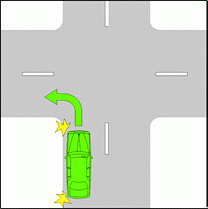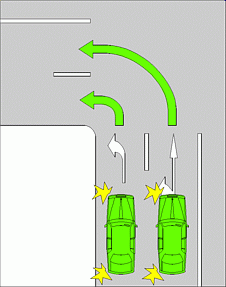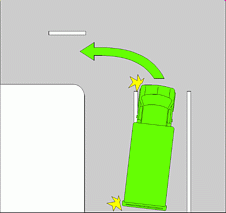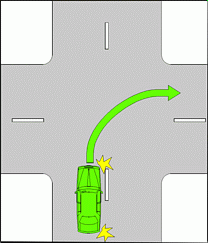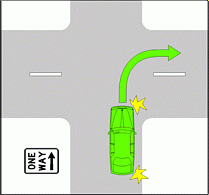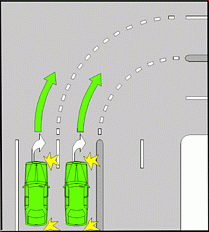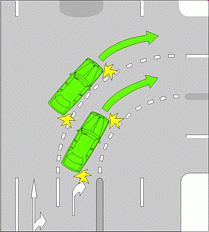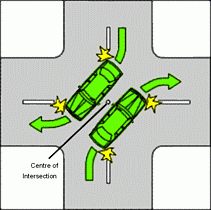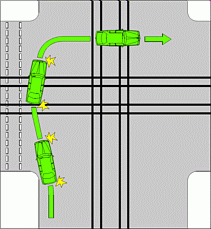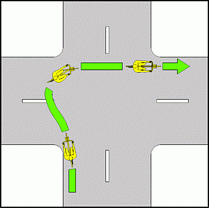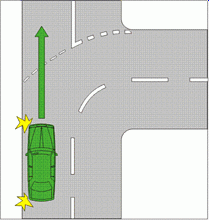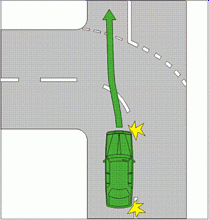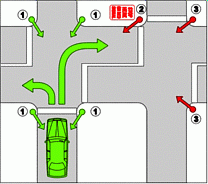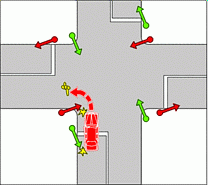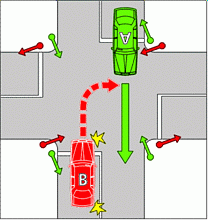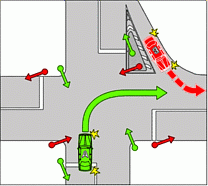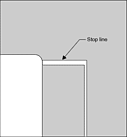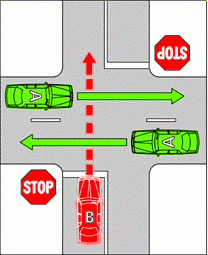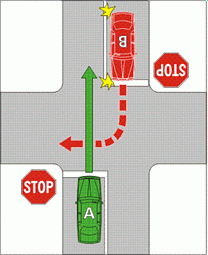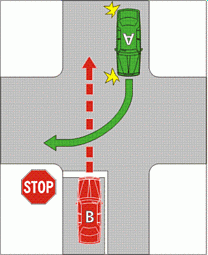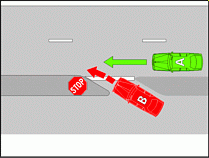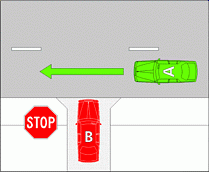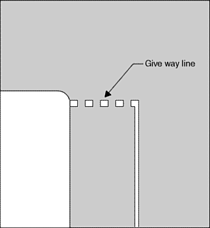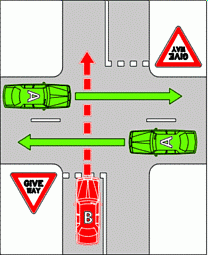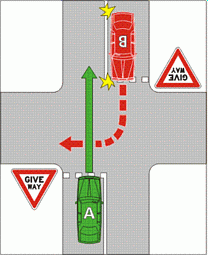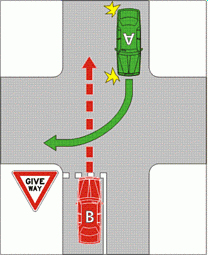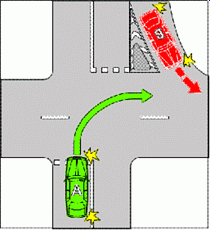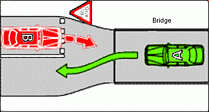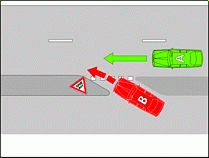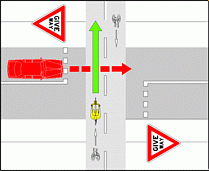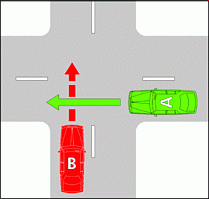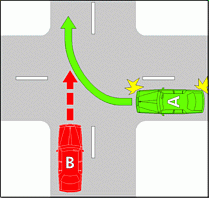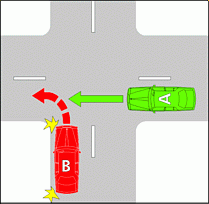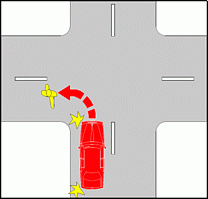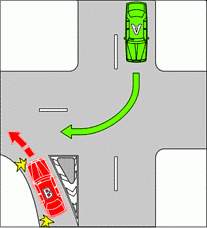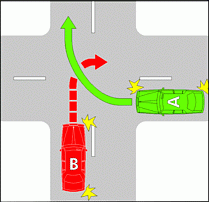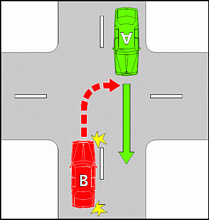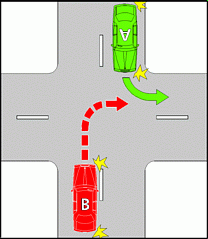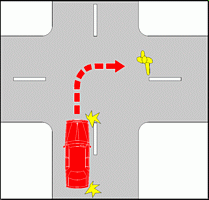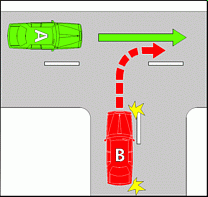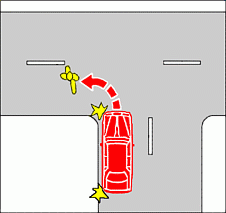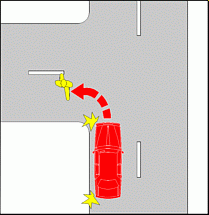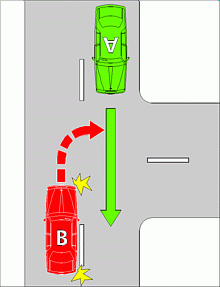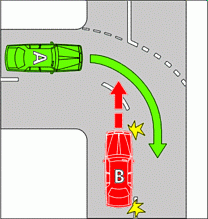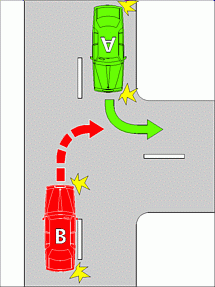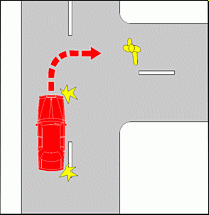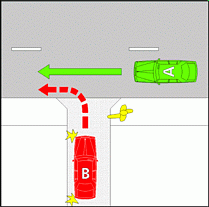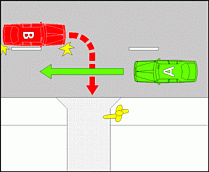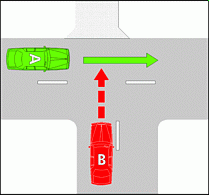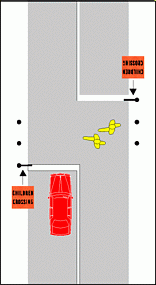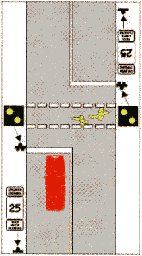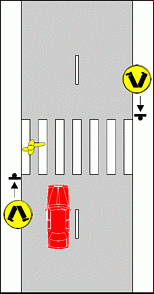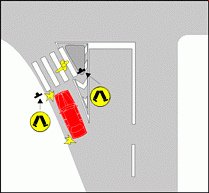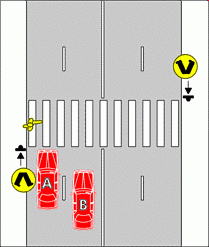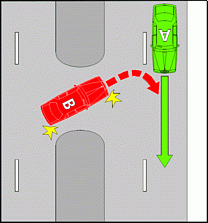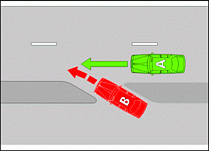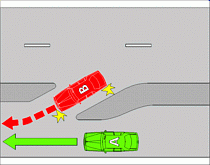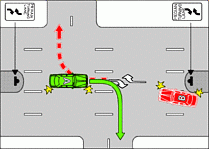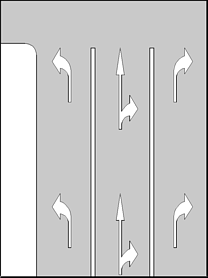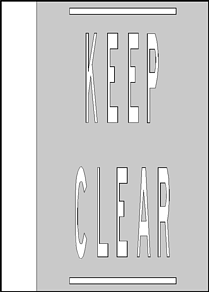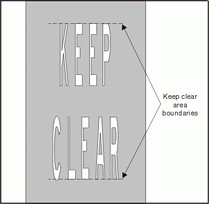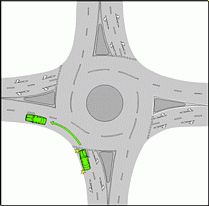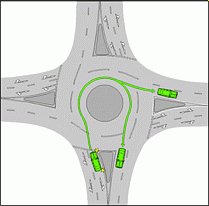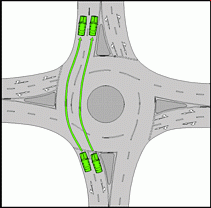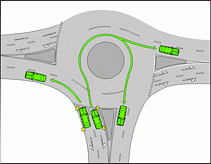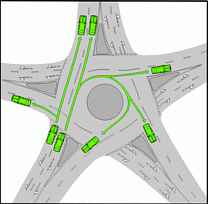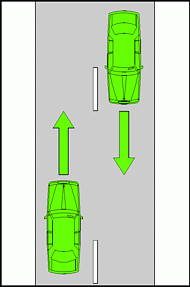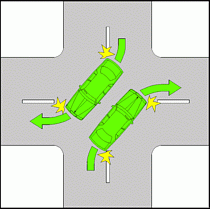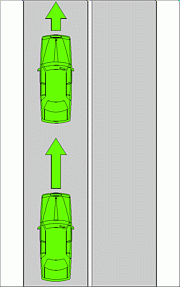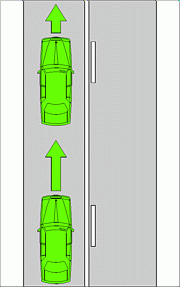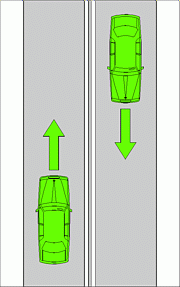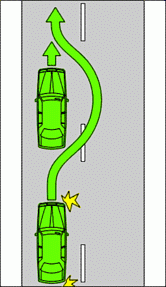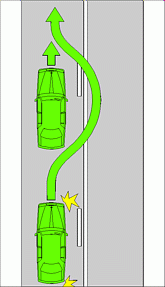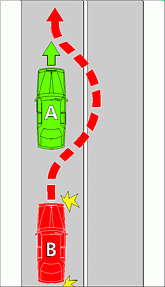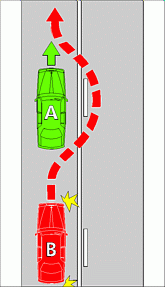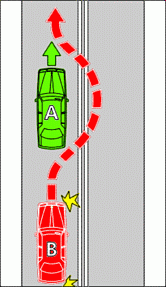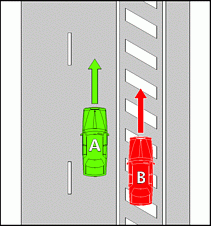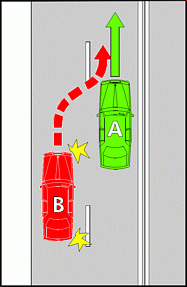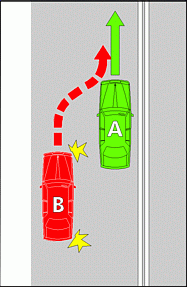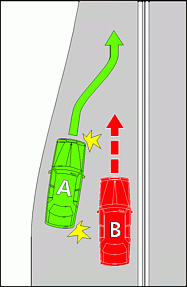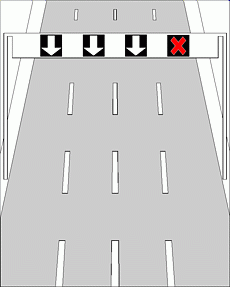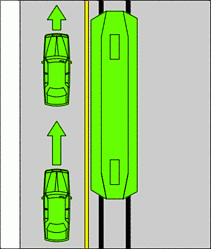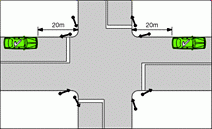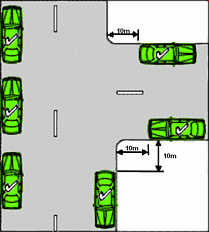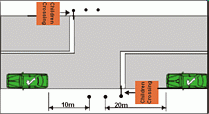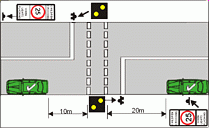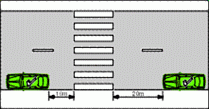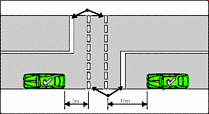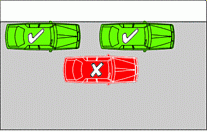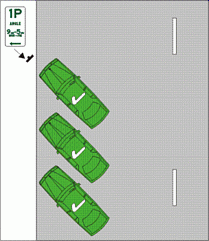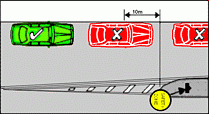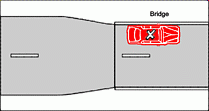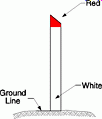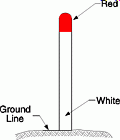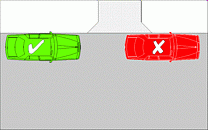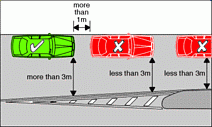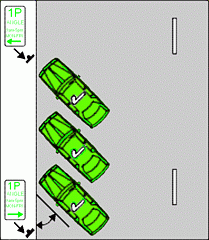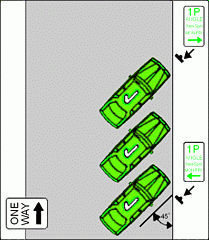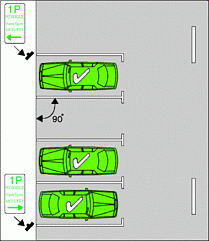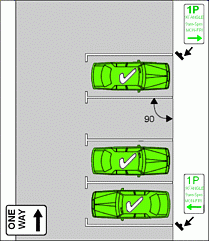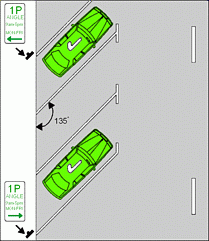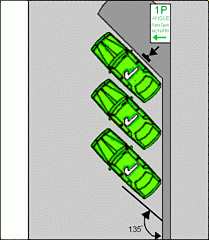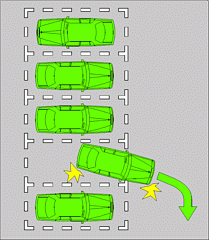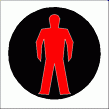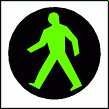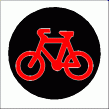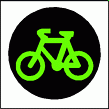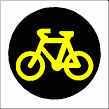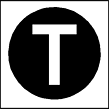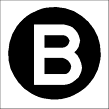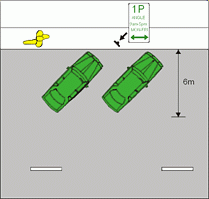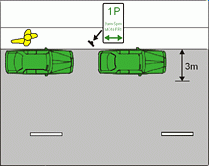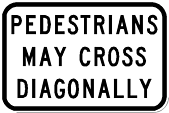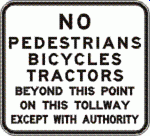Readers Guide
Introduction | The Road Rules ("the Rules") provide rules to be followed by all road users in this State. | The Rules are arranged in 24 Parts. | The Rules in Parts 1 to 21 are road rules that Tasmania has in common with other States and the Territories. They are part of a national scheme to provide uniform road traffic laws throughout Australia. | Some of the Rules, such as those relating to trams and hook turns, are not presently relevant to Tasmania but they have been included here to preserve the uniformity of the national scheme. | The rules in Part 22 are peculiar to, and apply only in, Tasmania. Although these local rules are not part of the national scheme, they have been included here so that Tasmania's road rules may be found in one place. | Other jurisdictions also have local road rules. If you visit another State or a Territory you must observe its local road rules as well as the national rules. | Part 23 deals with exemptions from the Rules and Part 24 provides for certain qualifying, explanatory and definitional matters. | Aim of the Guide | The aim of this Guide is to help you to understand the Rules and the way they apply to different kinds of roads, vehicles and road users. The Guide also gives information on the structure of the Rules. | As a matter of law the Guide is not part of the Rules. | How to use the Rules | 1. Contents and dictionary | The contents at the beginning of the Rules will help you to find particular rules or groups of rules that you may be interested in. They may also be helpful in giving you an overview of the structure of the Rules. | The dictionary at the end of the Rules defines words and expressions that have special meanings in the Rules. It includes words and expressions that are defined elsewhere in the Rules. | 2. Application of the rules and some key concepts | The application of the Rules and some key concepts are explained in Part 2 of the Rules. You will need to understand Part 2 to apply the Rules properly. | Roads and road-related areas | The Rules apply to vehicles, animals and persons on roads and ‘road-related areas’. ‘Road-related areas’ are areas like footpaths, nature strips and parking areas. The Rules generally apply to road-related areas in the same way as they apply to roads. | In the Rules, a reference to a ‘road’ generally includes road-related areas. If a particular rule does not apply to road-related areas, or applies only to road-related areas, this will be stated in the rule. | Drivers and riders | The Rules are generally expressed to apply to drivers of vehicles, since they are the largest category of road users. A driver is the person driving or otherwise in control of a vehicle. For example, a person steering and pushing a stalled motor vehicle would be in control of the vehicle and be the ‘driver’. | Persons riding, or otherwise in control of, motor bikes or animal-drawn vehicles, or riding bicycles or animals, are called ‘riders’, rather than drivers. The Rules generally apply to them in the same way as they apply to drivers. | In the Rules, a reference to a ‘driver’ generally includes a rider. If a particular rule does not apply to riders, or applies only to particular kinds of riders, this is stated in the rule. | The definition of a ‘vehicle’ (also in Part 2) is very broad and is not exhaustive. It includes, for example, motorised wheelchairs that can travel over 10 kilometres per hour. However, it does not include trains, wheeled recreational devices or wheeled toys. The driving of trains is not covered by the Rules. Riders of wheeled recreational devices and wheeled toys are treated as pedestrians. | Although most of the Rules apply to vehicles of all kinds and to both drivers and riders, there are some rules that apply only to particular drivers or riders. For example, the rules in Part 15 apply only to bicycle riders, and the rules in Part 17 apply only to the drivers of trams and public buses. | Pedestrians | It is not appropriate to apply the Rules to persons in control of some kinds of vehicles as if they were drivers of conventional motor vehicles. For this reason, some persons who might otherwise come within the definition of ‘driver’ are treated as pedestrians. For example, a person pushing a motorised wheelchair is treated as a pedestrian. | The rules that apply to pedestrians are in Part 14. | 3. Diagrams of traffic signs | Diagrams of all traffic signs mentioned in the Rules are shown in alphabetical order in Schedules 2 and 3 at the end of the Rules. The traffic signs in Schedule 2 are those in the relevant Australian Standard (AS 1742) as well as some existing non-standard signs in common use that will continue to be used and some new signs. The traffic signs in Schedule 3 are alternative signs still in use in one or more jurisdictions, but are being phased out. | Diagrams of signs have also been included after particular rules to help you identify the signs when reading the Rules. These diagrams may be a black and white version of the signs or may be printed in colour. | A number of traffic signs have 2 or more permitted versions. Notes to the diagrams of signs included in particular rules will tell you if there are other permitted versions of the signs or if the signs can have other permitted features. For example, there is more than one permitted version of a speed-limit sign. Also, a speed-limit sign can have a different number. Notes to the diagram of the sign in Part 3 will tell you about these things. | Diagrams (including diagrams that are examples) are part of the Rules. | 4. Notes and examples | Notes are used throughout the Rules. They may tell you that certain terms are defined (and where they are defined), draw your attention to other relevant rules, or help in other ways. The notes are not part of the Rules. | Examples are also given throughout the Rules, sometimes by explanation and sometimes by diagrams. They are not exhaustive. Examples are part of the Rules | 5. Structure and language | The following points may assist you in reading and understanding the Rules | Arrangement of rules | Rules have been grouped in Parts and Divisions so that rules on the same subject are, as far as possible, together. However, some kinds of rules are relevant in many different situations. For example, in addition to the general give way rules in Part 7, giving way at traffic lights is dealt with in Part 6 (which deals with traffic lights) and giving way at roundabouts is dealt with in Part 9 (which deals with roundabouts). This arrangement gives drivers a more complete picture of their obligations at traffic lights and roundabouts. | Notes at the beginning of a Part, or with an application provision, will tell you where other rules on the subject can be found. | Structure of rules | The Rules often deal with complex situations. For this reason the more complex rules set out, in order: | (a) the rule (that is what must, or must not, be done in the situation covered by the rule) | (b) the exceptions to the rule | (c) any other information needed for the application of the rule (for example, particular definitions). | This enables the reader to see the rule set out in the simplest and clearest way. | Exemptions | In addition to exceptions that may be set out in a rule, there are a number of general exemptions. In Part 19, for example, there are a number of general exemptions for police and emergency vehicles and for other vehicles and drivers in particular situations. | A number of rules provide for an exemption if the driver is ‘permitted’ to do something, or is ‘authorised’ or ‘exempt’, ‘under another law of this jurisdiction’. | Definitions included in a rule | Most definitions of words and expressions are given in the dictionary. However, some terms are defined in the text of a rule. This is done where the word or expression is used only in that rule and nowhere else in the Rules. In addition, some definitions, particularly of areas or lengths of road that are established by traffic signs or road markings, are complex or need diagrams to be fully understood. They are placed with the basic rule that deals with the area or length of road, so that the rule and the definition (with any accompanying diagrams) can be seen and understood together. For example, see the definitions of bicycle path and separated footpath in rule 239. This also means there is no need for diagrams of the signs to appear in the dictionary as well as at the end of the rule and in the Schedules. The definitions are, however, signposted in the dictionary at the end of the Rules. Notes are also included in relevant rules drawing attention to these definitions. | Use of the terms vehicle and road in a rule | Because of the way ‘driver’ is defined, it is generally not necessary to say ‘the driver of a vehicle’ or mention the driver’s vehicle in a rule. | In the same way, because the Rules apply only to roads and road-related areas, it is not generally necessary to say in a rule that something must, or must not, be done ‘on a road’, except where the kind of road, or the place on a road, is relevant to the rule or it is necessary to exclude road-related areas. | Use of the terms bus and public bus | If a rule is directed to the driver of a public bus, the term ‘public bus’ is used in the rule, and the rule applies only to public buses. For examples, see Part 17 (Additional rules for drivers of trams and public buses). However, if a rule directs a driver of any vehicle to take or not take some action in relation to a bus, the term ‘bus’ is used and the rule applies to buses of all kinds. This is because, although the rule is primarily intended to apply to public buses, a public bus may not be marked in a way that makes it distinguishable from a private bus, and it is preferable from the point of view of road safety that the driver treat any bus as a public bus. For examples see Part 11, Division 7 (Passing trams and safety zones). There are also some rules that refer specifically to the drivers of all buses. | Use of the term does not apply in relation to a rule | A rule may say that it does not apply to a driver of a particular kind, or in a particular situation. This does not mean, however, that another rule will not apply to the driver in the same situation. An example is rule 95 (Emergency stopping lane only signs). A bicycle rider does not commit an offence under rule 95 by riding in an emergency stopping lane, because the rule expressly states that it does not apply to bicycle riders. However, the rider may still commit an offence by riding in the emergency stopping lane if a no bicycles sign applies to the lane (see rule 252 (No bicycles signs and markings)). | Use of present tense for some actions | The rules may say that a driver ‘is turning’ at an intersection. The use of the present tense is intended to cover both the present and future aspects of the present tense. That is, it refers to a driver who is preparing to make the turn as well as a driver who is in the course of making the turn. The context will make this clear in the rule. | Obligation to give way | There are a number of rules requiring a driver to give way to another driver or a pedestrian. However, under the Rules the other driver or pedestrian does not have a ‘right’ of way. Indeed, in some situations, a number of drivers may be required to give way to each other, for example at an intersection with a stop sign or give way sign on more than one of the intersecting roads. Similarly, although a driver may be required to give way to a pedestrian, the pedestrian is required under rule 236 (1) not to cause a traffic hazard by moving into the driver’s path. | Offences and penalties | If a rule (or subrule) creates an offence, this is indicated by the inclusion of a penalty provision in the rule (or subrule). A person who breaches the rule (or subrule) commits an offence punishable by a penalty not exceeding the penalty specified in that provision. | Penalties can include a fine and, in some circumstances, disqualification from driving. Although the Rules are part of a national scheme to provide uniform road traffic laws throughout Australia, the penalty that may be imposed for an offence under Tasmania's Rules could be quite different to the penalty that may be imposed for the equivalent offence if committed in another jurisdiction. | Other aids to using and understanding the rules | Part 20 of the Rules explains how traffic signs, traffic signals, road markings and other traffic control devices on roads must comply with the Rules to be legally effective. The Part also explains the way traffic control devices apply to lengths of road and areas, and also to drivers and other road users. Traffic signs and signals generally apply to a person if they face the person, but there are exceptions. | Part 21 of the Rules contains a number of provisions to put certain legal issues beyond doubt. They enable the language and concepts in the Rules to be expressed more simply. | Other road laws | The Rules are not completely self-contained and need to be read with the associated laws of the State. | The Rules do not provide all the rules to be followed by road users. Other rules applying to road users are to be found in other laws. For example, other laws deal with drink-driving. Some of these other rules are indicated by notes in the Rules. |
Traffic (Road Rules) Regulations 1999
I, the Governor in and over the State of Tasmania and its Dependencies in the Commonwealth of Australia, acting with the advice of the Executive Council, make the following regulations under the Traffic Act 1925 .
29 November 1999G. S. M. GREEN
Governor
By His Excellency's Command,
P. A. LENNON
Minister for Infrastructure, Energy and Resources
PART 1 - Introductory
Division 1 - Road Rules
These regulations may be cited as the Traffic (Road Rules) Regulations 1999 or the Road Rules.
(1) Division 2 of Part 14 takes effect on 1 December 2000.(2) The remaining provisions of these regulations take effect on 1 December 1999.
The object of the Road Rules is to provide road rules in this jurisdiction that are essentially uniform with road rules elsewhere in Australia.
Division 2 - Some features of the Road Rules
4. Definitions: the dictionary, &c.
(1) The dictionary towards the end of the Road Rules defines certain words and expressions, and includes references to certain words and expressions defined elsewhere in the Rules (signpost definitions).
Example
The signpost definition "road related area see rule 13" means that the expression road-related area is defined in rule 13 of the Road Rules.
Note: The dictionary only includes a signpost definition for a word or expression if the word or expression is used in 2 or more rules of the Road Rules.
(2) The dictionary is part of the Road Rules.(3) A definition in the Road Rules applies to each use of the word or expression in the Rules, unless the contrary intention appears.
A diagram in the Road Rules is part of the Rules.
Note 1: If a diagram of a traffic control device, traffic-related item or symbol is in black and white in a rule of the Road Rules, the diagram may be a black and white version of the device, item or symbol - see rule 314. If so, the colour version of the device, item or symbol will be in Schedule 2 or 4 .
Note 2: A diagram may be an example - see rule 6 (1).
(1) An example (whether or not in the form of a diagram) in the Road Rules is part of the Rules.(2) If the Road Rules includes an example of the operation of a provision of the Rules –(a) the example is not exhaustive; and(b) the example does not limit, but may extend, the meaning of the provision.
A heading to a Part, Division, Schedule, rule or any other provision of the Road Rules is part of the Rules.
A note in the Road Rules is explanatory and is not part of the Rules.
The Reader’s Guide is not part of the Road Rules.
(1) The word "Penalty" in a rule of the Road Rules (or, if the rule has 2 or more subrules, in a subrule) indicates that a contravention of the rule (or subrule) is an offence.(2) The penalty for an offence is the penalty specified after that word.
PART 2 - Application of the Road Rules
Division 1 - Roads and road-related areas
11. Road Rules apply to vehicles and road users on roads and road-related areas
(1) The Road Rules apply to vehicles and road users on roads and road-related areas.(2) Each reference in the Road Rules (except in this Division) to a road includes a reference to a road-related area, unless otherwise expressly stated in the Rules.
Examples for subrule (2)
1. A reference in rule 146 (which deals with driving within a single marked lane or line of traffic) to the road includes a reference to the road-related area of the road.
2. A reference in rule 200(1) (which deals with certain heavy or long vehicles stopping on roads) to a length of road includes a reference to the road-related area of the length of road.
3. A reference in rule 31 (which deals with starting a right turn from a road, except a multi-lane road) to a road does not include a reference to a road-related area, because of the definition in subrule (5) of that rule.
(1) A road is an area that is open to or used by the public and is developed for, or has as one of its main uses, the driving or riding of motor vehicles.
Note: Motor vehicle is defined in the dictionary
(2) However, unless the contrary intention appears, a reference in the Road Rules (except in this Division) to a road does not include a reference to –(a) an area so far as the area is declared, under another law of this jurisdiction, not to be a road for the Road Rules; or(b) any shoulder of the road.(3) The shoulder of the road includes any part of the road that is not designed to be used by motor vehicles in travelling along the road, and includes –but does not include a bicycle path, footpath or shared path.(a) for a kerbed road – any part of the kerb; and(b) for a sealed road – any unsealed part of the road, and any sealed part of the road outside an edge line on the road –
13. What is a road-related area
(1) A road-related area is any of the following:(a) an area that divides a road;(b) a footpath or nature strip adjacent to a road;(c) an area that is not a road and that is open to the public and designated for use by cyclists or animals;(d) an area that is not a road and that is open to or used by the public for driving, riding or parking vehicles.
Note: Vehicle is defined in rule 15 .
(2) However, unless the contrary intention appears, a reference in the Road Rules (except in this Division) to a road-related area includes a reference to –but does not include a reference to an area so far as the area is declared, under another law of this jurisdiction, not to be a road-related area for the Road Rules.(a) an area so far as the area is declared, under another law of this jurisdiction, to be a road-related area for the Road Rules; or(b) any shoulder of a road; or(c) any other area that is a footpath or nature strip as defined in the dictionary –
Note: Shoulder is defined in rule 12 .
Division 2 - Road users and vehicles
A road user is a driver, rider, passenger or pedestrian.
A vehicle includes –but does not include another kind of wheelchair, a train, or a wheeled recreational device or wheeled toy.(a) a motor vehicle, trailer and tram; and(b) a bicycle; and(c) an animal-drawn vehicle, and an animal that is being ridden or drawing a vehicle; and(d) a combination; and(e) a motorised wheelchair that can travel at over 10 kilometres per hour (on level ground) –
Note: Various terms mentioned in this rule are defined in the dictionary.
(1) A driver is the person who is driving a vehicle (except a motor bike, bicycle, animal or animal-drawn vehicle).
Note 1: Bicycle and motor bike are defined in the dictionary, and vehicle is defined in rule 15 .
Note 2: Drive includes be in control of – see the definition in the dictionary.
(2) However, a driver does not include a person pushing a motorised wheelchair.
Note: Wheelchair is defined in the dictionary.
(1) A rider is the person who is riding a motor bike, bicycle, animal or animal-drawn vehicle.
Note 1: Bicycle and motor bike are defined in the dictionary.
Note 2: Ride, for the rider of a motor bike or animal-drawn vehicle, includes be in control of - see the definition in the dictionary.
(2) A rider does not include –(a) a passenger; or(b) a person walking beside and pushing a bicycle.
A pedestrian includes –(a) a person driving a motorised wheelchair that cannot travel at over 10 kilometres per hour (on level ground); and(b) a person in a non-motorised wheelchair; and(c) a person pushing a motorised or non-motorised wheelchair; and(d) a person in or on a wheeled recreational device or wheeled toy.
Note: Wheelchair, wheeled recreational device and wheeled toy are defined in the dictionary.
19. References to driver includes rider, &c.
Unless otherwise expressly stated in the Road Rules, each reference in the Rules (except in this Division) to a driver includes a reference to a rider, and each reference in the Rules (except in this Division) to driving includes a reference to riding.
PART 3 - Speed-limits
A driver must not drive at a speed over the speed-limit applying to the driver for the length of road where the driver is driving.
Penalty: Fine not exceeding 20 penalty units.
Note 1: The rules about speed-limits are as follows:
rule 21 - speed-limit where a speed-limit sign applies
rule 22 - speed-limit in a speed-limited area
rule 23 - speed-limit in a school zone
rule 24 - speed-limit in a shared zone
rule 25 - speed-limit elsewhere.
Note 2: Road includes a road-related area – see rule 11(2) .
Note 3: Length of road includes a marked lane, a part of a marked lane, or another part of a length of road – see the definition in the dictionary.
Note 4: Division 2 of Part 20 deals with the way in which a traffic sign applies to a length of road. Division 3 of Part 20 deals with the way in which the traffic sign applies to drivers driving on the length of road.
Note 5: If a driver contravenes this rule by driving at a speed that is 38km/h or more over the applicable speed-limit, additional penalties may apply - see Division 5 of Part 3 of the Vehicle and Traffic Act 1999.
21. Speed-limit where a speed-limit sign applies
(1) The speed-limit applying to a driver for a length of road to which a speed-limit sign applies is the number of kilometres per hour indicated by the number on the sign.
Note: Length of road is defined in the dictionary.
(2) However, if the number on the speed-limit sign is over 100 and the driver is driving a bus with a GVM over 5 tonnes, or another vehicle with a GVM over 12 tonnes, the speed-limit applying to the driver for the length of road is 100 kilometres per hour.
Note 1: Bus and GVM are defined in the dictionary and vehicle is defined in rule 15 :
Note 2: Five tonnes is specified for the definition of heavy omnibus in the Australian Design Rules issued under the Motor Vehicle Standards Act 1989 of the Commonwealth.
Note 3: If the vehicle is an oversize or overmass vehicle, the vehicle may be restricted to a lower speed-limit under another law of this jurisdiction.
(3) A speed-limit sign on a road applies to the length of road beginning at the sign and ending at the nearest of the following:(a) a speed-limit sign on the road with a different number on the sign;(b) an end speed-limit sign or speed derestriction sign on the road;(c) if the road ends at a T-intersection or dead end – the end of the road.
Note 1: T-intersection is defined in the dictionary.
Note 2: Rule 322(1) and (2) deal with the meaning of a traffic sign on a road.
Speed-limit signs
Other signs
Note 1 for diagrams: There is another permitted version of the speed-limit sign and the end speed-limit sign – see the diagrams in Schedule 3 .
Note 2 for diagrams: A speed-limit sign or end speed-limit sign may have a different number on the sign - see rule rule 316(4) .
22. Speed-limit in a speed-limited area
(1) The speed-limit applying to a driver for any length of road in a speed-limited area is the number of kilometres per hour indicated by the number on the area speed-limit sign on a road into the area, unless another speed-limit applies to the driver for the length of road under another rule of this Part.
Examples of another speed-limit
Although an area speed-limit sign on a road into a speed-limited area may indicate a speed-limit of 60 kilometres per hour, a particular length of road in the area may have a school zone sign indicating a 40 kilometres per hour speed-limit for that length of road.
Note: Length of road is defined in the dictionary.
(2) A speed-limited area is the network of roads in an area with –(a) an area speed-limit sign on each road into the area, indicating the same number; and(b) an end area speed-limit sign on each road out of the area.(3) In subrule (2)(a) and (b) ,road does not include a road-related area.
Note: Road-related area is defined in rule 13 .
Note 1 for diagrams: There are a number of other permitted versions of each of these signs – see the diagrams in Schedule 3 .
Note 2 for diagrams: An area speed-limit sign or end area speed-limit sign may have a different number on the sign – see rule 316(4) .
23. Speed-limit in a school zone
(1) The speed-limit applying to a driver for any length of road in a school zone is the number of kilometres per hour indicated by the number on the school zone sign on a road, or the road, into the zone.
Note 1: Length of road is defined in the dictionary.
Note 2: A school zone sign may indicate that it applies only at certain times, on certain days or in certain circumstances – see rules 317 and 318 .
Note 3: This subrule applies to road-related areas in the school zone - see rule 11(2) .
(2) A school zone is –(a) if there is a school zone sign and an end school zone sign, or a speed-limit sign with a different number on the sign, on a road and there is no intersection on the length of road between the signs – that length of road; or(b) if there is a school zone sign on a road that ends in a dead end and there is no intersection, nor a sign mentioned in paragraph (a) , on the length of road beginning at the sign and ending at the dead end – that length of road; or(c) in any other case – the network of roads in an area with –(i) a school zone sign on each road into the area, indicating the same number; and(ii) an end school zone sign, or a speed-limit sign indicating a different number, on each road out of the area.
Note: Intersection is defined in the dictionary.
(3) In subrule (2)(c)(i) and (ii) ,road does not include a road-related area.
Note: Road-related area is defined in rule 13 .
Note 1 for diagrams: There are a number of other permitted versions of each of these signs – see the diagrams in Schedule 3 .
Note 2 for diagrams: A school zone sign or end school zone sign may have a different number on the sign – see rule 316(4) .
24. Speed-limit in a shared zone
(1) The speed-limit applying to a driver for any length of road in a shared zone is the number of kilometres per hour indicated by the number on the shared zone sign on a road into the zone.
Note: A driver driving in a shared zone must give way to any pedestrian in the zone – see rule 83 .
(2) A shared zone is the network of roads in an area with –(a) a shared zone sign on each road into the area, indicating the same number; and(b) an end shared zone sign on each road out of the area.(3) In subrule (2)(a) and (b) ,road does not include a road-related area.
Note: Road-related area is defined in rule 13 .
Note 1 for diagrams: There are a number of other permitted versions of each of these signs - see the diagrams in Schedule 3 .
Note 2 for diagrams: A shared zone sign may have a different number on the sign - see rule rule 316(4) .
(1) If a speed-limit sign does not apply to a length of road and the length of road is not in a speed-limited area, school zone or shared zone, the speed-limit applying to a driver for the length of road is the default speed-limit.(2) The default speed-limit applying to a driver for a length of road in a built-up area is 60 kilometres per hour.
Note: Built-up area is defined in the dictionary.
(3) The default speed-limit applying to a driver for any other length of road is –(a) for a driver driving a bus with a GVM over 5 tonnes, or another vehicle with a GVM over 12 tonnes – 100 kilometres per hour; or(b) for any other driver – 100 kilometres per hour or as otherwise provided under another law of this jurisdiction.
Note 1: Bus and GVM are defined in the dictionary, and vehicle is defined in rule 15 .
Note 2: Five tonnes is specified for the definition of heavy omnibus in the Australian Design Rules issued under the Motor Vehicle Standards Act 1989 of the Commonwealth.
Note 3: If the vehicle is an oversize or overmass vehicle, the vehicle may be restricted to a lower speed-limit under another law of this jurisdiction.
PART 4 - Making turns
Division 1 - Left turns at intersections
26. Division does not apply to certain turns
(1) This Division does not apply to –(a) a driver turning from a road into a road-related area or adjacent land, or from a road-related area into a road; or(b) a driver entering or leaving a roundabout.(2) In this rule,road does not include a road-related area.
Note 1: Adjacent land is defined in the dictionary, road-related area is defined in rule 13 , and roundabout is defined in rule 109 .
Note 2: Division 5 of this Part deals with turning into or from a road-related area or adjacent land, and Part 9 deals with entering and leaving a roundabout.
Note 3: For the meaning of left, see rule 351(1) .
27. Starting a left turn from a road (except a multi-lane road)
(1) A driver turning left at an intersection from a road (except a multi-lane road) must approach and enter the intersection from as near as practicable to the far left side of the road.Penalty: Fine not exceeding 10 penalty units.(2) In this rule,road does not include a road-related area.
Note 1: Intersection and multi-lane road are defined in the dictionary.
Note 2: Road-related area includes any shoulder of a road – see rule 13 .
Example
28. Starting a left turn from a multi-lane road
(1) A driver turning left at an intersection from a multi-lane road must approach and enter the intersection from within the left lane unless –(a) the driver is required or permitted to approach and enter the intersection from within another marked lane under rule 88(1) , rule 92 or rule 159 ; or(b) the driver is turning, at B lights or traffic arrows, in accordance with Division 2 of Part 17 ; or(c) subrule (2) applies to the driver.
Penalty: Fine not exceeding 5 penalty units.
Note 1: B lights, intersection, marked lane, multi-lane road, public bus and traffic arrows are defined in the dictionary, and left lane is defined in subrule (3) .
Note 2: Rule 88(1) deals with left turn only signs, rule 92 deals with traffic lane arrows, and rule 159 deals with traffic signs requiring particular kinds of vehicles to drive in an indicated marked lane.
Note 3: Division 2 of Part 17 provides for priority to be given to public buses at intersections with B lights or a white traffic arrow.
Example for subrule (1)(a)
(2) A driver may approach and enter the intersection from the marked lane next to the left lane as well as, or instead of, the left lane if –(a) the driver’s vehicle, together with any load or projection, is 7.5 metres long, or longer; and(b) the vehicle displays a do not overtake turning vehicle sign; and(c) any part of the vehicle is within 50 metres of the nearest point of the intersection; and(d) it is not practicable for the driver to turn left from within the left lane; and(e) the driver can safely occupy the next marked lane and can safely turn left at the intersection by occupying the next marked lane, or both lanes.
Note 1: Driver's vehicle is defined in the dictionary.
Note 2: Vehicle includes a combination – see rule 15(d) .
Note 3: Under the law of this jurisdiction, only certain long vehicles may display a do not overtake turning vehicle sign.
Example
(3) In this rule –left lane means –(a) the marked lane nearest to the far left side of the road; or(b) if there is an obstruction (for example, a parked car or roadworks) in that marked lane – the marked lane nearest to that marked lane that is not obstructed.marked lane, for a driver, does not include a special purpose lane in which the driver is not permitted to drive.
Note 1: Obstruction and special purpose lane are defined in the dictionary.
Note 2: Rule 95 deals with driving in an emergency stopping lane and Division 6 of Part 11 deals with driving in other special purpose lanes.
Note for diagrams: These signs are displayed on certain long vehicles.
29. Making a left turn as indicated by a road marking
If a driver is turning left at an intersection and there is a road marking indicating how the turn is required to be made, the driver must make the turn as indicated by the road marking.
Penalty: Fine not exceeding 10 penalty units.
Note: Intersection and road marking are defined in the dictionary.
Example
Division 2 - Right turns (except hook turns) at intersections
30. Division does not apply to certain turns
(1) This Division does not apply to –(a) a driver turning right at an intersection where there is a hook turn only sign; or(b) the rider of a bicycle making a hook turn under Division 3; or(c) a driver turning from a road into a road-related area or adjacent land, or from a road-related area into a road; or(d) a driver making a U-turn; or(e) a driver entering or leaving a roundabout.(2) In subrule (1)(c) ,road does not include a road-related area.
Note 1: Adjacent land, bicycle, intersection and U-turn are defined in the dictionary, road-related area is defined in rule 13 , and roundabout is defined in rule 109 .
Note 2: Division 3 of this Part deals with hook turns, Division 4 deals with U-turns, Division 5 deals with turns into or from a road-related area or adjacent land, and Part 9 deals with entering and leaving a roundabout.
Note 3: For the meaning of right, see rule 351(2) .
31. Starting a right turn from a road (except a multi-lane road)
(1) A driver turning right at an intersection from a road (except a multi-lane road) must approach and enter the intersection in accordance with this rule.
Penalty: Fine not exceeding 10 penalty units.
Note 1: Intersection and multi-lane road are defined in the dictionary.
(2) If the road has a dividing line or median strip, the driver must approach and enter the intersection from the left of, parallel to, and as near as practicable to, the dividing line or median strip.
Note 1: Dividing line and median strip are defined in the dictionary.
(3) If the road does not have a dividing line or median strip and is not a one-way road, the driver must approach and enter the intersection from the left of, parallel to, and as near as practicable to, the centre of the road.
Note 1: Centre of the road and one-way road are defined in the dictionary.
(4) If the road is a one-way road, the driver must approach and enter the intersection from as near as practicable to the far right side of the road.(5) In this rule,road does not include a road-related area.
Note: Road-related area includes any shoulder of a road – see rule 13 .
Examples
Example 1
Example 2
32. Starting a right turn from a multi-lane road
(1) A driver turning right at an intersection from a multi-lane road must approach and enter the intersection from within the right lane unless –(a) the driver is required or permitted to approach and enter the intersection from within another marked lane in accordance with rule 89(1) or rule 92 or 159 ; or(b) the driver is turning, at B lights or traffic arrows, in accordance with Division 2 of Part 17 ; or(c) subrule (2) applies to the driver.
Penalty: Fine not exceeding 10 penalty units.
Note 1: B lights, intersection, marked lane, multi-lane road, public bus and traffic arrows are defined in the dictionary, and right lane is defined in subrule (3) .
Note 2: Rule 89(1) deals with right turn only signs, rule 92 deals with traffic lane arrows, and rule 159 deals with traffic signs requiring particular kinds of vehicles to drive in an indicated marked lane.
Note 3: Division 2 of Part 17 provides for priority to be given to public buses at intersections with B lights or a white traffic arrow.
Example for subrule (1)(a)
(2) A driver may approach and enter the intersection from the marked lane next to the right lane as well as, or instead of, the right lane if –(a) the driver’s vehicle, together with any load or projection, is 7.5 metres long, or longer; and(b) the vehicle displays a do not overtake turning vehicle sign; and(c) any part of the vehicle is within 50 metres of the nearest point of the intersection; and(d) it is not practicable for the driver to turn right from within the right lane; and(e) the driver can safely occupy the next marked lane and can safely turn right at the intersection by occupying the next marked lane, or both lanes.
Note 1: Driver's vehicle is defined in the dictionary.
Note 2: Vehicle includes a combination – see rule 15(d)
Note 3: Under the law of this jurisdiction, only certain long vehicles may display a do not overtake turning vehicle sign.
(3) In this rule –marked lane, for a driver, does not include a special purpose lane in which the driver is not permitted to drive;right lane means –(a) the marked lane nearest to the dividing line or median strip on the road; or(b) if there is an obstruction (for example, a parked car or roadworks) in that marked lane – the marked lane nearest to that marked lane that is not obstructed.
Note 1: Dividing line, median strip, obstruction and special purpose lane are defined in the dictionary.
Note 2: Rule 95 deals with driving in an emergency stopping lane and Division 6 of Part 11 deals with driving in other special purpose lanes.
Note for diagrams: These signs are displayed on certain long vehicles.
(1) A driver turning right at an intersection (except a T-intersection) must make the turn in accordance with this rule.
Penalty: Fine not exceeding 10 penalty units.
Note: Intersection and T-intersection are defined in the dictionary.
(2) If there is a road marking indicating how the turn is required to be made, the driver must make the turn as indicated by the road marking.
Note: Road marking is defined in the dictionary.
(3) If there is no road marking indicating how the turn is required to be made, the driver must make the turn so the driver passes as near as practicable to the right of the centre of the intersection.
Examples
Example 1
Example 2
Division 3 - Hook turns at intersections
34. Making a hook turn at a hook turn only sign
(1) A driver turning right at an intersection with traffic lights and a hook turn only sign must turn right by making a hook turn in accordance with this rule.
Penalty: Fine not exceeding 5 penalty units.
Note: Intersection and traffic lights are defined in the dictionary.
(2) To make a hook turn, the driver must take, in sequence, each of the following steps:
1. Approach and enter the intersection from as near as practicable to the far left side of the road that the driver is leaving.
2. Move forward, keeping as near as practicable to the left of the intersection and clear of any marked foot crossing, until the driver is as near as practicable to the far side of the road that the driver is entering.
3. Remain at the position reached under step 2 until the traffic lights on the road that the driver is entering change to green.
4. Turn right into that road.
Note: Marked foot crossing is defined in the dictionary.
(3) In this rule,road does not include a road-related area.
Note: Road-related area is defined in rule 13 .
Example
35. Optional hook turn by a bicycle rider
(1) The rider of a bicycle turning right at an intersection without a hook turn only sign, or a no hook turn by bicycles sign, may turn right at the intersection by making a right turn under Division 2 or a hook turn under this rule.
Note: Bicycle and intersection are defined in the dictionary.
(2) The rider must make a hook turn under this rule in accordance with subrule (3) .Penalty: Fine not exceeding 5 penalty units.(3) To make a hook turn under this rule, the rider must take, in sequence, each of the following steps:
1. Approach and enter the intersection from as near as practicable to the far left side of the road that the rider is leaving.
2. Move forward –
(a) keeping as near as practicable to the far left side of the intersection; and
(b) keeping clear of any marked foot crossing; and
(c) keeping clear, as far as practicable, of any driver turning left from the left of the intersection –
until the rider is as near as practicable to the far side of the road that the rider is entering.
3. If there are traffic lights at the intersection, remain at the position reached under step 2 until the traffic lights on the road that the rider is entering change to green.
4. If there are no traffic lights at the intersection, remain at the position reached under step 2 until the rider has given way to approaching drivers on the road that the rider is leaving.
5. Turn right into the road that the rider is entering.
Note: Approaching and marked foot crossing are defined in the dictionary.
Example
36. Bicycle rider making a hook turn contrary to no hook turn by bicycles sign
The rider of a bicycle must not make a hook turn at an intersection that has a no hook turn by bicycles sign.
Penalty: Fine not exceeding 5 penalty units.
Note: Bicycle and intersection are defined in the dictionary.
Division 4 - U-turns
NoteU-turn is defined in the dictionary.
A driver must not begin a U-turn unless –(a) the driver has a clear view of any approaching traffic; and(b) the driver can safely make the U-turn without unreasonably obstructing the free movement of traffic.
Penalty: Fine not exceeding 10 penalty units.
Note 1: Approaching traffic means traffic approaching from any direction - see the definition in the dictionary.
Note 2: Traffic is defined in the dictionary.
38. Giving way when making a U-turn
A driver making a U-turn must give way to all vehicles and pedestrians.
Penalty: Fine not exceeding 10 penalty units.
Note: For this rule, give way means the driver must slow down and, if necessary stop, to avoid a collision - see the definition in the dictionary.
39. Making a U-turn contrary to a no U-turn sign
(1) A driver must not make a U-turn at a break in a dividing strip on a road if there is a no U-turn sign at the break in the dividing strip.
Penalty: Fine not exceeding 5 penalty units.
Note 1: Dividing strip is defined in the dictionary.
Note 2: Rule 322(5) and (6) deal with the meaning of a traffic sign at a break in a dividing strip.
Note 3: Traffic is defined in the dictionary.
(2) A driver must not make a U-turn on a length of road to which a no U-turn sign applies.
Penalty: Fine not exceeding 5 penalty units.
Note: Length of road is defined in the dictionary.
(3) A no U-turn sign on a road (except a no U-turn sign at an intersection or at a break in a dividing strip) applies to the length of road beginning at the sign and ending at the nearer of the following:(a) the next intersection on the road;(b) if the road ends at a T-intersection or dead end – the end of the road.
Note 1: Intersection and T-intersection are defined in the dictionary.
Note 2: Rule 322(1) and (2) deal with the meaning of a traffic sign on a road.
No U-turn signs
Note for diagrams: There is another permitted version of each of these U-turn signs – see the diagrams in Schedule 3 .
40. Making a U-turn at an intersection with traffic lights
A driver must not make a U-turn at an intersection with traffic lights unless there is a U-turn permitted sign at the intersection.
Penalty: Fine not exceeding 5 penalty units.
Note: Intersection and traffic lights are defined in the dictionary.
41. Making a U-turn at an intersection without traffic lights
A driver must not make a U-turn at an intersection without traffic lights if there is a no U-turn sign at the intersection.
Penalty: Fine not exceeding 5 penalty units.
Note 1: Intersection and traffic lights are defined in the dictionary.
Note 2: U-turns are permitted at intersections without traffic lights unless there is a no U-turn sign, even though traffic lane arrows indicate that the driver must or may turn right - see rule 92 .
42. Starting a U-turn at an intersection
A driver making a U-turn at an intersection must start the U-turn –(a) if the road where the driver is turning has a dividing line or median strip – from the marked lane nearest, or as near as practicable, to the dividing line or median strip; or(b) in any other case – from the left of the centre of the road.
Penalty: Fine not exceeding 5 penalty units.
Note: Centre of the road, dividing line, intersection, marked lane and median strip are defined in the dictionary.
Example
Division 5 - Turns into or from road-related areas or adjacent land
(1) A driver turning left from a road into a road-related area or adjacent land, or from a road-related area into a road, must comply with Division 1 as if the driver were turning left at an intersection.
Penalty: Fine not exceeding 10 penalty units.
Note 1: Adjacent land is defined in the dictionary, and road-related area is defined in rule 13 . Adjacent land or a road-related area can include a driveway, service station or shopping centre - see the definitions. Some shopping centres may include roads - see the definition of road in rule 12 .
Note 2: For the meaning of left and right, see rule 351(1) and (2) .
(2) A driver turning right from a road into a road-related area or adjacent land, or from a road-related area into a road, must comply with Division 2 as if the driver were turning right at an intersection.Penalty: Fine not exceeding 10 penalty units.(3) In this rule,road does not include a road-related area.
Note 1: A road-related area includes the shoulder of a road - see rule 13 .
Note 2: Rule 74 deals with the give way rules applying to a driver entering a road from a road-related area or adjacent land, and rule 75 deals with the give way rules applying to a driver entering a road-related area or adjacent land from a road.
Note 3: Rule 212 deals with a driver entering and leaving a median strip parking area.
PART 5 - Change of direction and stop signals
Division 1 - Change of direction signals
44. Division does not apply to entering or leaving a roundabout
This Division does not apply to a driver entering, in or leaving a roundabout.
Note: Part 9 deals with giving change of direction signals when entering or leaving a roundabout.
45. What is changing direction
(1) A driver changes direction if the driver changes direction to the left or the driver changes direction to the right.(2) A driver changes direction to the left by doing any of the following:(a) turning left;(b) changing marked lanes to the left;(c) diverging to the left;(d) entering a marked lane, or a line of traffic, to the left;(e) moving to the left from a stationary position;(f) turning left into a marked lane, or a line of traffic, from a median strip parking area;(g) at a T-intersection where the continuing road curves to the right – leaving the continuing road to proceed straight ahead onto the terminating road.
Note 1: Marked lane and median strip parking area are defined in the dictionary.
Note 2: For the meaning of left, see rule 351(1) .
(3) A driver changes direction to the right by doing any of the following:(a) turning right;(b) changing marked lanes to the right;(c) diverging to the right;(d) entering a marked lane, or a line of traffic, to the right;(e) moving to the right from a stationary position;(f) turning right into a marked lane, or a line of traffic, from a median strip parking area;(g) making a U-turn;(h) at a T-intersection where the continuing road curves to the left – leaving the continuing road to proceed straight ahead onto the terminating road.
Note 1: U-turn is defined in the dictionary.
Note 2: For the meaning of right, see rule 351(2) .
Examples for subrules 2(g) and (3)(h)
Example 1
Example 2
46. Giving a left change of direction signal
(1) Before a driver changes direction to the left, the driver must give a left change of direction signal in accordance with rule 47 for long enough to comply with subrule (2) and, if subrule (3) applies to the driver, that subrule.
Penalty: Fine not exceeding 5 penalty units.
Note: Changes direction to the left is defined in rule 45(2) .
(2) The driver must give the change of direction signal for long enough to give sufficient warning to other drivers and pedestrians.(3) If the driver is about to change direction by moving from a stationary position at the side of the road or in a median strip parking area, the driver must give the change of direction signal for at least 5 seconds before the driver changes direction.
Note: Median strip parking area is defined in the dictionary.
(4) The driver must stop giving the change of direction signal as soon as the driver completes the change of direction.Penalty: Fine not exceeding 5 penalty units.(5) This rule does not apply to a driver if the driver’s vehicle is not fitted with direction indicator lights.
Note: Driver's vehicle is defined in the dictionary.
47. How to give a left change of direction signal
The driver of a vehicle must give a left change of direction signal by operating the vehicle’s left direction indicator lights.
48. Giving a right change of direction signal
(1) Before a driver changes direction to the right, the driver must give a right change of direction signal in accordance with rule 49 for long enough to comply with subrule (2) and, if subrule (3) applies to the driver, that subrule.
Penalty: Fine not exceeding 5 penalty units.
Note: Changes direction to the right is defined in rule 45(3) .
(2) The driver must give the change of direction signal for long enough to give sufficient warning to other drivers and pedestrians.(3) If the driver is about to change direction by moving from a stationary position at the side of the road or in a median strip parking area, the driver must give the change of direction signal for at least 5 seconds before the driver changes direction.
Note: Median strip parking area is defined in the dictionary.
(4) The driver must stop giving the change of direction signal as soon as the driver completes the change of direction.Penalty: Fine not exceeding 5 penalty units.(5) This rule does not apply to –(a) the driver of a tram that is not fitted with direction indicator lights; or(b) the rider of a bicycle making a hook turn.
49. How to give a right change of direction signal
(1) The driver of a vehicle must give a right change of direction signal by operating the vehicle’s right direction indicator lights.(2) However, if the vehicle’s direction indicator lights are not in working order or are not clearly visible, or the vehicle is not fitted with direction indicator lights, the driver must give the change of direction signal by giving a hand signal in accordance with rule 50 , or using a mechanical signalling device fitted to the vehicle.
Note: Mechanical signalling device is defined in the dictionary.
50. How to give a right change of direction signal by giving a hand signal
To give a hand signal for changing direction to the right, the driver must extend the right arm and hand horizontally and at right angles from the right side of the vehicle, with the hand open and the palm facing the direction of travel.
Example
51. When use of direction indicator lights permitted
The driver of a vehicle must not operate a direction indicator light except –(a) to give a change of direction signal when the driver is required to give the signal under the Road Rules; or(b) as part of the vehicle’s hazard warning lights.
Penalty: Fine not exceeding 5 penalty units.
Note: Rule 221 deals with the use of hazard warning lights.
Division 2 - Stop signals
52. Division does not apply to bicycle riders or certain tram drivers
This Division does not apply to the rider of a bicycle, or the driver of a tram that is not fitted with brake lights.
Note: Bicycle and tram are defined in the dictionary.
(1) A driver must give a stop signal in accordance with rule 54 before stopping or when suddenly slowing.Penalty: Fine not exceeding 5 penalty units.(2) If the driver is stopping, the driver must give the stop signal for long enough to give sufficient warning to other road users.Penalty: Fine not exceeding 5 penalty units.(3) If the driver is slowing suddenly, the driver must give the stop signal while slowing.Penalty: Fine not exceeding 5 penalty units.
(1) The driver of a vehicle must give a stop signal by means of the vehicle’s brake lights.(2) However, if the vehicle’s brake lights are not in working order or are not clearly visible, or the vehicle is not fitted with brake lights, the driver must give the stop signal by giving a hand signal in accordance with rule 55 , or using a mechanical signalling device fitted to the vehicle.
Note: Mechanical signalling device is defined in the dictionary.
55. How to give a stop signal by giving a hand signal
(1) To give a hand signal for stopping or suddenly slowing, the driver must extend the right arm and hand at right angles from the right side of the vehicle, with the upper arm horizontal and the forearm and hand pointing upwards, and with the hand open and the palm facing the direction of travel.(2) However, the rider of a motor bike may give the hand signal by extending the left arm and hand at right angles from the left side of the motor bike, with the upper arm horizontal and the forearm and hand pointing upwards, and with the hand open and the palm facing the direction of travel.
Note: Motor bike is defined in the dictionary.
Example
PART 6 - Traffic lights and twin red lights
Division 1 - Obeying traffic lights
Note 1Traffic arrows and traffic lights are defined in the dictionary. Traffic arrows are a traffic control device installed with traffic lights that are designed to show a traffic arrow, or 2 or more traffic arrows at different times – see the definition in the dictionary.
Note 2A reference in a rule of this Part to a green, yellow or red traffic light or traffic arrow is a reference to a steady green, yellow or red traffic light or traffic arrow, unless otherwise stated in the rule – see rule 323 .
Note 3The rules dealing with T lights and B lights, which apply to drivers of trams and public buses, are in Part 17 .
56. Stopping for a red traffic light or arrow
(1) A driver approaching or at traffic lights showing a red traffic light must stop –(a) if there is a stop line at or near the traffic lights – as near as practicable to, but before reaching, the stop line; or(b) if there is a stop here on red signal sign at or near the traffic lights, but no stop line – as near as practicable to, but before reaching, the sign; or(c) if there is no stop line or stop here on red signal sign at or near the traffic lights – as near as practicable to, but before reaching, the nearest or only traffic lights.
Penalty: Fine not exceeding 10 penalty units.
Note: Red traffic light and stop line are defined in the dictionary.
Example for subrule (1)(b)
Example
In this example, the driver may go straight ahead, or turn right or left, if there is a green traffic light showing at 1. However, the driver must not go beyond the stop line or stop here on red signal sign at 2, if there is a red traffic light showing on the road the driver is entering (see 3).
(2) A driver approaching or at traffic arrows showing a red traffic arrow who is turning in the direction indicated by the arrow must stop –(a) if there is a stop line at or near the traffic arrows – as near as practicable to, but before reaching, the stop line; or(b) if there is a stop here on red arrow sign at or near the traffic arrows, but no stop line – as near as practicable to, but before reaching, the sign; or(c) if there is no stop line or stop here on red arrow sign at or near the traffic arrows – as near as practicable to, but before reaching, the nearest or only traffic arrows.
Penalty: Fine not exceeding 10 penalty units.
Note 1: Red traffic arrow is defined in the dictionary.
Note 2: This rule only applies to a driver turning left using a slip lane if the red traffic light or red traffic arrow applies to the slip lane - see Divisions 2 and 3 of Part 20 , especially rules 330 and 345 .
Note 3: Rule 58 deals with when a driver does not have to stop for a red traffic light.
Note 4: The driver of a tram or a public bus does not have to stop at traffic lights showing a red traffic light if a white T light (for trams) or a white B light (for public buses) is also showing, or a white traffic arrow is showing and the driver is turning in the direction indicated by the arrow - see rules 278 and 285 .
Note for diagrams: There is another permitted version of the stop here on red signal sign - see the diagram in Schedule 3 .
57. Stopping for a yellow traffic light or arrow
(1) This rule applies to –(a) a driver approaching or at traffic lights showing a yellow traffic light; or(b) a driver approaching or at traffic arrows showing a yellow traffic arrow who is turning in the direction indicated by the arrow.
Note: Yellow traffic arrow and yellow traffic light are defined in the dictionary.
(2) The driver must stop –(a) if there is a stop line at or near the traffic lights or arrows and the driver can stop safely before reaching the stop line – as near as practicable to, but before reaching, the stop line; or(b) if there is no stop line at or near the traffic lights or arrows and the driver can stop safely before reaching the traffic lights or arrows – as near as practicable to, but before reaching, the nearest or only traffic lights or arrows; or(c) if the traffic lights or arrows are at an intersection and the driver cannot stop safely in accordance with paragraph (a) or (b) , but can stop safely before entering the intersection – before entering the intersection.
Penalty: Fine not exceeding 5 penalty units.
Note: Enter, intersection and stop line are defined in the dictionary.
(3) If the traffic lights or arrows are at an intersection and the driver is not able to stop safely under subrule (2) and enters the intersection, the driver must leave the intersection as soon as the driver can do so safely.
Penalty: Fine not exceeding 5 penalty units.
Note 1: Intersection does not include a road-related area - see the definition in the dictionary.
Note 2: This rule only applies to a driver turning left using a slip lane if the yellow traffic light or yellow traffic arrow applies to the slip lane - see Divisions 2 and 3 of Part 20 , especially rules 330 and 345 .
Note 3: Rule 58 deals with when a driver does not have to stop for a red traffic light.
58. Exceptions to stopping for a red or yellow traffic light
(1) A driver approaching or at traffic lights showing a red or yellow traffic light does not have to stop if a green traffic arrow is also showing and the driver is turning in the direction indicated by the arrow.
Note: Green traffic arrow, red traffic light and yellow traffic light are defined in the dictionary.
(2) A driver turning at an intersection with traffic lights who approaches or is at a red traffic light on the road that the driver is entering does not have to stop for that traffic light if there is no stop line or stop here on red signal sign at or near the traffic light.
Note: Intersection and stop line are defined in the dictionary.
59. Proceeding through a red traffic light
(1) If traffic lights at an intersection are showing a red traffic light, a driver must not enter the intersection.(2) However, if the traffic lights are at an intersection with a left turn on red after stopping sign and the driver is turning left at the intersection, the driver may turn left after stopping.
Note: Rule 62 deals with the give way rules applying to a driver turning left at an intersection after stopping at a left turn on red after stopping sign.
(3) Also, subrule (1) does not apply to a driver if rule 58(1) applies to the driver.
Note: Rule 58 deals with when a driver does not have to stop for a red traffic light.
60. Proceeding through a red traffic arrow
If traffic arrows at an intersection are showing a red traffic arrow, and a driver is turning in the direction indicated by the arrow, the driver must not enter the intersection.
61. Proceeding when traffic lights or arrows at an intersection change to yellow or red
(1) This rule applies to –(a) a driver at an intersection with traffic lights showing a green traffic light who has stopped after the stop line, stop here on red signal sign, or nearest or only traffic lights, at the intersection and is not making a hook turn at the intersection; or(b) a driver at an intersection with traffic arrows showing a green traffic arrow who is turning in the direction indicated by the arrow and has stopped after the stop line, stop here on red arrow sign, or nearest or only traffic arrows, at the intersection.
Example
A driver may stop after the stop line at an intersection with traffic lights showing a green traffic light, and not proceed through the intersection, because traffic is congested.
Note 1: Green traffic arrow, green traffic light, intersection and stop line are defined in the dictionary.
(2) If the traffic lights or arrows change to yellow or red while the driver is stopped and the driver has not entered the intersection, the driver must not enter the intersection.
Penalty: Fine not exceeding 10 penalty units.
Note: Enter is defined in the dictionary.
(3) However, if the traffic lights are at an intersection with a left turn on red after stopping sign and the driver is turning left at the intersection, the driver may turn left after stopping.
Note: Rule 62 deals with the give way rules applying to a driver turning left at an intersection after stopping at a left turn on red after stopping sign.
(4) Also, subrule (2) does not apply to a driver if rule 58(1) applies to the driver.
Note: Rule 58 deals with when a driver does not have to stop for a red traffic light.
(5) If the traffic lights or arrows change to yellow or red while the driver is stopped and the driver has entered the intersection, the driver must leave the intersection as soon as the driver can do so safely.
Penalty: Fine not exceeding 5 penalty units.
Note: Intersection does not include a road-related area - see the definition in the dictionary.
Division 2 - Giving way at traffic lights
NoteTraffic lights is defined in the dictionary.
62. Giving way when turning at an intersection with traffic lights
A driver turning at an intersection with traffic lights must give way to –(a) any pedestrian at or near the intersection who is on the road the driver is entering; and(b) if the driver is turning left at a left turn on red after stopping sign at the intersection –(i) any vehicle approaching from the right, turning right at the intersection into the road the driver is entering or making a U-turn; and(ii) any pedestrian at or near the intersection who is on the road the driver is leaving; and(c) if the driver is turning right – any oncoming vehicle that is going straight ahead or turning left at the intersection (except a vehicle turning left using a slip lane).
Penalty: Fine not exceeding 10 penalty units.
Note 1: Intersection, oncoming vehicle, slip lane, straight ahead and U-turn are defined in the dictionary.
Note 2: For this rule, give way means the driver must remain stationary until it is safe to proceed – see the definition in the dictionary.
Note 3: Rule 322(3) and (4) deal with the meaning of a traffic sign at an intersection.
Note 4: A driver turning left at a left turn on red after stopping sign, at an intersection with traffic lights showing a red traffic light, must stop in accordance with rule 56(1) before making the turn.
Examples
Example 1
The vehicle must give way to the pedestrian
Example 2
Vehicle B must give way to vehicle A
Example 3
Vehicle B must give way to vehicle A
63. Giving way at an intersection with traffic lights not operating or only partly operating
(1) This rule applies to a driver at an intersection if traffic lights at the intersection are not operating, or the traffic lights are showing only a flashing yellow traffic light.
Note: Intersection and yellow traffic light are defined in the dictionary.
(2) If there is a traffic light-stop sign at the intersection, the driver must comply with rule 67 as if the sign were a stop sign at an intersection without traffic lights.
Penalty: Fine not exceeding 10 penalty units.
Note 1: Rule 322(3) and (4) deal with the meaning of a traffic sign at an intersection.
Note 2: Rule 67 deals with stopping and giving way at a stop sign or stop line at an intersection without traffic lights.
Note 3: There is no requirement under Division 1 of this Part for a driver to stop for a flashing yellow traffic light or traffic lights that are not operating.
(3) If there is no traffic light-stop sign at the intersection, the driver must give way to vehicles and pedestrians at or near the intersection in accordance with rule 72 or 73 as if the intersection were an intersection without traffic lights or a stop sign, stop line, give way sign or give way line.
Penalty: Fine not exceeding 10 penalty units.
Note 1: Give way line and stop line are defined in the dictionary.
Note 2: Rules 72 and 73 deal with giving way at an intersection (except a roundabout) without traffic lights or a stop sign, stop line, give way sign or give way line applying to the driver.
64. Giving way at a flashing yellow traffic arrow at an intersection
A driver turning in the direction indicated by a flashing yellow traffic arrow at an intersection with traffic lights must give way to –(a) any vehicle travelling on the road the driver is entering; and(b) any pedestrian at or near the intersection who is on the road the driver is entering; and(c) if the driver is turning right – any oncoming vehicle that is going straight ahead or turning left at the intersection (except a vehicle turning left using a slip lane).
Penalty: Fine not exceeding 10 penalty units.
Note 1: Intersection, oncoming vehicle, slip lane, straight ahead and yellow traffic arrow are defined in the dictionary.
Note 2: For this rule, give way means the driver must slow down and, if necessary, stop to avoid a collision - see the definition in the dictionary.
Note 3: There is no requirement under Division 1 of this Part for a driver to stop for a flashing yellow traffic arrow.
65. Giving way at a marked foot crossing (except at an intersection) with a flashing yellow traffic light
(1) This rule applies to a driver approaching or at a marked foot crossing (except at or near an intersection) with a flashing yellow traffic light at the crossing.
Note: Intersection, marked foot crossing and yellow traffic light are defined in the dictionary.
(2) The driver must –(a) give way to any pedestrian on the crossing; and(b) not obstruct any pedestrian on the crossing; and(c) not overtake or pass a vehicle that is travelling in the same direction as the driver and is stopping, or has stopped, to give way at the crossing.
Penalty: Fine not exceeding 15 penalty units.
Note 1: Overtake is defined in the dictionary.
Note 2: For subrule (2) , give way means the driver must slow down and, if necessary, stop to avoid a collision – see the definition in the dictionary.
(3) If there is no pedestrian on the crossing, and no other vehicle travelling in the same direction as the driver that is stopping, or has stopped, to give way at the crossing, the driver may proceed through the crossing.
Division 3 - Twin red lights (except at level crossings)
66. Stopping for twin red lights (except at level crossings)
(1) A driver approaching or at twin red lights on a road (except at a level crossing) must stop in accordance with subrules (2) and (3) .
Penalty: Fine not exceeding 10 penalty units.
Note 1: Level crossing is defined in rule 120 , and twin red lights is defined in the dictionary.
Note 2: Rule 322(1) and (2) deal with the meaning of a traffic control device on a road.
Note 3: Twin red lights are generally erected at bridges, ambulance stations, fire stations or level crossings. The rules about stopping at level crossings are in Part 10 .
(2) If there is a stop line at or near the lights and the driver can stop safely before reaching the stop line, the driver must stop as near as practicable to, but before reaching, the stop line.
Note: Stop line is defined in the dictionary.
(3) If there is no stop line at or near the lights and the driver can stop safely before reaching the lights, the driver must stop as near as practicable to, but before reaching, the lights.(4) If the driver stops for the lights, the driver must not proceed until the lights are not showing.Penalty: Fine not exceeding 10 penalty units.
PART 7 - Giving way
Note 1The rules in this Part deal with giving way in most situations. In addition, other rules requiring a driver to give way include:(a) making a U-turn – rule 38(b) turning at traffic lights at an intersection – rule 62(c) at an intersection with traffic lights that are not operating or only partly operating – rule 63(d) turning at a flashing yellow traffic arrow at an intersection – rule 64(e) at a marked foot crossing with a flashing yellow traffic light – rule 65(f) entering and driving in a roundabout – rule 114(g) by the rider of a bicycle or animal to a vehicle leaving a roundabout – rule 119(h) at a stop sign at a level crossing – rule 121(i) at a give way sign or give way line at a level crossing – rule 122(j) moving from one marked lane to another marked lane, or from one line of traffic to another line of traffic – rule 148(k) when lines of traffic merge into a single line of traffic – rule 149(l) for pedestrians crossing the road near a stopped tram – rule 164 .
Note 2For the meaning of left and right, see rule 351(1) and (2) .
Division 1 - Giving way at a stop sign, stop line, give way sign or give way line applying to the driver
NoteFor a driver, a reference in a rule in this Division to a traffic sign or road marking is a reference to a traffic sign or road marking applying to the driver – see rules 338 to 341.
67. Stopping and giving way at a stop sign or stop line at an intersection without traffic lights
(1) A driver at an intersection with a stop sign or stop line, but without traffic lights, must stop and give way in accordance with this rule.
Penalty: Fine not exceeding 10 penalty units.
Note 1: Intersection and stop line are defined in the dictionary. This rule applies also to T-intersections – see the definition of intersection.
Note 2: For this rule, give way means the driver must remain stationary until it is safe for the driver to proceed – see the definition in the dictionary.
Note 3: Part 6 deals with stopping and giving way at an intersection with traffic lights.
Note 4: This rule only applies to a driver turning left using a slip lane if the stop sign or stop line applies to the slip lane - see Divisions 2 and 3 of Part 20 , especially rules 330 and 345 .
(2) The driver must stop at the stop line or, if there is no stop line, the driver must stop as near as practicable to, but before entering, the intersection.
Note: Enter is defined in the dictionary.
(3) The driver must give way to a vehicle in, entering or approaching the intersection except –(a) an oncoming vehicle turning right at the intersection if a stop sign, stop line, give way sign or give way line applies to the driver of the oncoming vehicle; or(b) a vehicle turning left at the intersection using a slip lane; or(c) a vehicle making a U-turn.
Note: Give way line, oncoming vehicle, slip lane and U-turn are defined in the dictionary.
(4) If the driver is turning left or right or making a U-turn, the driver must also give way to any pedestrian at or near the intersection on the road, or part of the road, the driver is entering.(5) For this rule, an oncoming vehicle travelling through a T-intersection on the continuing road is taken not to be turning.
Examples
Example 1
Example 2
Vehicle B must stop and give way to each vehicle A
Example 3
Vehicle B must stop and give way to vehicle A
Example 4
Vehicle B must stop and give way to vehicle A
68. Stopping and giving way at a stop sign or stop line at other places
(1) A driver approaching or at a place (except an intersection, children’s crossing, level crossing, or a place with twin red lights) with a stop sign or stop line must stop and give way in accordance with this rule.
Penalty: Fine not exceeding 10 penalty units.
Examples
1. A stop sign at a break in a dividing strip dividing the part of the road used by the main body of moving vehicles from a service road.
2. A stop sign on an exit from a carpark where the exit joins the road.
Note 1: Children’s crossing is defined in rule 80, intersection, stop line and twin red lights are defined in the dictionary, and level crossing is defined in rule 120 .
Note 2: For this rule, give way means the driver must remain stationary until it is safe for the driver to proceed - see the definition in the dictionary.
Note 3: For the stopping and giving way rules applying to a driver at an intersection or level crossing with a stop sign or stop line, see rule 67 (intersections) and rule 121 (level crossings). Rule 80 deals with stopping at a stop line at a children’s crossing.
(2) The driver must stop at the stop line or, if there is no stop line, the driver must stop as near as practicable to, but before, the stop sign.(3) The driver must give way to any vehicle or pedestrian at or near the stop sign.
Examples
Example 1
Vehicle B must stop and give way to vehicle A
Example 2
Vehicle B must stop and give way to vehicle A
69. Giving way at a give way sign or give way line at an intersection
(1) A driver at an intersection with a give way sign or give way line must give way in accordance with this rule.
Penalty: Fine not exceeding 5 penalty units.
Note 1: Give way line and intersection are defined in the dictionary. This rule also applies to T-intersections – see the definition of intersection.
Note 2: For this rule, give way means the driver must slow down and, if necessary, stop to avoid a collision – see the definition in the dictionary.
(2) The driver must give way to a vehicle in, entering or approaching the intersection except –(a) an oncoming vehicle turning right at the intersection if a stop sign, stop line, give way sign or give way line applies to the driver of the oncoming vehicle; or(b) a vehicle turning left at the intersection using a slip lane; or(c) a vehicle making a U-turn.
Note: Enter, oncoming vehicle, slip lane, stop line and U-turn are defined in the dictionary.
(3) If the driver is turning left or right or making a U-turn, the driver must also give way to any pedestrian at or near the intersection on the road, or part of the road, the driver is entering.(4) For this rule, an oncoming vehicle travelling through a T-intersection on the continuing road is taken not to be turning.
Examples
Example 1
Example 2
Vehicle B must give way to each vehicle A
Example 3
Vehicle B must give way to vehicle A
Example 4
Vehicle B must give way to vehicle A
Example 5
Vehicle B must give way to vehicle A
70. Giving way at a give way sign at a bridge or length of narrow road
A driver approaching a bridge or length of narrow road with a give way sign must give way to any oncoming vehicle that is on the bridge or length of road when the driver reaches the sign.
Penalty: Fine not exceeding 10 penalty units.
Note 1: Oncoming vehicle is defined in the dictionary.
Note 2: For this rule, give way means the driver must slow down and, if necessary, stop to avoid a collision – see the definition in the dictionary.
Examples
Example 1
Vehicle B must give way to vehicle A
Example 2
Vehicle B must give way to vehicle A
71. Giving way at a give way sign or give way line at other places
(1) A driver approaching or at a place (except an intersection, bridge or length of narrow road, level crossing, or a place with twin red lights) with a give way sign or give way line must give way in accordance with this rule.
Penalty: Fine not exceeding 10 penalty units.
Examples
1. A give way sign at a break in a dividing strip dividing the part of the road used by the main body of moving vehicles from a service road.
2. A give way sign on a road at a place where a bicycle path meets the road.
Note 1: Give way line, intersection and twin red lights are defined in the dictionary, and level crossing is defined in rule 120 .
Note 2: For this rule, give way means the driver must slow down and, if necessary, stop to avoid a collision – see the definition in the dictionary.
Note 3: For the give way rules applying to a driver at an intersection, bridge or length of narrow road, or level crossing with a give way sign or give way line, see rule 69 (intersections), rule 70 (bridges and lengths of narrow road) and rule 122 (level crossings).
(2) The driver must give way to any vehicle or pedestrian at or near the give way sign or give way line.
Examples
Example 1
Vehicle B must give way to vehicle A
Example 2
The motor vehicle must give way to the bicycle
Division 2 - Giving way at an intersection without traffic lights or a stop sign, stop line, give way sign or give way line applying to the driver
NoteFor a driver, a reference in a rule in this Division to a traffic sign or road marking is a reference to a traffic sign or road marking applying to the driver – see rules 338 to 341.
72. Giving way at an intersection (except a T-intersection or roundabout)
(1) A driver at an intersection (except a T-intersection or roundabout) without traffic lights or a stop sign, stop line, give way sign or give way line, must give way in accordance with this rule.
Penalty: Fine not exceeding 10 penalty units.
Note 1: Give way line, intersection, stop line, T-intersection and traffic lights are defined in the dictionary, and roundabout is defined in rule 109 .
Note 2: For this rule, give way means the driver must slow down and, if necessary, stop to avoid a collision – see the definition in the dictionary.
(2) If the driver is going straight ahead, the driver must give way to any vehicle approaching from the right unless a stop sign, stop line, give way sign or give way line applies to the driver of the approaching vehicle.
Examples
Example 1
Vehicle B must give way to vehicle A
Example 2
Vehicle B must give way to vehicle A
Note: Straight ahead is defined in the dictionary.
(3) If the driver is turning left (except if the driver is using a slip lane), the driver must give way to –(a) any vehicle approaching from the right, unless a stop sign, stop line, give way sign or give way line applies to the driver of the approaching vehicle; and(b) any pedestrian at or near the intersection on the road the driver is entering.
Examples
Example 3
Vehicle B must give way to vehicle A
Example 4
The vehicle must give way to the pedestrian
Note: Slip lane is defined in the dictionary.
(4) If the driver is turning left using a slip lane, the driver must give way to –(a) any vehicle approaching from the right or turning right at the intersection into the road the driver is entering (except a vehicle making a U-turn at the intersection); and(b) any pedestrian on the slip lane.
Example
Example 5
Vehicle B must give way to vehicle A
(5) If the driver is turning right, the driver must give way to –(a) any vehicle approaching from the right, unless a stop sign, stop line, give way sign or give way line applies to the driver of the approaching vehicle; and(b) any oncoming vehicle that is going straight ahead or turning left at the intersection unless –(i) a stop sign, stop line, give way sign or give way line applies to the driver of the oncoming vehicle; or(ii) the oncoming vehicle is turning left using a slip lane; and(c) any pedestrian at or near the intersection on the road the driver is entering.
Note: Oncoming vehicle is defined in the dictionary.
Examples
Example 6
Vehicle B must give way to vehicle A
Example 7
Vehicle B must give way to vehicle A
Example 8
Vehicle B must give way to vehicle A
Example 9
Vehicle must give way to pedestrian
73. Giving way at a T-intersection
(1) A driver at a T-intersection without traffic lights or a stop sign, stop line, give way sign or give way line must give way in accordance with this rule.
Penalty: Fine not exceeding 10 penalty units.
Note 1: Give way line, stop line, T-intersection and traffic lights are defined in the dictionary.
Note 2: For this rule, give way means the driver must slow down and, if necessary, stop to avoid a collision – see the definition in the dictionary.
Note 3: Rule 75(1)(d) requires a driver at a T-intersection to give way when crossing the continuing road to enter a road-related area or adjacent land.
(2) If the driver is turning left (except if the driver is using a slip lane) or right from the terminating road into the continuing road, the driver must give way to –(a) any vehicle travelling on the continuing road; and(b) any pedestrian on the continuing road at or near the intersection.
Note: Continuing road, slip lane and terminating road are defined in the dictionary.
Examples
Example 1
Vehicle B must give way to vehicle A
Example 2
Vehicle must give way to the pedestrian
(3) If the driver is turning left from the terminating road into the continuing road using a slip lane, the driver must give way to –(a) any vehicle travelling on the continuing road; and(b) any pedestrian on the slip lane.(4) If the driver is turning left (except if the driver is using a slip lane) from the continuing road into the terminating road, the driver must give way to any pedestrian on the terminating road at or near the intersection.
Example
Example 3
Vehicle must give way to pedestrian
(5) If the driver is turning from the continuing road into the terminating road using a slip lane, the driver must give way to –(a) any vehicle approaching from the right; and(b) any pedestrian on the slip lane.(6) If the driver is turning right from the continuing road into the terminating road, the driver must give way to –(a) any oncoming vehicle that is travelling through the intersection on the continuing road or turning left at the intersection; and(b) any pedestrian on the terminating road at or near the intersection.
Note: Oncoming vehicle is defined in the dictionary.
(7) In this rule –turning left from the continuing road into the terminating road, for a driver, includes, where the continuing road curves to the right at a T-intersection, leaving the continuing road to proceed straight ahead onto the terminating road;turning right from the continuing road into the terminating road, for a driver, includes, where the continuing road curves to the left at a T-intersection, leaving the continuing road to proceed straight ahead onto the terminating road;
Note: Straight ahead is defined in the dictionary.
Examples
Example 4
Vehicle B must give way to vehicle A
Example 5
Vehicle B must give way to vehicle A. Example shows a T-intersection where the continuing road (which is marked with broken white lines) goes around a corner. Vehicle B is leaving the continuing road to enter the terminating road.
Example 6
Vehicle B must give way to vehicle A
Example 7
Vehicle must give way to pedestrian
Division 3 - Entering or leaving road-related areas and adjacent land
74. Giving way when entering a road from a road-related area or adjacent land
(1) A driver entering a road from a road-related area, or adjacent land, without traffic lights or a stop sign, stop line, give way sign or give way line must give way to –(a) any vehicle travelling on the road or turning into the road (except a vehicle turning right into the road from a road-related area or adjacent land); and(b) any pedestrian on the road; and(c) any vehicle or pedestrian on any road-related area that the driver crosses to enter the road; and(d) for a driver entering the road from a road-related area – any pedestrian on the road-related area.
Penalty: Fine not exceeding 10 penalty units.
Note 1: Adjacent land, give way line, stop line and traffic lights are defined in the dictionary, and road-related area is defined in rule 13 .
Note 2: Adjacent land or a road-related area can include a driveway, service station or shopping centre – see the definitions of adjacent land and road-related area. Some shopping centres may include roads - see the definition of road in rule 12 .
Note 3: Part 6 applies to the driver if there are traffic lights. Rule 68 applies to the driver if there is a stop sign or stop line, and rule 71 applies to the driver if there is a give way sign or give way line.
Note 4: For this rule, give way means the driver must slow down and, if necessary, stop to avoid a collision – see the definition in the dictionary.
(2) In this rule,road does not include a road-related area.
Note: A road-related area includes any shoulder of a road – see rule 13 .
Example
Vehicle B must give way to the pedestrian on the footpath and to vehicle A
75. Giving way when entering a road-related area or adjacent land from a road
(1) A driver entering a road-related area or adjacent land from a place on a road without traffic lights or a stop sign, stop line, give way sign or give way line must give way to –(a) any pedestrian on the road; and(b) any vehicle or pedestrian on any road-related area that the driver crosses or enters; and(c) if the driver is turning right from the road – any oncoming vehicle on the road that is going straight ahead or turning left; and(d) if the road the driver is leaving ends at a T-intersection opposite the road-related area or adjacent land and the driver is crossing the continuing road – any vehicle on the continuing road.
Penalty: Fine not exceeding 10 penalty units.
Note 1: Adjacent land, continuing road, give way line, oncoming vehicle, stop line, straight ahead, T-intersection and traffic lights are defined in the dictionary, and road-related area is defined in rule 13 .
Note 2: Adjacent land or a road-related area can include a driveway, service station or shopping centre – see the definitions of adjacent land and road-related area. Some shopping centres may include roads - see the definition of road in rule 12 .
Note 3: For this rule, give way means the driver must slow down and, if necessary, stop to avoid a collision – see the definition in the dictionary.
Note 4: Part 6 applies to the driver if there are traffic lights. Rule 68 applies to the driver if there is a stop sign or stop line, and rule 71 applies to the driver if there is a give way sign or give way line.
(2) In this rule,road does not include a road-related area.
Note: A road-related area includes any shoulder of a road – see rule 13 .
Examples
Example 1
Vehicle B must give way to vehicle A and to the pedestrian on the footpath
Example 2
Vehicle B must give way to vehicle A
Division 4 - Keeping clear of and giving way to particular vehicles
76. Keeping clear of trams travelling in tram lanes, &c.
(1) A driver must not move into the path of an approaching tram travelling in a tram lane, or on tram tracks marked along the left side of the tracks by a broken or continuous yellow line parallel to the tracks.
Penalty: Fine not exceeding 5 penalty units.
Note: Approaching, left, tram and tram tracks are defined in the dictionary, and tram lane is defined in rule 155 .
(2) If a driver is in the path of an approaching tram travelling in a tram lane, or on tram tracks marked along the left side of the tracks by a broken or continuous yellow line parallel to the tracks, the driver must move out of the path of the tram as soon as the driver can do so safely.Penalty: Fine not exceeding 5 penalty units.(3) In this rule,tram includes a bus travelling along tram tracks.
Note: Bus and travelling along tram tracks are defined in the dictionary.
(1) A driver driving on a length of road in a built-up area, in the left lane or left line of traffic, must give way to a bus in front of the driver if –(a) the bus has stopped, or is moving slowly, at the far left side of the road, on a shoulder of the road, or in a bus-stop bay; and(b) the bus displays a give way to buses sign and the right direction indicator lights of the bus are operating; and(c) the bus is about to enter or proceed in the lane or line of traffic in which the driver is driving.
Penalty: Fine not exceeding 5 penalty units.
Note 1: Built-up area, bus and length of road are defined in the dictionary, left lane and left line of traffic are defined in subrule (2) , and shoulder is defined in rule 12 .
Note 2: For this rule, give way means the driver must slow down and, if necessary, stop to avoid a collision - see the definition in the dictionary.
Note 3: The driver of the bus must give the change of direction signal for long enough to give sufficient warning to other drivers and pedestrians – see rule 48(2) and (3) .
Note 4: Under rule 87(1) , a driver entering a marked lane, or a line of traffic, from the side of the road must give way to any vehicle travelling in the lane or line of traffic. However, the driver of a public bus does not have to give way to a vehicle if the vehicle is required to give way to the bus under this rule and it is safe for the bus to enter the lane, or line of traffic, in which the other vehicle is travelling – see rule 87(2) .
(2) In this rule –left lane, of a road, means –(a) the marked lane nearest to the far left side of the road (the first lane) or, if the first lane is a bicycle lane, the marked lane next to the first lane; or(b) if there is an obstruction in the first lane (for example, a parked car or roadworks) and the first lane is not a bicycle lane – the marked lane next to the first lane;left line of traffic, for a road, means the line of traffic nearest to the far left side of the road.
Note: Marked lane and obstruction are defined in the dictionary, and bicycle lane is defined in rule 153 .
Note for diagram: This sign is displayed on buses.
78. Keeping clear of police and emergency vehicles
(1) A driver must not move into the path of an approaching police or emergency vehicle that is displaying a flashing blue or red light (whether or not it is also displaying other lights) or sounding an alarm.
Penalty: Fine not exceeding 15 penalty units.
Note: Approaching, emergency vehicle and police vehicle are defined in the dictionary.
(2) If a driver is in the path of an approaching police or emergency vehicle that is displaying a flashing blue or red light (whether or not it is also displaying other lights) or sounding an alarm, the driver must move out of the path of the vehicle as soon as the driver can do so safely.Penalty: Fine not exceeding 15 penalty units.(3) This rule applies to the driver despite any other rule of the Road Rules.
79. Giving way to police and emergency vehicles
(1) A driver must give way to a police or emergency vehicle that is displaying a flashing blue or red light (whether or not it is also displaying other lights) or sounding an alarm.
Penalty: Fine not exceeding 15 penalty units.
Note 1: Emergency vehicle and police vehicle are defined in the dictionary.
Note 2: For this rule, give way means –
(a) if the driver is stopped - remain stationary until it is safe to proceed; or
(b) in any other case - slow down and, if necessary, stop to avoid a collision;
- see the definition in the dictionary.
(2) This rule applies to the driver despite any other rule that would otherwise require the driver of a police or emergency vehicle to give way to the driver.
Division 5 - Crossings and shared zones
80. Stopping at a children’s crossing
(1) A driver approaching a children’s crossing must drive at a speed at which the driver can, if necessary, stop safely before the crossing.
Penalty: Fine not exceeding 15 penalty units.
Note: Children’s crossing is defined in subrule (6) .
(2) A driver approaching or at a children’s crossing must stop at the stop line at the crossing if –(a) a hand-held stop sign is displayed at the crossing; or(b) a pedestrian is on or entering the crossing.
Penalty: Fine not exceeding 15 penalty units.
Note 1: Stop line is defined in the dictionary.
Note 2: Rule 322(3) and (4) deal with the meaning of a traffic control device at a place.
(3) If a driver stops at a children’s crossing for a hand-held stop sign, the driver must not proceed until the holder of the sign –(a) no longer displays the sign towards the driver; or(b) otherwise indicates that the driver may proceed.Penalty: Fine not exceeding 15 penalty units.(4) If a driver stops at a children’s crossing for a pedestrian, the driver must not proceed until there is no pedestrian on or entering the crossing.Penalty: Fine not exceeding 15 penalty units.(5) For this rule, if a children’s crossing extends across a road with a dividing strip, the part of the children’s crossing on each side of the dividing strip is taken to be a separate children’s crossing.
Note: Dividing strip is defined in the dictionary.
(6) Achildrens crossing is an area of a road –(a) at a place with stop lines marked on the road, and –(i) children crossing flags; or(ii) children’s crossing signs and twin yellow lights; and(b) indicated by –(i) 2 red and white posts erected on each side of the road; or(ii) 2 parallel continuous or broken lines on the road surface from one side of the road completely or partly across the road; and(c) extending across the road between the posts or lines.
Note: Twin yellow lights is defined in the dictionary.
Note 1 for diagrams: There is another permitted version of the children’s crossing sign and a number of other permitted versions of the hand-held stop signs – see the diagrams in Schedule 3 .
Note 2 for diagrams: A children’s crossing sign may have a different number on the sign – see rule 316(4) .
Examples
Example 1
Driver must stop at the stop line because there are pedestrians on the children's crossing
Example 2
Driver must stop at the stop line because there are pedestrians on the children's crossing
81. Giving way at a pedestrian crossing
(1) A driver approaching a pedestrian crossing must drive at a speed at which the driver can, if necessary, stop safely before the crossing.
Penalty: Fine not exceeding 15 penalty units.
Note: Pedestrian crossing is defined in subrule (3) .
(2) A driver must give way to any pedestrian on a pedestrian crossing.
Penalty: Fine not exceeding 15 penalty units.
Note: For this rule, give way means the driver must slow down and, if necessary, stop to avoid a collision – see the definition in the dictionary.
(3) Apedestrian crossing is an area of a road –(a) at a place that has a pedestrian crossing sign (with or without alternating flashing twin yellow lights); and(b) indicated by white stripes on the road surface that are –(i) approximately parallel to each other; and(ii) from one side of the road completely or partly across the road.
Note 1: Twin yellow lights is defined in the dictionary.
Note 2: Rule 322(3) and (4) deal with the meaning of a traffic sign at a place.
Examples
Example 1
Driver must give way to the pedestrian on the crossing
Example 2
Driver must give way to the pedestrian on the crossing
82. Overtaking or passing a vehicle at a children’s crossing or pedestrian crossing
A driver approaching a children’s crossing, or pedestrian crossing, must not overtake or pass a vehicle that is travelling in the same direction as the driver and is stopping, or has stopped, to give way to a pedestrian at the crossing.
Penalty: Fine not exceeding 15 penalty units.
Note: Children’s crossing is defined in rule 80 , overtake is defined in the dictionary, and pedestrian crossing is defined in rule 81 .
Example
Vehicle A has stopped to give way to a pedestrian on the crossing. Vehicle B must not overtake or pass vehicle A
83. Giving way to pedestrians in a shared zone
A driver driving in a shared zone must give way to any pedestrian in the zone.
Penalty: Fine not exceeding 10 penalty units.
Note 1: Shared zone is defined in rule 24 .
Note 2: For this rule, give way means the driver must slow down and, if necessary, stop to avoid a collision – see the definition in the dictionary.
Division 6 - Other give way rules
84. Giving way when driving through a break in a dividing strip
(1) If a driver drives through a break in a dividing strip that has no stop sign, stop line, give way sign or give way line, the driver must give way to –(a) any tram on the dividing strip; and(b) any vehicle travelling on the part of the road the driver is entering (except a vehicle to which a stop sign, stop line, give way sign, or give way line, applies).
Penalty: Fine not exceeding 10 penalty units.
Note 1: Dividing strip, give way line, stop line and tram are defined in the dictionary.
Note 2: Rule 68 applies to the driver if there is a stop sign or stop line, and rule 71 applies to the driver if there is a give way sign or give way line.
Note 3: For this rule, give way means the driver must slow down and, if necessary, stop to avoid a collision – see the definition in the dictionary.
(2) In this rule,tram includes a bus travelling along tram tracks.
Note: Bus and travelling along tram tracks are defined in the dictionary.
Examples
Example 1
Vehicle B must give way to vehicle A
Example 2
Vehicle B must give way to vehicle A
Example 3
Vehicle B must give way to vehicle A
Note to examples: A median strip is a particular kind of dividing strip – see the definition of median strip in the dictionary.
85. Giving way on a painted island
A driver entering a turning lane from a painted island must give way to any vehicle –(a) in the turning lane; or(b) entering the turning lane from the marked lane, or line of traffic, immediately to the left of the turning lane.
Penalty: Fine not exceeding 10 penalty units.
Note 1: Marked lane, painted island and turning lane are defined in the dictionary.
Note 2: Rule 138 deals with keeping off painted islands.
Note 3: For this rule, give way means the driver must slow down and, if necessary, stop to avoid a collision – see the definition in the dictionary.
Example
Vehicle B must give way to vehicle A
86. Giving way in median turning bays
(1) A driver entering a median turning bay must give way to any oncoming vehicle already in the turning bay.
Penalty: Fine not exceeding 10 penalty units.
Note 1: Oncoming vehicle is defined in the dictionary.
Note 2: For this rule, give way means the driver must slow down and, if necessary, stop to avoid a collision – see the definition in the dictionary.
(2) In this rule,median turning bay means a marked lane, or the part of a marked lane –(a) to which a median turning lane sign applies; or(b) where traffic lane arrows applying to the lane indicate that vehicles travelling in opposite directions must turn right.
Note: Marked lane and traffic lane arrows are defined in the dictionary.
Note for diagram: There is another permitted version of the median turning lane sign – see the diagram in Schedule 3 .
Example
Vehicle B must give way to vehicle A
87. Giving way when moving from a side or shoulder of the road or a median strip parking area
(1) A driver entering a marked lane, or a line of traffic, from the far left or right side of a road, or from a shoulder of a road, must give way to any vehicle travelling in the lane or line of traffic.
Penalty: Fine not exceeding 10 penalty units.
Note 1: Marked lane is defined in the dictionary, and shoulder is defined in rule 12 .
Note 2: For subrule (1), give way means –
(a) if the driver is stopped – remain stationary until it is safe to proceed; or
(b) in any other case - slow down and, if necessary, stop to avoid a collision;
- see the definition in the dictionary.
(2) However, the driver of a public bus does not have to give way to a vehicle if –(a) the driver of the vehicle is required to give way to the bus under rule 77 ; and(b) it is safe for the bus to enter the lane or line of traffic in which the vehicle is driving.
Note 1: Public bus is defined in the dictionary.
Note 2: The bus must display a give way to buses sign and the right direction indicator lights of the bus must be operating - see rule 77 .
(3) A driver turning from a median strip parking area into a marked lane, or a line of traffic, must give way to any vehicle travelling in the lane or line of traffic.
Penalty: Fine not exceeding 10 penalty units.
Note 1: Median strip parking area is defined in the dictionary.
Note 2: For subrule (3) , give way means the driver must slow down and, if necessary, stop to avoid a collision - see the definition in the dictionary.
PART 8 - Traffic signs and road markings
Note 1The rules in this Part cover most traffic signs and road markings. However, some traffic signs and road markings are dealt with in other Parts dealing with particular subjects. These include:(a) speed limits (including speed-limits in speed-limited areas and shared zones) – see Part 3(b) U-turns – see Division 4 of Part 4(c) traffic lights – see Part 6(d) stop signs and give way signs – see Division 1 of Part 7(e) roundabouts – see Part 9(f) level crossings – see Part 10(g) keeping left and lane signs – see Part 11(h) stopping and parking – see Part 12(i) pedestrians – see Part 14(j) bicycle riders – see Part 15 .
Note 2Rule 322 deals with the meaning of traffic control devices on a road or in or at an area or place (including an intersection).
Note 3For a driver, a traffic sign or road marking mentioned in a rule is, unless the contrary intention appears, a sign or marking that applies to the driver. To find out how traffic signs and road markings apply to a driver, see rules 338 to 341.
Division 1 - Traffic signs and road markings at intersections
NoteIntersection, road marking and traffic sign are defined in the dictionary.
(1) If there is a left turn only sign at an intersection, a driver must turn left at the intersection.
Penalty: Fine not exceeding 10 penalty units.
Note: For the meaning of left, see rule 351(1) .
(2) If there is a left lane must turn left sign at an intersection, a driver who is in the left marked lane when entering the intersection must turn left at the intersection.
Penalty: Fine not exceeding 10 penalty units.
Note: Marked lane is defined in the dictionary.
Note for diagrams: There is another permitted version of each of these signs - see the diagram in Schedule 3 .
(1) If there is a right turn only sign at an intersection, a driver must turn right at the intersection.
Penalty: Fine not exceeding 10 penalty units.
Note: For the meaning of right, see rule 351(2) .
(2) If there is a right lane must turn right sign at an intersection, a driver who is in the right marked lane when entering the intersection must turn right at the intersection.
Penalty: Fine not exceeding 10 penalty units.
Note: Marked lane is defined in the dictionary.
(3) In this rule,turn right does not include make a U-turn.
Note: U-turn is defined in the dictionary.
Note for diagrams: There are a number of other permitted versions of the right turn only sign, and another permitted version of the right lane must turn right sign – see the diagrams in Schedule 3 .
If there is a no turns sign at an intersection, a driver must not turn left or right, or make a U-turn, at the intersection.
Penalty: Fine not exceeding 10 penalty units.
Note: U-turn is defined in the dictionary.
91. No left turn and no right turn signs
(1) If there is a no left turn sign at an intersection, a driver must not turn left at the intersection.Penalty: Fine not exceeding 10 penalty units.(2) If there is a no right turn sign at an intersection, a driver must not turn right or make a U-turn at the intersection.
Penalty: Fine not exceeding 10 penalty units.
No left turn signs
No right turn signs
Note for diagrams: There is another permitted version of each of the no left turn signs and a number of other permitted versions of the no right turn signs – see the diagrams in Schedule 3 .
(1) If a driver is driving in a marked lane at an intersection (except a roundabout) and there are traffic lane arrows applying to the lane, the driver must –(a) if the arrows indicate a single direction – drive in that direction; or(b) if the arrows indicate 2 or more directions – drive in one of those directions.(2) However, this rule does not apply to a driver if the arrows indicate a direction to the right (whether or not they also indicate another direction) and the driver is making a U-turn at the intersection.
Note: Rules 40 and 41 deal with making a U-turn at an intersection. If there are traffic lights at the intersection, the driver may make a U-turn only if there is a U-turn permitted sign at the intersection. If there are no traffic lights at the intersection, the driver may make a U-turn unless there is a no U-turn sign at the intersection.
Examples
Example 1
Example 2
Division 2 - Traffic signs and road markings generally
93. No overtaking or passing signs
(1) A driver must not –(a) drive past a no overtaking or passing sign if any oncoming vehicle is on the bridge or length of road to which the sign applies; or(b) overtake a vehicle on a bridge or length of road to which a no overtaking or passing sign applies.
Penalty: Fine not exceeding 10 penalty units.
Note: Oncoming vehicle and overtake are defined in the dictionary.
(2) A no overtaking or passing sign on a road applies to the length of road (including a length of road on a bridge) beginning at the sign and ending –(a) if information on or with the sign indicates a distance – at that distance past the sign; or(b) if the sign applies to a bridge – at the end of the bridge; or(c) at an end no overtaking or passing sign on the road.
Note: With is defined in the dictionary.
94. No overtaking on bridge signs
A driver on a bridge with a no overtaking on bridge sign must not overtake a vehicle between the sign and the far end of the bridge.
Penalty: Fine not exceeding 10 penalty units.
Note: Overtake is defined in the dictionary.
Note for diagram: There is another permitted version of this sign - see the diagrams in Schedule 3 .
95. Emergency stopping lane only signs
(1) A driver must not drive in an emergency stopping lane unless –(a) the driver needs to drive in the emergency stopping lane to avoid a collision, to stop in the lane, or because the driver’s vehicle is disabled; or(b) the driver is permitted to drive in the emergency stopping lane under another law of this jurisdiction.
Penalty: Fine not exceeding 5 penalty units.
Note 1: Driver's vehicle is defined in the dictionary.
Note 2: Rule 178 deals with stopping in an emergency stopping lane.
(2) This rule does not apply to the rider of a bicycle.
Note 1: Bicycle is defined in the dictionary.
Note 2: If a no bicycles sign applies to the emergency stopping lane, the rider must not ride in the lane – see rule 252 .
(3) In this rule,emergency stopping lane means a marked lane, or the part of a marked lane, to which an emergency stopping lane only sign applies.
Note 1: Marked lane is defined in the dictionary.
Note 2: Rule 329 explains when a traffic control device applies to a marked lane.
Note for diagram: The sign may have an arrow pointing in a different direction – see rule 316(4) .
(1) A driver must not stop on an area of a road marked with a keep clear marking.Penalty: Fine not exceeding 5 penalty units.(2) In this rule,keep clear marking means the words "keep clear" marked across all or part of a road, with or without continuous lines marked across all or part of the road.
Examples
Example 1
Example 2
(1) A driver must not drive on a length of road to which a road access sign applies if information on or with the sign indicates that the driver or the driver’s vehicle is not permitted beyond the sign.
Penalty: Fine not exceeding 5 penalty units.
Note : Driver's vehicle, length of road and with are defined in the dictionary
(2) A road access sign on a road applies to the length of road beginning at the sign (including any road into which the length of road merges) and ending –(a) if the sign is on a freeway – at an end freeway sign or end road access sign on the road; or(b) if the sign is not on a freeway – at the nearer of the following:(i) if the road ends at a T-intersection or dead end – the end of the road;(ii) an end road access sign on the road.
Example
A road access sign on an access ramp to a freeway applies to the access ramp and the freeway into which the access ramp merges.
Note 1: Freeway is defined in rule 177 , and road marking, T-intersection and traffic sign are defined in the dictionary.
Note 2: Rule 229 applies the road access sign to pedestrians.
Note 1 for diagrams: There are a number of other permitted versions of the road access sign and the end freeway sign – see the diagrams in Schedule 3 .
Note 2 for diagrams: A road access sign may indicate that it applies to different or additional vehicles or persons – see rule 316(4) .
(1) A driver must not drive on a length of road to which a one-way sign applies except in the direction indicated by the arrow on the sign.
Penalty: Fine not exceeding 10 penalty units.
Note : Length of road is defined in the dictionary
(2) A one-way sign on a road applies to the length of road beginning at the sign and ending at the nearer of the following:(a) a two-way sign on the road;(b) a keep left sign on the road;(c) another sign or road marking on the road that indicates that the road is a two-way road;(d) if the road ends at a T-intersection – the end of the road.
Note 1: Road marking, T-intersection and two-way road are defined in the dictionary.
Note 2: There is a diagram of a keep left sign in rule 99 .
Note 1 for diagrams: There are a number of other permitted versions of the one-way sign and another permitted version of the two-way sign - see the diagrams in Schedule 3 .
Note 2 for diagrams: A one-way sign may have an arrow pointing in a different direction – see rule 316(4) .
99. Keep left and keep right signs
(1) A driver driving past a keep left sign must drive to the left of the sign.Penalty: Fine not exceeding 10 penalty units.(2) A driver driving past a keep right sign must drive to the right of the sign.
Penalty: Fine not exceeding 10 penalty units.
Note for diagrams: There is another permitted version of the keep right sign – see the diagram in Schedule 3 .
A driver must not drive past a no entry sign.
Penalty: Fine not exceeding 10 penalty units.
Note for diagram: There are a number of other permitted versions of this sign – see the diagrams in Schedule 3 .
(1) A driver approaching a hand-held stop sign must stop before reaching the sign.Penalty: Fine not exceeding 15 penalty units.(2) The driver must not proceed until the holder of the sign –(a) no longer displays the sign towards the driver; or(b) otherwise indicates that the driver may proceed.Penalty: Fine not exceeding 15 penalty units.(3) This rule does not apply to a driver approaching or at a hand-held stop sign at a children’s crossing.
Note : Rule 80 defines children’s crossing, and deals with hand-held stop signs at children’s crossings.
Hand-held stop signs
Note for diagrams: There are a number of other permitted versions of these signs – see the diagrams in Schedule 3 .
Division 3 - Signs for trucks, buses and other large vehicles
102. Clearance and low clearance signs
(1) A driver must not drive past a clearance sign, or a low clearance sign, if the driver’s vehicle, or any vehicle connected to it, is higher than the height (in metres) indicated by the sign.
Penalty: Fine not exceeding 20 penalty units.
Note : Driver's vehicle is defined in the dictionary.
(2) In this rule,vehicle includes any load carried by the vehicle.
(1) A driver must not drive past a bridge load limit (gross mass) sign or gross load limit sign if the total of the gross mass (in tonnes) of the driver’s vehicle, and any vehicle connected to it, is more than the gross mass indicated by the sign.
Penalty: Fine not exceeding 20 penalty units.
Note : Driver's vehicle is defined in the dictionary.
(2) A driver must not drive past a bridge load limit (mass per axle group) sign if the mass (in tonnes) carried by an axle group of the driver’s vehicle, or any vehicle connected to it, is more than the mass indicated by the sign for the axle group.Penalty: Fine not exceeding 20 penalty units.(3) In this rule,vehicle includes any load carried by the vehicle.
Note for diagrams: There are a number of other permitted versions of the bridge load limit (mass per axle group) sign – see the diagrams in Schedule 3 .
(1) A driver (except the driver of a bus) must not drive past a no trucks sign that has information on or with it indicating a mass if the GVM of the driver’s vehicle (or, if the driver is driving a combination, any vehicle in the combination) is more than that mass, unless the driver is permitted to drive the vehicle on a route passing the sign under another law of this jurisdiction.
Penalty: Fine not exceeding 15 penalty units.
Note : Bus, combination, driver’s vehicle, GVM and with are defined in the dictionary.
(2) A driver (except the driver of a bus) must not drive past a no trucks sign that has information on or with it indicating a length if the length of the driver’s vehicle (or, if the driver is driving a combination, the length of the combination) is longer than that length, unless the driver is permitted to drive the vehicle on a route passing the sign under another law of this jurisdiction.Penalty: Fine not exceeding 10 penalty units.(3) The driver of a truck must not drive past a no trucks sign that has no information on or with it indicating a mass or length, unless the driver is permitted to drive the truck on a route passing the sign under another law of this jurisdiction.
Penalty: Fine not exceeding 10 penalty units.
Note : Truck is defined in the dictionary.
If the driver of a truck drives past a trucks must enter sign, the driver must enter the area indicated by information on or with the sign.
Penalty: Fine not exceeding 10 penalty units.
Note : Truck and with are defined in the dictionary.
Note for diagram: There are a number of other permitted versions of this sign – see the diagrams in Schedule 3 .
(1) The driver of a bus must not drive past a no buses sign that has information on or with it indicating a mass if the GVM of the bus is more than that mass.
Penalty: Fine not exceeding 15 penalty units.
Note : Bus, GVM and with are defined in the dictionary.
(2) The driver of a bus must not drive past a no buses sign that has information on or with it indicating a length if the bus is longer than that length.Penalty: Fine not exceeding 10 penalty units.(3) The driver of a bus must not drive past a no buses sign that has no information on or with it indicating a mass or length.
Penalty: Fine not exceeding 10 penalty units.
If the driver of a bus drives past a buses must enter sign, the driver must enter the area indicated by information on or with the sign.
Penalty: Fine not exceeding 5 penalty units.
Note : Bus and with are defined in the dictionary.
Note for diagram: There is another permitted version of this sign - see the diagrams in Schedule 3 .
108. Trucks and buses low gear signs
(1) If the driver of a truck or bus is driving on a length of road to which a trucks and buses low gear sign applies, the driver must drive the truck or bus in a gear that is low enough to limit the speed of the truck or bus without the use of a primary brake.
Penalty: Fine not exceeding 15 penalty units.
Note : Bus, length of road and truck are defined in the dictionary.
(2) Subrule (1) does not apply to the driver of a bus if information on or with the sign indicates that it applies only to trucks.
Note : With is defined in the dictionary.
(3) A trucks and buses low gear sign on a road applies to the length of road beginning at the sign and ending:(a) if information on or with the sign indicates a distance – at that distance on the road from the sign; or(b) in any other case – at an end trucks and buses low gear sign on the road.(4) In this rule,primary brake means the footbrake, or other brake, fitted to a truck or bus that is normally used to slow or stop the vehicle.
Note for diagrams: There are a number of other permitted versions of the trucks and buses low gear sign, and another permitted version of the end trucks and buses low gear sign – see the diagrams in Schedule 3 .
PART 9 - Roundabouts
Aroundabout is an intersection with –(a) one or more marked lanes, or lines of traffic, all of which are for the use of vehicles travelling in the same direction around a central traffic island; and(b) a roundabout sign at each entrance.
Note 1: Intersection, marked lane, traffic and traffic island are defined in the dictionary.
Note 2: Rule 322 (3) and (4) deal with the meaning of a traffic sign at a place.
110. Meaning of halfway around a roundabout
A driver leaves a roundabout halfway around the roundabout if the driver leaves the roundabout on a road that is straight ahead, or substantially straight ahead, from the road on which the driver enters the roundabout.
111. Entering a roundabout from a multi-lane road or a road with 2 or more lines of traffic travelling in the same direction
(1) A driver entering a roundabout from a multi-lane road, or a road with 2 or more lines of traffic travelling in the same direction as the driver, must enter the roundabout in accordance with this rule.
Penalty: Fine not exceeding 10 penalty units.
Note : Multi-lane road is defined in the dictionary.
(2) If the driver is to leave the roundabout less than halfway around it, the driver must enter the roundabout from the left marked lane or left line of traffic.
Note: Marked lane is defined in the dictionary.
Example
Example 1
(3) If the driver is to leave the roundabout more than halfway around it, the driver must enter the roundabout from the right marked lane or right line of traffic.
Example
Example 2
(4) If the driver is to leave the roundabout halfway around it, the driver may enter the roundabout from any marked lane or line of traffic.
Example
Example 3
(5) Despite subrules (2) and (4) , if the driver is entering the roundabout from a marked lane and there are traffic lane arrows applying to the lane, the driver must –(a) if the arrows indicate a single direction – drive in that direction after entering the roundabout; or(b) if the arrows indicate 2 or more directions – drive in one of those directions after entering the roundabout.
Note : Traffic-lane arrows is defined in the dictionary.
(6) Subrule (3) does not apply to the rider of a bicycle or animal.
Note: Bicycle is defined in the dictionary.
(7) Subrule (5) does not apply to the rider of a bicycle or animal if the rider is to leave the roundabout more than halfway around it.
Example
Example 4
Example 5
Note 1 for examples 4 and 5: Rule 116 requires a driver to obey traffic lane arrows when driving in or leaving a roundabout.
Note 2 for examples 4 and 5: The rules in Part 11 about driving in marked lanes, and moving from one marked lane or line of traffic, apply to a driver driving in a roundabout – see rules 146 to 148.
112. Giving a left change of direction signal when entering a roundabout
(1) This rule applies to a driver entering a roundabout if –(a) the driver is to leave the roundabout at the first exit after entering the roundabout; and(b) the exit is less than halfway around the roundabout.(2) The driver must give a left change of direction signal when the driver is entering the roundabout.
Penalty: Fine not exceeding 5 penalty units.
Note : Left change of direction signal is defined in the dictionary.
(3) The driver must continue to give the change of direction signal until the driver has left the roundabout.Penalty: Fine not exceeding 5 penalty units.(4) This rule does not apply to a driver if the driver’s vehicle is not fitted with direction indicator lights.
Note : Driver's vehicle is defined in the dictionary.
113. Giving a right change of direction signal when entering a roundabout
(1) This rule applies to a driver entering a roundabout if the driver is to leave the roundabout more than halfway around it.(2) The driver must give a right change of direction signal when the driver is entering the roundabout.
Penalty: Fine not exceeding 5 penalty units.
Note : Right change of direction signal is defined in the dictionary.
(3) The driver must continue to give the change of direction signal while the driver is driving in the roundabout, unless –(a) the driver is changing marked lanes, or entering another line of traffic; or(b) the driver’s vehicle is not fitted with direction indicator lights.
Penalty: Fine not exceeding 5 penalty units.
Note 1: Driver's vehicle and marked lane are defined in the dictionary.
Note 2: Rule 117 deals with giving change of direction signals before changing marked lanes, or entering another line of traffic, in a roundabout.
114. Giving way when entering or driving in a roundabout
(1) A driver entering a roundabout must give way to –(a) any vehicle in the roundabout; and(b) a tram that is entering or approaching the roundabout.
Penalty: Fine not exceeding 10 penalty units.
Note 1: Tram is defined in the dictionary.
Note 2: For this rule, give way means the driver must slow down and, if necessary, stop to avoid a collision – see the definition in the dictionary.
(2) A driver driving in a roundabout must give way to a tram that is in, entering or approaching the roundabout.Penalty: Fine not exceeding 5 penalty units.(3) In this rule,tram includes a bus travelling along tram tracks.
Note 1: Bus and travelling along tram tracks are defined in the dictionary.
Note 2: For the give way rules applying to a driver moving from one marked lane or line of traffic to another marked lane or line of traffic, see rule 148 .
115. Driving in a roundabout to the left of the central traffic island
(1) A driver driving in a roundabout must drive to the left of the central traffic island in the roundabout, unless subrules (2) and (3) applies to the driver.
Penalty: Fine not exceeding 10 penalty units.
Note : Traffic island is defined in the dictionary.
(2) This subrule applies to a driver if –(a) the driver’s vehicle is too large to drive in the roundabout without driving on the edge of the central traffic island; and(b) the driver can safely drive on the edge of the central traffic island.
Note : Driver's vehicle is defined in the dictionary.
(3) This subrule applies to a driver if –(a) the driver’s vehicle is too large to drive in the roundabout without driving over the central traffic island; and(b) the central traffic island is designed to allow a vehicle of that kind to be driven over it.
116. Obeying traffic lane arrows when driving in or leaving a roundabout
If a driver is driving in a marked lane in a roundabout and there are traffic lane arrows applying to the lane, the driver must –(a) if the arrows indicate a single direction – drive in or leave the roundabout in that direction; or(b) if the arrows indicate 2 or more directions – drive in or leave the roundabout in one of those directions.
Penalty: Fine not exceeding 5 penalty units.
Note : Marked lane and traffic lane arrows are defined in the dictionary.
117. Giving a change of direction signal when changing marked lanes or lines of traffic in a roundabout
(1) A driver driving in a roundabout must give a left change of direction signal before the driver changes marked lanes to the left, or enters a line of traffic to the left, in the roundabout, unless the driver’s vehicle is not fitted with direction indicator lights.
Penalty: Fine not exceeding 5 penalty units.
Note : Driver's vehicle and left change of direction signal are defined in the dictionary.
(2) A driver driving in a roundabout must give a right change of direction signal before the driver changes marked lanes to the right, or enters a line of traffic to the right, in the roundabout.
Penalty: Fine not exceeding 5 penalty units.
Note : Right change of direction signal is defined in the dictionary.
118. Giving a left change of direction signal when leaving a roundabout
(1) If practicable, a driver driving in a roundabout must give a left change of direction signal when leaving the roundabout.
Penalty: Fine not exceeding 5 penalty units.
Note : Left change of direction signal is defined in the dictionary.
(2) The driver must stop giving the change of direction signal as soon as the driver has left the roundabout.Penalty: Fine not exceeding 5 penalty units.(3) This rule does not apply to a driver if the driver’s vehicle is not fitted with direction indicator lights.
Note 1: Driver's vehicle is defined in the dictionary.
Note 2: The rules in Part 11 about driving in marked lanes and moving from one marked lane or line of traffic to another marked lane or line of traffic apply to a driver leaving a roundabout – see rules 146 to 148.
119. Giving way by the rider of a bicycle or animal to a vehicle leaving a roundabout
The rider of a bicycle or animal who is riding in the far left marked lane of a roundabout with 2 or more marked lanes, or the far left line of traffic in a roundabout with 2 or more lines of traffic, must give way to any vehicle leaving the roundabout.
Penalty: Fine not exceeding 5 penalty units.
Note 1: Bicycle and marked lane are defined in the dictionary, and vehicle is defined in rule 15 .
Note 2: For this rule, give way means the rider must slow down and, if necessary, stop to avoid a collision – see the definition in the dictionary.
PART 10 - Level crossings
(1) Alevel crossing is –(a) an area where a road and a railway meet at substantially the same level, whether or not there is a level crossing sign on the road at all or any of the entrances to the area; or(b) an area where a road and tram tracks meet at substantially the same level and that has a level crossing sign on the road at each entrance to the area.
Note : Tram tracks is defined in the dictionary.
(2) In this rule,road does not include a road-related area.
Note : Road-related area is defined in rule 13 .
Level crossing signs
121. Stopping and giving way at a stop sign at a level crossing
A driver at a level crossing with a stop sign must –(a) stop at the stop line or, if there is no stop line, at the stop sign; and(b) give way to any train or tram on, approaching or entering the crossing.
Penalty: Fine not exceeding 10 penalty units.
Note 1: Approaching, enter, stop line and tram are defined in the dictionary.
Note 2: For this rule, give way means the driver must remain stationary until it is safe for the driver to proceed – see the definition in the dictionary.
122. Giving way at a give way sign or give way line at a level crossing
A driver at a level crossing with a give way sign or give way line must give way to any train or tram on, approaching or entering the crossing.
Penalty: Fine not exceeding 10 penalty units.
Note 1: Approaching, enter, give way line and tram are defined in the dictionary.
Note 2: For this rule, give way means the driver must slow down and, if necessary, stop to avoid a collision – see the definition in the dictionary.
123. Entering a level crossing when a train or tram is approaching, &c.
A driver must not enter a level crossing if –(a) warning lights (for example, twin red lights or rotating red lights) are operating or warning bells are ringing; or(b) a gate, boom or barrier at the crossing is closed or is opening or closing; or(c) a train or tram is on or entering the crossing; or(d) a train or tram approaching the crossing can be seen from the crossing, or is sounding a warning, and there would be a danger of a collision with the train or tram if the driver entered the crossing; or(e) the driver cannot drive through the crossing because the crossing, or a road beyond the crossing, is blocked.
Penalty: Fine not exceeding 15 penalty units.
Examples for paragraph (e)
The crossing, or a road beyond the crossing, may be blocked by congested traffic, a disabled vehicle, a collision between vehicles or between a vehicle and a pedestrian, or by stock on the road.
Note: Approaching, enter, tram and twin red lights are defined in the dictionary.
A driver who enters a level crossing must leave the level crossing as soon as the driver can do so safely.
Penalty: Fine not exceeding 15 penalty units.
Note : Enter is defined in the dictionary.
PART 11 - Keeping left, overtaking and other driving rules
Division 1 - General
125. Unreasonably obstructing drivers or pedestrians
(1) A driver must not unreasonably obstruct the path of another driver or a pedestrian.
Penalty: Fine not exceeding 5 penalty units.
Note: Driver includes a person in control of a vehicle – see the definition of drive in the dictionary.
(2) For this rule, a driver does not unreasonably obstruct the path of another driver or a pedestrian only because –(a) the driver is stopped in traffic; or(b) the driver is driving more slowly than other vehicles (unless the driver is driving abnormally slowly in the circumstances).
Example of a driver driving abnormally slowly
A driver driving at a speed of 20 kilometres per hour on a length of road to which a speed-limit of 80 kilometres per hour applies when there is no reason for the driver to drive at that speed on the length of road.
126. Keeping a safe distance behind vehicles
A driver must drive a sufficient distance behind a vehicle travelling in front of the driver so the driver can, if necessary, stop safely to avoid a collision with the vehicle.Penalty: Fine not exceeding 10 penalty units.
127. Keeping a minimum distance between long vehicles
(1) The driver of a long vehicle must drive at least the required minimum distance behind another long vehicle travelling in front of the driver, unless the driver is –(a) driving on a multi-lane road or any length of road in a built-up area; or(b) overtaking.
Penalty: Fine not exceeding 10 penalty units.
Note: Built-up area, length of road, multi-lane road and overtake are defined in the dictionary.
(2) In this rule –long vehicle means a vehicle that, together with any load or projection, is 7.5 metres long, or longer.
Note: Vehicle includes a combination – see rule 15(d) .
required minimum distance means –(a) for a long vehicle in a road train area – 200 metres or, if another law of this jurisdiction provides another distance for the area, that distance; or(b) for a long vehicle in another area – 60 metres or, if another law of this jurisdiction provides another distance for the area, that distance;road train means a combination that is a road train for the Road Rules under another law of this jurisdiction;
Note: Combination is defined in the dictionary.
road train area means an area where, under another law of this jurisdiction, road trains may be driven.
128. Entering blocked intersections
A driver must not enter an intersection if the driver cannot drive through the intersection because the intersection, or a road beyond the intersection, is blocked.
Penalty: Fine not exceeding 5 penalty units.
Examples
The intersection, or a road beyond the intersection, may be blocked by congested traffic, a disabled vehicle, a collision between vehicles or between a vehicle and a pedestrian, or by a fallen load on the road.
Note: Enter and intersection are defined in the dictionary.
Division 2 - Keeping to the left
129. Keeping to the far left side of a road
(1) A driver on a road (except a multi-lane road or a road with 2 or more lines of traffic travelling in the same direction as the driver) must drive as near as practicable to the far left side of the road.
Penalty: Fine not exceeding 5 penalty units.
Note: Multi-lane road is defined in the dictionary.
(2) This rule does not apply to the rider of a motor bike.
Note: Motor bike is defined in the dictionary.
(3) In this rule,road does not include a road-related area.
Note: Road-related area includes the shoulder of a road – see rule 13 .
130. Keeping to the left on a multi-lane road
(1) This rule applies to a driver driving on a multi-lane road if –(a) the speed-limit applying to the driver for the length of road where the driver is driving is over 80 kilometres per hour; or(b) a keep left unless overtaking sign applies to the length of road where the driver is driving.
Note 1: Length of road and multi-lane road are defined in the dictionary.
Note 2: Part 3 deals with speed-limits.
(2) The driver must not drive in the right lane unless –(a) the driver is turning right, or making a U-turn from the centre of the road, and is giving a right change of direction signal; or(b) the driver is overtaking; or(c) a left lane must turn left sign or left traffic lane arrows apply to any other lane and the driver is not turning left; or(d) the driver is required to drive in the right lane under rule 159 ; or(e) the driver is avoiding an obstruction; or(f) the traffic in each other lane is congested; or(g) the traffic in every lane is congested.
Penalty: Fine not exceeding 5 penalty units.
Note 1: Centre of the road, left traffic lane arrows, obstruction, overtake, right change of direction signal, traffic and U-turn are defined in the dictionary.
Note 2: rule 159 deals with traffic signs that require a particular kind of vehicle to drive in the marked lane indicated by the signs.
Note 3: Rule 329 deals with when a traffic control device applies to a marked lane.
(3) A keep left unless overtaking sign on a multi-lane road applies to the length of road beginning at the sign and ending at the nearest of the following:(a) an end keep left unless overtaking sign on the road;(b) a traffic sign or road marking on the road that indicates that the road is no longer a multi-lane road;(c) if the road ends at a T-intersection or dead end – the end of the road.
Note: Road marking, T-intersection and traffic sign are defined in the dictionary.
(4) In this rule,lane, for a driver, means a marked lane for vehicles travelling in the same direction as the driver, but does not include a special purpose lane in which the driver is not permitted to drive.
Note 1: Marked lane and special purpose lane are defined in the dictionary.
Note 2: Rule 95 deals with driving in emergency stopping lanes, and Division 6 of this Part deals with driving in other special purpose lanes.
131. Keeping to the left of oncoming vehicles
A driver must drive to the left of any oncoming vehicle unless –(a) the driver is turning right at an intersection; and(b) the driver is passing an oncoming vehicle turning right at the intersection; and(c) there is no traffic sign or road marking indicating that the driver must pass to the left of the oncoming vehicle.
Penalty: Fine not exceeding 10 penalty units.
Note 1: Intersection, oncoming vehicle, road marking and traffic sign are defined in the dictionary.
Note 2: Division 2 of Part 4 deals with making right turns.
Examples
Example 1
Example 2
132. Keeping to the left of the centre of a road or the dividing line
(1) A driver on a two-way road without a dividing line or median strip must drive to the left of the centre of the road, except as permitted under rule 133 or rule 139(1) .
Penalty: Fine not exceeding 10 penalty units.
Note 1: Centre of the road, dividing line, median strip and two-way road are defined in the dictionary.
Note 2: For the meaning of driving to the left of something, see rule 351(3) .
Note 3: Rule 133 deals with driving to the right of the centre of the road to overtake another vehicle, to enter or leave a road, to move from one part of the road to another, or because of the width or condition of the road. Rule 139(1) deals with driving to the right of the centre of the road to avoid an obstruction.
(2) A driver on a road with a dividing line must drive to the left of the dividing line, except as permitted under rule 134 or rule 139(2) .
Penalty: Fine not exceeding 10 penalty units.
Note: Rule 134 deals with driving to the right of the dividing line to overtake another vehicle, to enter or leave a road, or to move from one part of the road to another. Rule 139(2) deals with driving to the right of the dividing line to avoid an obstruction.
(3) This rule, and rules 133 and 134 and rule 139(1) and (2) , apply to a service road to which a two-way sign applies as if it were a separate road, but do not apply to any other service road.
Note 1: Service road is defined in the dictionary.
Note 2: Rule 136 deals with driving on a service road without a two-way sign.
Note for diagram: There is another permitted version of the two-way sign - see the diagram in Schedule 3 .
Examples for subrule (2)
Example 1
Example 2
Example 3
133. Exceptions to keeping to the left of the centre of a road
(1) This rule applies to a driver on a two-way road without a dividing line or median strip.
Note: Dividing line, median strip and two-way road are defined in the dictionary.
(2) The driver may drive to the right of the centre of the road –(a) to overtake another driver; or(b) to enter or leave the road; or(c) to enter a part of the road of one kind from a part of the road of another kind (for example, moving to or from a service road or emergency stopping lane).
Note: Centre of the road, overtake and service road are defined in the dictionary, and emergency stopping lane is defined in rule 95 .
(3) The driver may also drive to the right of the centre of the road if –(a) because of the width or condition of the road, it is not practicable to drive to the left of the centre of the road; and(b) the driver can do so safely.
134. Exceptions to keeping to the left of a dividing line
(1) This rule applies to a driver on a road with a dividing line.
Note: Dividing line is defined the dictionary.
(2) If the dividing line is a broken dividing line only, or a broken dividing line to the left of a single continuous dividing line, the driver may drive to the right of the dividing line to overtake another driver.
Note 1: Overtake is defined the dictionary.
Note 2: A driver must not overtake another driver unless the driver has a clear view of any approaching traffic, and it is safe to overtake the other driver – see rule 140 .
(3) If the dividing line is not 2 parallel continuous dividing lines, the driver may drive to the right of the dividing line –(a) to enter or leave the road; or(b) to enter a part of the road of one kind from a part of the road of another kind (for example, moving to or from a service road or emergency stopping lane).
Note: Emergency stopping lane is defined in rule 95 , and service road is defined in the dictionary.
Examples
Example 1
Example 2
Example 3
Example 4
Example 5
135. Keeping to the left of a median strip
(1) A driver on a road with a median strip must drive to the left of the median strip, unless the driver is –(a) entering or driving in a median strip parking area; or(b) required to drive to the right of the median strip by a keep right sign.
Penalty: Fine not exceeding 10 penalty units.
Note 1: Median strip and median strip parking area are defined in the dictionary.
Note 2: For the meaning of driving to the left of something, see rule 351(3) .
(2) In this rule,median strip does not include a painted island.
Note 1: Painted island is defined in the dictionary.
Note 2: Rule 138 deals with keeping off painted islands.
136. Driving on a one-way service road
A driver on the part of the road that is a service road (except a service road to which a two-way sign applies) must drive in the same direction as a vehicle travelling on the part of the road used by the main body of moving vehicles in the marked lane or line of traffic closest to the service road.
Penalty: Fine not exceeding 10 penalty units.
Note: Marked lane, part of the road used by the main body of moving vehicles and service road are defined in the dictionary.
Note for diagram: There is another permitted version of the two-way sign - see the diagram in Schedule 3 .
137. Keeping off a dividing strip
(1) A driver must not drive on a dividing strip, except as permitted under this rule or rule 139(4) .
Penalty: Fine not exceeding 5 penalty units.
Note 1: Dividing strip is defined in the dictionary.
Note 2: Rule 139 deals with avoiding obstructions on a road.
(2) A driver may drive on a dividing strip that is at the same level as the road, and marked at each side by a continuous line –(a) to enter or leave the road; or(b) to enter or leave an area on the dividing strip to which a parking control sign applies if the driver is permitted to park in the area.
Note 1: Parking control sign is defined in the dictionary.
Note 2: Part 12 deals with restrictions on stopping and parking.
(3) In this rule,dividing strip does not include a painted island.
Note 1: Painted island is defined in the dictionary.
Note 2: Rule 138 deals with keeping off painted islands.
138. Keeping off a painted island
(1) A driver must not drive on or over a single continuous line, or 2 parallel continuous lines, along a side of or surrounding a painted island, except as permitted under this rule or rule 139(4) .
Penalty: Fine not exceeding 5 penalty units.
Note 1: Painted island is defined in the dictionary.
Note 2: Rule 139 deals with avoiding obstructions on a road.
Example
Vehicle B is contravening the rule
(2) A driver may drive on or over a single continuous line along the side of or surrounding a painted island –(a) to enter or leave the road; or(b) to enter a turning lane that begins immediately after the painted island.
Note 1: Turning lane is defined in the dictionary.
Note 2: Rule 85 deals with the give way rules applying to a driver entering a turning lane from a painted island.
139. Exceptions for avoiding obstructions on a road
(1) A driver on a two-way road without a dividing line or median strip may drive to the right of the centre of the road to avoid an obstruction if –(a) the driver has a clear view of any approaching traffic; and(b) it is necessary and reasonable, in all the circumstances, for the driver to drive to the right of the centre of the road to avoid the obstruction; and(c) the driver can do so safely.
Note: Approaching, centre of the road, dividing line, median strip, obstruction, traffic and two-way road are defined in the dictionary.
(2) A driver on a road with a dividing line may drive to the right of the dividing line to avoid an obstruction if –(a) the driver has a clear view of any approaching traffic; and(b) it is necessary and reasonable, in all the circumstances, for the driver to drive to the right of the dividing line to avoid the obstruction; and(c) the driver can do so safely.(3) For subrule (2) , if the dividing line is a single continuous dividing line to the left of a broken dividing line, a single continuous dividing line only or 2 parallel continuous dividing lines, the hazard in driving to the right of such a dividing line must be taken into account in deciding whether it is reasonable to drive to the right of the dividing line.(4) A driver may drive on a dividing strip, or on or over a single continuous line, or 2 parallel continuous lines, along a side of or surrounding a painted island, to avoid an obstruction if –(a) the driver has a clear view of any approaching traffic; and(b) it is necessary and reasonable to drive on the dividing strip or painted island to avoid the obstruction; and(c) the driver can do so safely.
Note: Dividing strip and painted island are defined in the dictionary.
Division 3 - Overtaking
140. No overtaking unless safe to do so
A driver must not overtake a vehicle unless –(a) the driver has a clear view of any approaching traffic; and(b) the driver can safely overtake the vehicle.
Penalty: Fine not exceeding 10 penalty units.
Note 1: Approaching, overtake and traffic are defined in the dictionary.
Note 2: A driver is not permitted to overtake another vehicle by crossing a single continuous dividing line only, a single continuous dividing line to the left of a broken dividing line or 2 parallel continuous dividing lines – see rule 134(2) and rule 132(2) .
141. No overtaking, &c., to the left of a vehicle
(1) A driver (except the rider of a bicycle) must not overtake a vehicle to the left of the vehicle unless –(a) the driver is driving on a multi-lane road and the vehicle can be safely overtaken in a marked lane to the left of the vehicle; or(b) the vehicle is turning right, or making a U-turn from the centre of the road, and is giving a right change of direction signal.
Penalty: Fine not exceeding 10 penalty units.
Note: Bicycle, centre of the road, marked lane, multi-lane road, overtake, right change of direction signal and U-turn are defined in the dictionary.
(2) The rider of a bicycle must not ride past, or overtake, to the left of a vehicle that is turning left and is giving a left change of direction signal.
Penalty: Fine not exceeding 5 penalty units.
Note: Left change of direction signal is defined in the dictionary.
(3) In this rule –turning right does not include making a hook turn;vehicle does not include a tram, a bus travelling along tram tracks, or any vehicle displaying a do not overtake turning vehicle sign.
Note 1: Bus, tram and travelling along tram tracks are defined in the dictionary.
Note 2: Division 3 of Part 4 deals with making hook turns.
Note 3: Division 7 of this Part deals with overtaking and passing trams (and buses travelling along tram tracks). Rule 143 deals with overtaking or passing a vehicle displaying a do not overtake turning vehicle sign.
142. No overtaking to the right of a vehicle turning right, &c.
(1) A driver must not overtake to the right of a vehicle if the vehicle is turning right, or making a U-turn from the centre of the road, and is giving a right change of direction signal.
Penalty: Fine not exceeding 5 penalty units.
Note: Centre of the road, overtake, right change of direction signal and U-turn are defined in the dictionary.
(2) In this rule –turning right does not include making a hook turn;vehicle does not include a tram, a bus travelling along tram tracks, or any vehicle displaying a do not overtake turning vehicle sign.
Note 1: Bus, tram and travelling along tram tracks are defined in the dictionary.
Note 2: Division 3 of Part 4 deals with making hook turns.
Note 3: Division 7 of this Part deals with overtaking and passing trams (and buses travelling along tram tracks). Rule 143 deals with overtaking or passing a vehicle displaying a do not overtake turning vehicle sign.
143. Passing or overtaking a vehicle displaying a do not overtake turning vehicle sign
(1) A driver must not drive past, or overtake, to the left of a vehicle displaying a do not overtake turning vehicle sign if the vehicle is turning left and is giving a left change of direction signal, unless it is safe to do so.
Penalty: Fine not exceeding 10 penalty units.
Note: Left change of direction signal and overtake are defined in the dictionary.
(2) A driver must not drive past, or overtake, to the right of a vehicle displaying a do not overtake turning vehicle sign if the vehicle is turning right, or making a U-turn from the centre of the road, and is giving a right change of direction signal, unless it is safe to do so.
Penalty: Fine not exceeding 10 penalty units.
Example
A driver driving on a multi-lane road who is turning right at an intersection to which a right turn only sign applies may drive past a vehicle displaying a do not overtake turning vehicle sign that is turning right from another marked lane, and giving a right change of direction signal, if it is safe to do so.
Note:Centre of the road, right change of direction signal and U-turn are defined in the dictionary.
(3) In this rule,turning right does not include making a hook turn.
Note: Division 3 of Part 4 deals with making hook turns.
Do not overtake turning vehicle signs
Note for diagram: These signs are displayed on certain long vehicles.
144. Keeping a safe distance when overtaking
A driver overtaking a vehicle –(a) must pass the vehicle at a sufficient distance to avoid a collision with the vehicle or obstructing the path of the vehicle; and(b) must not return to the marked lane or line of traffic where the vehicle is travelling until the driver is a sufficient distance past the vehicle to avoid a collision with the vehicle or obstructing the path of the vehicle.
Penalty: Fine not exceeding 10 penalty units.
Note: Marked lane and overtake are defined in the dictionary.
145. Driver being overtaken not to increase speed
If a driver is overtaking another driver on a two-way road by crossing a dividing line, or crossing to the right of the centre of the road, the other driver must not increase the speed at which the driver is driving until the first driver –(a) has passed the other driver; and(b) has returned to the marked lane or line of traffic where the other driver is driving; and(c) is a sufficient distance in front of the other driver to avoid a collision.
Penalty: Fine not exceeding 10 penalty units.
Note: Centre of the road, dividing line, marked lane, overtake and two-way road are defined in the dictionary.
Division 4 - Driving in marked lanes or lines of traffic
146. Driving within a single marked lane or line of traffic
(1) A driver on a multi-lane road must drive so the driver’s vehicle is completely in a marked lane, unless the driver is –(a) entering a part of the road of one kind from a part of the road of another kind (for example, moving to or from a service road, a shoulder of the road or emergency stopping lane); or(b) entering or leaving the road; or(c) moving from one marked lane to another marked lane; or(d) avoiding an obstruction; or(e) obeying a traffic control device applying to the marked lane; or(f) permitted to drive in more than one marked lane under another provision of the Road Rules or under another law of this jurisdiction.
Penalty: Fine not exceeding 5 penalty units.
Note 1: Driver’s vehicle, marked lane, multi-lane road, obstruction, service road and traffic control device are defined in the dictionary, shoulder is defined in rule 12 , and emergency stopping lane is defined in rule 95 .
Note 2: A driver is generally not permitted to move from one marked lane to another marked lane across a continuous line separating the lanes – see rule 147 .
Note 3: Rule 148 deals with giving way when moving from one marked lane to another marked lane.
Note 4: An overhead lane control device may require a driver to leave a marked lane – see rule 152 .
Note 5: Drivers of certain long vehicles are permitted to use 2 marked lanes when turning at an intersection – see rule 28 (left turns) and rule 32 (right turns).
(2) A driver on a road with 2 or more lines of traffic travelling in the same direction as the driver, but without marked lanes, must drive so the driver’s vehicle is completely in a single line of traffic unless –(a) it is not practicable to drive completely in a single line of traffic; or(b) the driver is entering a part of the road of one kind from a part of the road of another kind (for example, moving to or from a service road, a shoulder of the road or an emergency stopping lane); or(c) the driver is entering or leaving the road; or(d) the driver is moving from one line of traffic to another line of traffic; or(e) the driver is avoiding an obstruction.
Penalty: Fine not exceeding 5 penalty units.
Note: Rule 148 deals with giving way when moving from one line of traffic to another line of traffic.
147. Moving from one marked lane to another marked lane across a continuous line separating the lanes
A driver on a multi-lane road must not move from one marked lane to another marked lane by crossing a continuous line separating the lanes unless –(a) the driver is avoiding an obstruction; or(b) the driver is obeying a traffic control device applying to the first marked lane; or(c) the driver is permitted to drive in both marked lanes under another provision of the Road Rules or under another law of this jurisdiction; or(d) either of the marked lanes is a special purpose lane in which the driver is permitted to drive under the Road Rules and the driver is moving to or from the special purpose lane.
Penalty: Fine not exceeding 5 penalty units.
Note 1: Marked lane, multi-lane road, obstruction, special purpose lane and traffic control device are defined in the dictionary.
Note 2: An overhead lane control device may require a driver to leave a marked lane – see rule 152 .
Note 3: Drivers of certain long vehicles are permitted to use 2 marked lanes when turning at an intersection – see rule 28 (left turns) and rule 32 (right turns).
Note 4: Rule 95 deals with driving in emergency stopping lanes, and Division 6 of this Part deals with driving in other special purpose lanes.
148. Giving way when moving from one marked lane or line of traffic to another marked lane or line of traffic
(1) A driver on a multi-lane road who is moving from one marked lane (whether or not the lane is ending) to another marked lane must give way to any vehicle travelling in the same direction as the driver in the marked lane to which the driver is moving.
Penalty: Fine not exceeding 10 penalty units.
Note 1: Marked lane and multi-lane road are defined in the dictionary.
Note 2: For this rule, give way means the driver must slow down and, if necessary, stop to avoid a collision – see the definition in the dictionary.
Example
Vehicle B must give way to vehicle A
(2) A driver on a road with 2 or more lines of traffic travelling in the same direction as the driver, and who is moving from one line of traffic (whether or not the line of traffic is ending) to another line of traffic, must give way to any vehicle travelling in the same direction as the driver in the line of traffic to which the driver is moving.Penalty: Fine not exceeding 10 penalty units.(3) Subrule (2) does not apply to a driver if the line of traffic in which the driver is driving is merging with the line of traffic to which the driver is moving.
Note: Rule 149 deals with giving way when lines of traffic merge.
Example
Vehicle B must give way to vehicle A
149. Giving way when lines of traffic merge into a single line of traffic
A driver in a line of traffic that is merging with one or more lines of traffic travelling in the same direction as the driver must give way to a vehicle in another line of traffic if any part of the vehicle is ahead of the driver’s vehicle.
Penalty: Fine not exceeding 10 penalty units.
Note 1: Driver’s vehicle is defined in the dictionary.
Note 2: For this rule, give way means the driver must slow down and, if necessary, stop to avoid a collision – see the definition in the dictionary.
Example
Vehicle B must give way to vehicle A
150. Driving on or across a continuous white edge line
(1) A driver must not drive on or over a continuous white edge line on a road unless the driver is –(a) turning at an intersection; or(b) entering or leaving the road; or(c) entering a part of the road of one kind from a part of the road of another kind (for example, moving to or from a service road, a shoulder of the road or an emergency stopping lane); or(d) overtaking a vehicle that is turning right, or making a U-turn from the centre of the road, and is giving a right change of direction signal; or(e) driving a slow-moving vehicle; or(f) stopping at the side of the road (including any shoulder of the road); or(g) driving a vehicle that is too wide, or too long, to drive on the road without driving on or over the edge line; or(h) permitted to drive on or over the edge line under another law of this jurisdiction.
Penalty: Fine not exceeding 10 penalty units.
Note 1: Centre of the road, edge line, intersection, overtake, right change of direction signal, service road and U–turn are defined in the dictionary, emergency stopping lane is defined in rule 95 , and shoulder is defined in rule 12 .
Note 2: A driver must not stop at the side of a road marked with a continuous yellow edge line – see rule 169 .
(2) This rule does not apply to the rider of a bicycle or animal.
Note: Bicycle is defined in the dictionary.
151. Riding a motor bike or bicycle alongside more than one other rider
(1) The rider of a motor bike or bicycle must not ride on a road that is not a multi-lane road alongside more than one other rider, unless subrule (3) applies to the rider.
Penalty: Fine not exceeding 5 penalty units.
Note: Bicycle, motor bike and multi-lane road are defined in the dictionary, and rider is defined in rule 17 .
(2) The rider of a motor bike or bicycle must not ride in a marked lane alongside more than one other rider in the marked lane, unless subrule (3) applies to the rider.
Penalty: Fine not exceeding 5 penalty units.
Note: Marked lane is defined in the dictionary.
(3) The rider of a motor bike or bicycle may ride alongside more than one other rider if the rider is –(a) overtaking the other riders; or(b) permitted to do so under another law of this jurisdiction.
Note: Overtake is defined in the dictionary.
(4) If the rider of a motor bike or bicycle is riding on a road that is not a multi-lane road alongside another rider, or in a marked lane alongside another rider in the marked lane, the rider must ride not over 1.5 metres from the other rider.Penalty: Fine not exceeding 5 penalty units.(5) In this rule,road does not include a road-related area, but includes a bicycle path, shared path and any shoulder of the road.
Division 5 - Obeying overhead lane control devices applying to marked lanes
152. Complying with overhead lane control devices
(1) A driver in a marked lane to which an overhead lane control device applies must comply with this rule.
Penalty: Fine not exceeding 10 penalty units.
Note: Marked lane and overhead lane control device are defined in the dictionary.
(2) If the device displays an illuminated red diagonal cross or is a traffic sign displaying a red diagonal cross, the driver must not drive in the marked lane past the device.(3) If the device displays a flashing illuminated red diagonal cross, the driver must leave the marked lane as soon as it is safe to do so.(4) If the device displays an illuminated white, green or yellow arrow pointing downwards or indicating one or more directions, the driver may drive in the marked lane past the device.
Example
Note for diagram: If the device displays an arrow indicating one or more directions, the device operates also as traffic lane arrows – see the definition of traffic lane arrows in the dictionary. Rule 92 deals with traffic lane arrows.
Division 6 - Driving in marked lanes designated for special purposes
(1) A driver (except the rider of a bicycle) must not drive in a bicycle lane, unless the driver is permitted to drive in the bicycle lane under this rule or rule 158.
Penalty: Fine not exceeding 10 penalty units.
Note 1: Bicycle is defined in the dictionary.
Note 2: Rule 158 provides additional exceptions applying to this rule, and also provides a defence to the prosecution of a driver for an offence against this rule.
(2) If stopping or parking is permitted at a place in a bicycle lane under another law of this jurisdiction, a driver may drive for up to 50 metres in the bicycle lane to stop or park at that place.
Note: Part 12 deals with parking and restricted stopping areas.
(3) A driver may drive for up to 50 metres in a bicycle lane if –(a) the driver is driving a public bus, public minibus, or taxi, and is dropping off or picking up, passengers; and(b) there is not another law of this jurisdiction prohibiting the driver from driving in the bicycle lane.
Note: Public bus, public minibus and taxi are defined in the dictionary.
(4) A bicycle lane is a marked lane, or the part of a marked lane –(a) beginning at a bicycle lane sign applying to the lane; and(b) ending at the nearest of the following:(i) an end bicycle lane sign applying to the lane;(ii) an intersection (unless the lane is at the unbroken side of the continuing road at a T-intersection or continued across the intersection by broken lines);(iii) if the road ends at a dead end – the end of the road.
Note: Continuing road, intersection, marked lane and T-intersection are defined in the dictionary.
Note for diagrams: There are a number of other permitted versions of the bicycle lane sign, and another permitted version of the end bicycle lane sign - see the diagrams in Schedule 3 .
(1) A driver (except the driver of a public bus) must not drive in a bus lane, unless the driver is permitted to drive in the bus lane under rule 158 .
Penalty: Fine not exceeding 5 penalty units.
Note 1: Public bus is defined in the dictionary.
Note 2: Rule 158 provides additional exceptions applying to this rule, and also provides a defence to the prosecution of a driver for an offence against this rule.
(2) A bus lane is a marked lane, or the part of a marked lane –(a) beginning at a bus lane sign; and(b) ending at an end bus lane sign.
Note:Marked lane is defined in the dictionary.
Note for diagrams: There are a number of other permitted versions of each of these signs – see the diagrams in Schedule 3 .
(1) A driver (except the driver of a tram or public bus) must not drive in a tram lane, unless the driver is permitted to drive in the tram lane under this rule or rule 158 .
Penalty: Fine not exceeding 5 penalty units.
Note 1: Public bus and tram are defined in the dictionary.
Note 2: Rule 158 provides additional exceptions applying to this rule, and also provides a defence to the prosecution of a driver for an offence against this rule.
(2) A driver may drive in a tram lane if the driver is driving a truck and it is necessary for the driver to drive in the tram lane to reach a place to drop off, or pick up, passengers or goods.(3) A tram lane is a part of a road with tram tracks that –(a) is marked along the left side of the tracks by a continuous yellow line parallel to the tracks; and(b) begins at a tram lane sign; and(c) ends at an end tram lane sign.
Note: Tram tracks and left are defined in the dictionary.
Note for diagrams: There are a number of other permitted versions of the tram lane sign and another permitted version of the end tram lane sign – see the diagrams in Schedule 3 .
Example
(1) A driver must not drive in a transit lane unless –(a) the driver is driving –(i) a public bus, public minibus, motor bike, taxi or tram; or(ii) if the transit lane sign applying to the transit lane is a transit lane (T2) sign – a vehicle carrying at least one other person; or(iii) if the transit lane sign applying to the transit lane is a transit lane (T3) sign – a vehicle carrying at least 2 other people; or(b) the driver is permitted to drive in the transit lane under rule 158 .
Penalty: Fine not exceeding 5 penalty units.
Note 1: Motor bike, public bus, public minibus, taxi and tram are defined in the dictionary.
Note 2: Rule 158 provides additional exceptions applying to this rule, and also provides a defence to the prosecution of a driver for an offence against this rule.
(2) A transit lane is a marked lane, or the part of a marked lane –(a) beginning at a transit lane sign; and(b) ending at an end transit lane sign.
Note: Marked lane is defined in the dictionary.
Transit lane signs
End transit lane signs
Note for diagrams: There are a number of other permitted versions of the transit lane sign and another permitted version of the end transit lane sign - see the diagrams in Schedule 3 .
(1) A driver (except the driver of a truck) must not drive in a truck lane, unless the driver is permitted to drive in the truck lane under rule 158 .
Penalty: Fine not exceeding 5 penalty units.
Note 1: Truck is defined in the dictionary.
Note 2: Rule 158 provides additional exceptions applying to this rule, and also provides a defence to the prosecution of a driver for an offence against this rule.
(2) A truck lane is a marked lane, or the part of a marked lane –(a) beginning at a truck lane sign; and(b) ending at an end truck lane sign.
Note: Marked lane is defined in the dictionary.
Note for diagrams: There is another permitted version of the end truck lane sign - see the diagram in Schedule 3 .
158. Exceptions to driving in special purpose lanes, &c.
(1) The driver of any vehicle may drive for up to the permitted distance in a bicycle lane, bus lane, tram lane, transit lane or truck lane if it is necessary for the driver to drive in the lane –(a) to enter or leave the road; or(b) to enter a part of the road of one kind from a part of the road of another kind (for example, moving to or from a service road, the shoulder of the road or an emergency stopping lane); or(c) to overtake a vehicle that is turning right, or making a U-turn from the centre of the road, and is giving a right change of direction signal; or(d) to enter a marked lane, or a line of traffic, from the side of the road.
Note 1: Permitted distance is defined in subrule (4) .
Note 2: Bicycle lane is defined in rule 153 , bus lane is defined in rule 154 , emergency stopping lane is defined in rule 95 , centre of the road, marked lane, overtake, right change of direction signal, service road and U-turn are defined in the dictionary, shoulder is defined in rule 12 , tram lane is defined in rule 155 , transit lane is defined in rule 156 , and truck lane is defined in rule 157 .
Note 3: A driver must keep clear of a tram travelling in a tram lane - see rule 76 .
(2) The driver of any vehicle may drive in a bicycle lane, bus lane, tram lane, transit lane or truck lane if –(a) it is necessary for the driver to drive in the lane to avoid an obstruction; or(b) information on or with a traffic sign applying to the lane indicates that the driver may drive in the lane; or(c) the driver is permitted to drive in the lane under another law of this jurisdiction.
Note:Obstruction, traffic sign and with are defined in the dictionary.
(3) It is a defence to the prosecution of a driver for an offence against a provision of this Division for driving in a bicycle lane, bus lane, tram lane, transit lane or truck lane if –(a) it is necessary for the driver to drive in the lane to stop at a place in the lane; and(b) the driver is permitted to stop at that place under the Road Rules or another law of this jurisdiction, or it is a defence under rule 165 for the driver to stop at that place; and(c) if the lane is a bicycle lane – the driver drives in the lane for no more than the permitted distance.(4) In this rule,permitted distance distance means –(a) for a bicycle lane – 50 metres; or(b) for any other lane – 100 metres.
159. Marked lanes required to be used by particular kinds of vehicles
(1) If information on or with a traffic sign applying to a length of road indicates that a vehicle of a particular kind must drive in a particular marked lane, a driver driving a vehicle of that kind on the length of road must drive in the indicated lane, unless the driver is –(a) avoiding an obstruction; or(b) obeying a traffic control device applying to the indicated lane; or(c) permitted to drive in the indicated lane and also another marked lane under another provision of the Road Rules or under another law of this jurisdiction.
Penalty: Fine not exceeding 5 penalty units.
Note 1: Length of road, marked lane, obstruction, traffic control device, traffic sign and with are defined in the dictionary.
Note 2: An overhead lane control device may require a driver to leave a marked lane – see rule 152 .
Note 3: Drivers of certain long vehicles are permitted to use 2 marked lanes when turning at an intersection – see rule 28 (left turns) and rule 32 (right turns).
(2) A traffic sign mentioned in this rule that is on a road applies to the length of road beginning at the sign and ending at the nearest of the following:(a) a traffic sign or road marking on the road that indicates that the first traffic sign no longer applies;(b) the next intersection on the road;(c) if the road ends at a T-intersection or dead end – the end of the road.
Note 1: Intersection, road marking, T-intersection and traffic sign are defined in the dictionary.
Note 2: Rule 322(1) and (2) deal with the meaning of a traffic sign on a road.
Examples of a traffic sign mentioned in the rule and a traffic sign indicating that the first traffic sign no longer applies.
Note for diagrams: There is another permitted version of the trucks use left lane sign - see the diagrams in Schedule 3 .
Division 7 - Passing trams and safety zones
NoteBus, tram, tram tracks and travelling along tram tracks are defined in the dictionary.
160. Passing or overtaking a tram that is not at or near the left side of a road
(1) This rule applies to a driver driving on a road with tram tracks that are not at or near the far left side of the road.(2) The driver must not drive past, or overtake, a tram to the right of the tram.
Penalty: Fine not exceeding 5 penalty units.
Note:Overtake is defined in the dictionary.
(3) The driver must not drive past, or overtake, a tram if the tram is turning left or is giving a left change of direction signal, unless the driver is turning left and there is no danger of a collision with the tram.
Penalty: Fine not exceeding 5 penalty units.
Note:Left change of direction signal is defined in the dictionary.
(4) In this rule,tram includes a bus travelling along tram tracks.
161. Passing or overtaking a tram at or near the left side of a road
(1) This rule applies to a driver driving on a road with tram tracks at or near the far left side of the road.(2) The driver must not drive past, or overtake, a tram to the left of the tram unless the driver is turning left and there is no danger of a collision with the tram.Penalty: Fine not exceeding 5 penalty units.(3) The driver must not drive past, or overtake, a tram if the tram is turning right or is giving a right change of direction signal.
Penalty: Fine not exceeding 5 penalty units.
Note:Right change of direction signal is defined in the dictionary.
(4) In this rule,tram includes a bus travelling along tram tracks.
162. Driving past a safety zone
(1) A driver driving past a safety zone –(a) must not drive on the safety zone; and(b) must drive to the left of the safety zone at a speed that does not put at risk the safety of any pedestrian crossing the road to or from the safety zone.Penalty: Fine not exceeding 15 penalty units.(2) A safety zone is an area of a road –(a) at a place with safety zone signs at or near a tram stop; and(b) indicated by a structure on the road (for example, a dividing strip, pedestrian refuge or traffic island).
Note:Dividing strip and traffic island are defined in the dictionary.
163. Driving past the rear of a stopped tram
(1) A driver must comply with this rule if –(a) the driver is driving behind the rear of a tram travelling in the same direction as the driver; and(b) the tram stops, except at the far left side of the road; and(c) there is no safety zone, dividing strip or traffic island between the tram and the part of the road where the driver is driving.
Penalty: Fine not exceeding 5 penalty units.
Note:Dividing strip and traffic island are defined in the dictionary, and safety zone is defined in rule 162 .
(2) The driver must not drive past the rear of the tram if a pedestrian is crossing the road between the tram and the far left side of the road.(3) The driver may drive past the tram at a speed not over 10 kilometres per hour (or, if another law of this jurisdiction provides for another speed, not over the other speed) if there are no pedestrians crossing the road between the tram and the far left side of the road and –(a) if the driver is approaching or at traffic lights – the traffic lights are showing a green traffic light, or a green traffic arrow and the driver is turning in the direction indicated by the arrow; or(b) the driver is directed to drive past the tram by an authorised person.
Note 1: Authorised person is defined in the dictionary.
Note 2: Part 6 deals with traffic lights.
(4) In this rule,tram includes a bus travelling along tram tracks.
164. Giving way to pedestrians crossing the road near a stopped tram
(1) A driver must comply with this rule if –(a) the driver is driving past, or overtaking, a tram travelling in the same direction as the driver; and(b) the tram stops, except at the far left side of the road; and(c) there is no safety zone, dividing strip or traffic island between the tram and the part of the road where the driver is driving.
Penalty: Fine not exceeding 5 penalty units.
Note:Dividing strip, overtake and traffic island are defined in the dictionary, and safety zone is defined in rule 162 .
(2) The driver must stop and give way to any pedestrian crossing the road between the tram and the far left side of the road.
Note: For subrule (2) , give way means remain stationary until it is safe to proceed - see the definition in the dictionary.
(3) If the driver stops to give way to a pedestrian, the driver must not proceed until there is no pedestrian crossing the road between the tram and the far left side of the road.(4) If there is no pedestrian crossing the road between the tram and the far left side of the road, the driver may proceed to drive past, or overtake, the tram at a speed not over 10 kilometres per hour (or, if another law of this jurisdiction provides another speed, not over the other speed).(5) In this rule,tram includes a bus travelling along tram tracks.
PART 12 - Restrictions on stopping and parking
Division 1 - General
Note 1For the general rules about the application of traffic signs (including parking control signs), see Divisions 2 and 3 of Part 20 especially rules 332 to 335 and 346. Parking control signs often include information about the times they apply and the types of vehicles to which they do not apply – see rules 317 and 318 . For the meaning of abbreviations and symbols on parking control signs, see rule 347 and Schedule 1 .
Note 2Park and stop are defined in the dictionary.
165. Stopping in an emergency, &c., or to comply with another rule
It is a defence to the prosecution of a driver for an offence against a provision of this Part if –(a) the driver stops at a particular place, or in a particular way, to avoid a collision, and the driver stops for no longer than is necessary to avoid the collision; or(b) the driver stops at a particular place, or in a particular way, because the driver’s vehicle is disabled, and the driver stops for no longer than is necessary for the vehicle to be moved safely to a place where the driver is permitted to park the vehicle under the Road Rules; or(c) the driver stops at a particular place, or in a particular way, to deal with a medical or other emergency, and the driver stops for no longer than is necessary in the circumstances; or(d) the driver stops at a particular place, or in a particular way, because the condition of the driver, a passenger, or the driver’s vehicle makes it necessary for the driver to stop in the interests of safety, and the driver stops for no longer than is necessary in the circumstances; or(e) the driver stops at a particular place, or in a particular way, to comply with another provision of the Road Rules or a provision of another law, and the driver stops for no longer than is necessary to comply with the other provision.
Example for paragraph (e)
If a driver stops at an intersection at a stop line, stop sign, or traffic lights, or to give way to a vehicle, in accordance with the Road Rules, the driver does not contravene rule 170 (stopping in or near an intersection).
Note:Driver’s vehicle is defined in the dictionary.
166. Application of Part to bicycles
This Part does not apply to a bicycle that is parked at a bicycle rail or in a bicycle rack.
Note: Bicycle is defined in the dictionary.
Division 2 - No stopping and no parking signs and road marking
Note 1Area, length of road, park and stop are defined in the dictionary.
Note 2Rule 165 provides defences to the prosecution of a driver for an offence against a provision of this Division.
A driver must not stop on a length of road or in an area to which a no stopping sign applies.
Penalty: Fine not exceeding 5 penalty units.
Note: Another law of this jurisdiction may provide transitional arrangements dealing with no standing signs.
No stopping signs
Note 1 for diagrams: There are a number of other permitted versions of these signs - see the diagrams in Schedule 3 .
Note 2 for diagrams: A no stopping sign may have an arrow pointing in a different direction and anything on the sign may be differently arranged - see rule 316(4) .
(1) The driver of a vehicle must not stop on a length of road or in an area to which a no parking sign applies, unless the driver –(a) is dropping off, or picking up, passengers or goods; and(b) does not leave the vehicle unattended; and(c) completes the dropping off, or picking up, of the passengers or goods, and drives on, as soon as possible and, in any case, within the required time after stopping.Penalty: Fine not exceeding 2 penalty units.(2) For this rule, a driver leaves a vehicle unattended if the driver leaves the vehicle so the driver is over 3 metres from the closest point of the vehicle.(3) In this rule,required time means means –(a) 2 minutes; or(b) if information on or with the sign indicates another time – the indicated time.
Note:With is defined in the dictionary.
No parking signs
Note 1 for diagrams: There are a number of other permitted versions of each of these signs – see the diagrams in Schedule 3 .
Note 2 for diagrams: A no parking sign may have an arrow pointing in a different direction and anything on the sign may be differently arranged – see rule 316(4) .
169. No stopping on a road with a yellow edge line
A driver must not stop at the side of a road marked with a continuous yellow edge line.
Penalty: Fine not exceeding 5 penalty units.
Note: Edge line is defined in the dictionary.
Division 3 - Stopping at intersections and crossings
Note 1Area, length of road, park and stop are defined in the dictionary.
Note 2Rule 165 provides defences to the prosecution of a driver for an offence against a provision of this Division.
170. Stopping in or near an intersection
(1) A driver must not stop in an intersection.
Penalty: Fine not exceeding 5 penalty units.
Note: Intersection is defined in the dictionary.
(2) A driver must not stop on a road within 20 metres from the nearest point of an intersecting road at an intersection with traffic lights, unless the driver stops at a place on a length of road, or in an area, to which a parking control sign applies and the driver is permitted to stop at that place under the Road Rules.
Penalty: Fine not exceeding 5 penalty units.
Note 1: Parking control sign and traffic lights are defined in the dictionary.
Note 2: A driver stops within a particular distance from an intersection if the driver stops so any part of the driver’s vehicle is within that distance – see rule 350(2) .
(3) A driver must not stop on a road within 10 metres from the nearest point of an intersecting road at an intersection without traffic lights, unless the driver stops –(a) at a place on a length of road, or in an area, to which a parking control sign applies and the driver is permitted to stop at that place under the Road Rules; or(b) if the intersection is a T-intersection – along the continuous side of the continuing road at the intersection.
Penalty: Fine not exceeding 5 penalty units.
Note: Continuing road and T-intersection are defined in the dictionary.
(4) For this rule, distances are measured in the direction in which the driver is driving, and –(a) for subrule (2) – as shown in example 1; or(b) for subrule (3) – as shown in example 2.(5) In this rule,road does not include a road-related area, but includes any shoulder of the road.Example 1
Example 2
171. Stopping on or near a children’s crossing
(1) A driver must not stop on a children’s crossing, or on the road within 20 metres before the crossing and 10 metres after the crossing, unless the driver stops at a place on a length of road, or in an area, to which a parking control sign applies and the driver is permitted to stop at that place under the Road Rules.
Penalty: Fine not exceeding 5 penalty units.
Note 1: Children’s crossing is defined in rule 80 , and parking control sign is defined in the dictionary.
Note 2: A driver stops within a particular distance from a children’s crossing if the driver stops so any part of the driver’s vehicle is within that distance – see rule 350(2) .
(2) For this rule, distances are measured –(a) in the direction in which the driver is driving; and(b) as shown in example 1 or 2.(3) In this rule,road does not include a road-related area, but includes any shoulder of the road.Example 1
Example 2
172. Stopping on or near a pedestrian crossing (except at an intersection)
(1) A driver must not stop on a pedestrian crossing that is not at an intersection, or on the road within 20 metres before the crossing and 10 metres after the crossing, unless the driver stops at a place on a length of road, or in an area, to which a parking control sign applies and the driver is permitted to stop at that place under the Road Rules.
Penalty: Fine not exceeding 5 penalty units.
Note 1: Intersection and parking control sign are defined in the dictionary, and pedestrian crossing is defined in rule 81 .
Note 2: A driver stops within a particular distance from a crossing if the driver stops so any part of the driver’s vehicle is within that distance – see rule 350(2) .
(2) For this rule, distances are measured –(a) in the direction in which the driver is driving; and(b) as shown in the example.(3) In this rule,road does not include a road-related area, but includes any shoulder of the road.
173. Stopping on or near a marked foot crossing (except at an intersection)
(1) A driver must not stop on a marked foot crossing that is not at an intersection, or on the road within 10 metres before the traffic lights pole nearest to the driver at the crossing and 3 metres after the crossing, unless the driver stops at a place on a length of road, or in an area, to which a parking control sign applies and the driver is permitted to stop at that place under the Road Rules.
Penalty: Fine not exceeding 5 penalty units.
Note 1: Intersection, marked foot crossing, parking control sign and traffic lights pole are defined in the dictionary.
Note 2: A driver stops within a particular distance from a traffic lights pole or a crossing if the driver stops so any part of the driver’s vehicle is within that distance – see rule 350(2) .
(2) For this rule, distances are measured –(a) in the direction in which the driver is driving; and(b) as shown in the example.(3) In this rule,road does not include a road-related area, but includes any shoulder of the road.
174. Stopping at or near bicycle crossing lights (except at an intersection)
(1) This rule applies to a place on a road –(a) with bicycle crossing lights facing bicycle riders crossing the road; and(b) with traffic lights facing traffic travelling on the road; and(c) that is not at an intersection.
Note: Bicycle crossing lights, intersection and traffic lights are defined in the dictionary.
(2) A driver must not stop within 10 metres before the traffic lights nearest to the driver at the place, and 3 metres after the traffic lights, unless the driver stops at a place on a length of road, or in an area, to which a parking control sign applies and the driver is permitted to stop at that place under the Road Rules.
Penalty: Fine not exceeding 5 penalty units.
Note 1: Parking control sign is defined in the dictionary.
Note 2: A driver stops within a particular distance from traffic lights if the driver stops so any part of the driver’s vehicle is within that distance – see rule 350(2) .
(3) For this rule, distances are measured –(a) in the direction in which the driver is driving; and(b) as shown in the example.(4) In this rule,road does not include a road-related area, but includes any shoulder of the road.
175. Stopping on or near a level crossing
(1) A driver must not stop on a level crossing, or on a road within 20 metres before the nearest rail or track to the driver approaching the crossing and 20 metres after the nearest rail or track to the driver leaving the crossing, unless the driver stops at a place on a length of road, or in an area, to which a parking control sign applies and the driver is permitted to stop at that place under the Road Rules.
Penalty: Fine not exceeding 5 penalty units.
Note 1: Level crossing is defined in rule 120 , and parking control sign is defined in the dictionary.
Note 2: A driver stops within a particular distance from a level crossing if the driver stops so any part of the driver’s vehicle is within that distance – see rule 350(2) .
(2) For this rule, distances are measured as shown in the example.(3) In this rule,road does not include a road-related area, but includes any shoulder of the road.
Division 4 - Stopping on clearways and freeways and in emergency stopping lanes
Note 1Area, length of road, park and stop are defined in the dictionary.
Note 2Rule 165 provides defences to the prosecution of a driver for an offence against a provision of this Division.
(1) A driver must not stop on a length of road to which a clearway sign applies, unless subrule (2) or (3) applies to the driver.Penalty: Fine not exceeding 5 penalty units.(2) The driver of a public bus or public minibus may stop on the length of road if the driver is dropping off, or picking up, passengers.
Note: Public bus and public minibus are defined in the dictionary.
(3) The driver of a taxi may stop on the length of road if –(a) the driver is dropping off, or picking up, passengers; and(b) there is not another law of this jurisdiction prohibiting the driver of a taxi from stopping on a length of road to which a clearway sign applies.
Note: Taxi is defined in the dictionary.
(4) If a clearway sign on a road indicates the days or times when it applies, the sign applies to the length of road beginning at the sign and ending at the nearer of the following:(a) a clearway sign on the road that indicates different days or times;(b) an end clearway sign on the road.(5) If a clearway sign on a road does not indicate the days or times when it applies, the sign applies to the length of road beginning at the sign and ending at the nearer of the following:(a) a clearway sign on the road that indicates the days or times when it applies;(b) an end clearway sign on the road.
Note for diagrams: Anything on these signs may be differently arranged – see rule 316(4) .
(1) A driver must not stop on a freeway unless –(a) the driver stops in an emergency stopping lane; or(b) the driver’s vehicle is permitted to stop on the freeway under another law of this jurisdiction.(2) A freeway is a length of road to which a freeway sign applies.(3) A freeway sign on a road applies to a length of road beginning at the sign (including any road into which the length of road merges) and ending at the next end freeway sign on the road.
Freeway signs
End freeway sign
Note for diagrams: There are a number of other permitted versions of each of these signs – see the diagrams in Schedule 3 .
178. Stopping in an emergency stopping lane
A driver (except the rider of a bicycle) must not stop in an emergency stopping lane unless –(a) the condition of the driver, a passenger or the driver’s vehicle, or any other factor, makes it necessary or desirable for the driver to stop in the emergency stopping lane in the interests of safety, and the driver stops for no longer than is necessary in the circumstances; or(b) the driver is permitted to stop in the emergency stopping lane under another law of this jurisdiction.
Penalty: Fine not exceeding 5 penalty units.
Note: Bicycle and driver’s vehicle are defined in the dictionary, and emergency stopping lane is defined in rule 95 .
Division 5 - Stopping in zones for particular vehicles
Note 1Area, length of road, park and stop are defined in the dictionary.
Note 2Rule 165 provides defences to the prosecution of a driver for an offence against a provision of this Division.
Note 3The signs mentioned in this Division are particular types of parking control sign (defined in the dictionary) to which the general rules about the application of parking control signs apply – see rules 332 to 335.
179. Stopping in a loading zone
(1) A driver must not stop in a loading zone unless the driver is driving –(a) a public bus that is dropping off, or picking up, passengers; or(b) a truck that is dropping off, or picking up, goods; or(c) a vehicle that is permitted to stop in the loading zone under another law of this jurisdiction.
Penalty: Fine not exceeding 2 penalty units.
Note: Public bus and truck are defined in the dictionary.
(2) A driver who is permitted to stop in a loading zone must not stay continuously in the zone for longer than –(a) 30 minutes; or(b) if information on or with the loading zone signs applying to the loading zone indicates another time – the indicated time.
Penalty: Fine not exceeding 2 penalty units.
Note: With is defined in the dictionary.
(3) A loading zone is a length of a road to which a loading zone sign applies.
Note 1 for diagram: There are a number of other permitted versions of this sign – see the diagrams in Schedule 3 .
Note 2 for diagram: A loading zone sign may have an arrow pointing in a different direction and anything on the sign may be differently arranged – see rule 316(4) .
(1) A driver must not stop in a truck zone unless the driver is driving –(a) a truck that is dropping off, or picking up, goods; or(b) a vehicle that is permitted to stop in the truck zone under another law of this jurisdiction.
Penalty: Fine not exceeding 2 penalty units.
Note: Truck is defined in the dictionary.
(2) A truck zone is a length of a road to which a truck zone sign applies.
Note 1 for diagram: There is another permitted version of this sign - see the diagram in Schedule 3 .
Note 2 for diagram: A truck zone sign may have an arrow pointing in a different direction and anything on the sign may be differently arranged – see rule 316(4) .
(1) A driver must not stop in a works zone unless the driver is driving a vehicle that is –(a) engaged in construction work in or near the zone; or(b) permitted to stop in the works zone under another law of this jurisdiction.Penalty: Fine not exceeding 2 penalty units.(2) A works zone is a length of a road to which a works zone sign applies.
Note 1 for diagram: There is another permitted version of this sign – see the diagram in Schedule 3 .
Note 2 for diagram: A works zone sign may have an arrow pointing in a different direction and anything on the sign may be differently arranged – see rule 316(4) .
(1) A driver must not stop in a taxi zone, unless the driver is driving a taxi.
Penalty: Fine not exceeding 2 penalty units.
Note: Taxi is defined in the dictionary.
(2) A taxi zone is a length of a road to which a taxi zone sign applies.
Note 1 for diagram: There are a number of other permitted versions of this sign – see the diagrams in Schedule 3 .
Note 2 for diagram: A taxi zone sign may have an arrow pointing in a different direction and anything on the sign may be differently arranged – see rule 316(4) .
(1) A driver must not stop in a bus zone unless the driver is driving a public bus (except a public bus of a kind that is not permitted to stop in the bus zone by information on or with the bus zone sign applying to the bus zone).
Penalty: Fine not exceeding 2 penalty units.
Note: Public bus and with are defined in the dictionary.
(2) A bus zone is a length of a road to which a bus zone sign applies.
Note 1 for diagram: There are a number of other permitted versions of this sign – see the diagrams in Schedule 3 .
Note 2 for diagram: A bus zone sign may have an arrow pointing in a different direction and anything on the sign may be differently arranged – see rule 316(4) .
184. Stopping in a minibus zone
(1) A driver (except the driver of a public minibus) must not stop in a minibus zone.
Penalty: Fine not exceeding 5 penalty units.
Note: Public minibus is defined in the dictionary.
(2) A minibus zone is a length of road to which a minibus zone sign applies.
Note for diagram: A minibus zone sign may have an arrow pointing in a different direction and anything on the sign may be differently arranged – see rule 316(4) .
185. Stopping in a permit zone
(1) A driver must not stop in a permit zone unless the driver’s vehicle displays a current permit issued under another law of this jurisdiction that permits the vehicle to stop in the zone.
Penalty: Fine not exceeding 2 penalty units.
Note: Driver’s vehicle is defined in the dictionary.
(2) A permit zone is a length of a road to which a permit zone sign applies.
Note 1 for diagram: There are a number of other permitted versions of this sign – see the diagrams in Schedule 3 .
Note 2 for diagram: A permit zone sign may have an arrow pointing in a different direction and anything on the sign may be differently arranged – see rule 316(4) .
(1) A driver must not stop in a mail zone.Penalty: Fine not exceeding 2 penalty units.(2) A mail zone is a length of a road to which a mail zone sign applies.
Note: Exemptions for drivers of postal vehicles may be provided under rule 313 .
Note for diagram: A mail zone sign may have an arrow pointing in a different direction and anything on the sign may be differently arranged – see rule 316(4) .
Division 6 - Other places where stopping is restricted
Note 1Area, length of road, park and stop are defined in the dictionary.
Note 2Rule 165 provides defences to the prosecution of a driver for an offence against a provision of this Division.
187. Stopping in a bicycle lane, bus lane, tram lane, transit lane, truck lane or on tram tracks
(1) A driver must not stop in a bus lane, transit lane or truck lane unless the driver –(a) is driving a public bus, public minibus or taxi and is dropping off, or picking up, passengers; and(b) is permitted to drive in the lane under the Road Rules or another law of this jurisdiction.Penalty: Fine not exceeding 2 penalty units.(2) A driver must not stop in a bicycle lane unless –(a) the driver –(i) is driving a public bus, public minibus or taxi, and is dropping off or picking up, passengers; and(ii) is permitted to drive in the lane under the Road Rules or another law of this jurisdiction; or(b) the driver is permitted to stop or park in the bicycle lane under another law of this jurisdiction.Penalty: Fine not exceeding 5 penalty units.(3) A driver (except the driver of a tram or a public bus) must not stop in a tram lane, or on tram tracks.
Penalty: Fine not exceeding 5 penalty units.
Note 1: Bicycle lane is defined in rule 153, bus lane is defined in rule 154 , tram lane is defined in rule 155 , transit lane is defined in rule 156 , truck lane is defined in rule 157 , and public bus, public minibus, taxi, tram and tram tracks are defined in the dictionary.
Note 2: Rule 76 deals with drivers keeping clear of trams travelling in tram lanes or on tram tracks marked on each side by a yellow line.
Note 3: Division 6 of Part 11 deals with driving in bicycle lanes, bus lanes, tram lanes, transit lanes and truck lanes.
188. Stopping in a shared zone
A driver must not stop in a shared zone unless –(a) the driver stops at a place on a length of road, or in an area, to which a parking control sign applies and the driver is permitted to stop at that place under the Road Rules; or(b) the driver stops in a parking bay and the driver is permitted to stop in the parking bay under the Road Rules; or(c) the driver is dropping off, or picking up, passengers or goods; or(d) the driver is engaged in the door-to-door delivery or collection of goods, or in the collection of waste or garbage.
Penalty: Fine not exceeding 2 penalty units.
Note: Parking bay and parking control sign are defined in the dictionary, and shared zone is defined in rule 24 .
(1) A driver must not stop on a road –(a) if the road is a two-way road – between the centre of the road and another vehicle that is parked at the side of the road; or(b) if the road is a one-way road – between the far side of the road and another vehicle that is parked at the side of the road.
Penalty: Fine not exceeding 5 penalty units.
Note: One-way road and two-way road are defined in the dictionary.
(2) A driver does not contravene this rule by parking on the side of the road, or in a median strip parking area, in accordance with rule 210.
Note: Median strip parking area is defined in the dictionary.
Examples
Example 1
Example 2
190. Stopping in or near a safety zone
(1) A driver must not stop in a safety zone, or on a road within 10 metres before or after a safety zone, unless the driver stops at a place on a length of road, or in an area, to which a parking control sign applies and the driver is permitted to stop at that place under the Road Rules.
Penalty: Fine not exceeding 5 penalty units.
Note 1: Parking control sign is defined in the dictionary, and safety zone is defined in rule 162 .
Note 2: A driver stops within a particular distance before or after something if the driver stops so any part of the vehicle is within that distance – see rule 350(2) .
(2) For this rule, distances are measured –(a) in the direction in which the driver is driving; and(b) from the end of the structure; and(c) as shown in the example.(3) In this rule,road does not include a road-related area, but includes any shoulder of the road.
Example
The vehicles marked with an X are stopped in contravention of this rule
191. Stopping near an obstruction
A driver must not stop on a road near an obstruction on the road in a position that obstructs traffic on the road.
Penalty: Fine not exceeding 10 penalty units.
Note: Obstruction is defined in the dictionary.
192. Stopping on a bridge or in a tunnel, &c.
(1) A driver must not stop on a bridge, causeway, ramp or similar structure unless –(a) the road is at least as wide on the structure as it is on each of the approaches; or(b) the driver stops at a place on a length of road, or in an area, to which a parking control sign applies and the driver is permitted to stop at that place under the Road Rules.
Penalty: Fine not exceeding 10 penalty units.
Note: Parking control sign is defined in the dictionary.
(2) A driver must not stop in a tunnel or underpass unless –(a) the road is at least as wide in the tunnel or underpass as it is on each of the approaches; or(b) the driver stops at a place on a length of road, or in an area, to which a parking control sign applies and the driver is permitted to stop at that place under the Road Rules.
Penalty: Fine not exceeding 10 penalty units.
Example
The vehicle stopped is in contravention of subrule (1)
193. Stopping on a crest or curve outside a built-up area
(1) A driver must not stop on or near a crest or curve on a length of road that is not in a built-up area unless –(a) the driver’s vehicle is visible for 100 metres to drivers approaching the vehicle and travelling in the direction of travel of traffic on the same side of the road as the vehicle; or(b) the driver stops at a place on a length of road, or in an area, to which a parking control sign applies and the driver is permitted to stop at that place under the Road Rules.
Penalty: Fine not exceeding 10 penalty units.
Note: Built-up area, driver’s vehicle and parking control sign are defined in the dictionary.
(2) In this rule,road does not include a road-related area, but includes any shoulder of the road.
194. Stopping near a fire hydrant, &c.
(1) A driver must not stop within one metre of a fire hydrant, fire hydrant indicator, or fire plug indicator, unless –(a) the driver is driving a public bus, and the driver stops at a bus stop or in a bus zone and does not leave the bus unattended; or(b) the driver is driving a taxi, and the driver stops in a taxi zone and does not leave the taxi unattended; or(c) the driver is driving a public minibus, and the driver stops in a minibus zone and does not leave the minibus unattended.(2) For this rule, a driver leaves a vehicle unattended if the driver leaves the vehicle so the driver is over 3 metres from the closest point of the vehicle.(3) In this rule,fire hydrant means an upright pipe with a spout, nozzle or other outlet for drawing water from a main or service pipe in case of fire or other emergency.
Examples
195. Stopping at or near a bus stop
(1) A driver (except the driver of a public bus) must not stop at a bus stop, or on the road, within 20 metres before a sign on the road that indicates the bus stop, and 10 metres after the sign, unless the driver stops at a place on a length of road, or in an area, to which a parking control sign applies and the driver is permitted to stop at that place under the Road Rules.
Penalty: Fine not exceeding 5 penalty units.
Note 1: Parking control sign and public bus are defined in the dictionary.
Note 2: A driver stops within a particular distance before or after a sign indicating a bus stop if the driver stops so any part of the driver’s vehicle is within that distance – see rule 350(2) .
(2) For this rule, distances are measured in the direction in which the driver is driving.(3) In this rule,road does not include a road-related area, but includes any shoulder of the road.
196. Stopping at or near a tram stop
(1) A driver (except the driver of a tram or a public bus travelling along tram tracks) must not stop at a tram stop or on the road within 10 metres before a sign on the road displaying the words "tram stop" or "tram stop request".
Penalty: Fine not exceeding 5 penalty units.
Note 1: Public bus, tram and travelling along tram tracks are defined in the dictionary.
Note 2: A driver stops within a particular distance before a sign indicating a tram stop if the driver stops so any part of the driver’s vehicle is within that distance – see rule 350(2) .
(2) For this rule, the distance is measured in the direction in which the driver is driving.(3) In this rule,road does not include a road-related area, but includes any shoulder of the road.
197. Stopping on a path, dividing strip or nature strip
(1) A driver must not stop on a bicycle path, footpath, shared path or dividing strip, or a nature strip adjacent to a length of road in a built-up area, unless –(a) the driver stops at a place on a length of road, or in an area, to which a parking control sign applies and the driver is permitted to stop at that place under the Road Rules; or(b) the driver is permitted to stop under another law of this jurisdiction.
Penalty: Fine not exceeding 5 penalty units.
Note 1: Bicycle path is defined in rule 239 , built-up area, dividing strip, footpath, nature strip and parking control sign are defined in the dictionary, and shared path is defined in rule 242 .
Note 2: A separated footpath is a particular kind of footpath – see rule 239 .
(2) This rule does not apply to the rider of a bicycle or animal.
Note: Bicycle is defined in the dictionary.
198. Obstructing access to and from a footpath, driveway, &c.
(1) A driver must not stop on a road in a position that obstructs access by vehicles or pedestrians to or from a footpath ramp or a similar way of access to a footpath, or a bicycle path or passageway unless –(a) the driver is driving a public bus that is dropping off, or picking up, passengers; or(b) the driver stops in a parking bay and the driver is permitted to stop in the parking bay under the Road Rules.
Penalty: Fine not exceeding 5 penalty units.
Note: Bicycle path is defined in rule 239 , and footpath, parking bay and public bus are defined in the dictionary.
(2) A driver must not stop on or across a driveway or other way of access for vehicles travelling to or from adjacent land unless –(a) the driver is dropping off, or picking up, passengers; or(b) the driver stops in a parking bay and the driver is permitted to stop in the parking bay under the Road Rules.
Penalty: Fine not exceeding 5 penalty units.
Note 1: Adjacent land is defined in the dictionary.
Note 2: A driver stops on or across a driveway or way of access if any part of the vehicle is on or across the driveway or way of access – see rule 350 .
Example
The vehicle marked 'X' is stopped in contravention of subrule (2)
(1) A driver must not stop on a road within 3 metres of a public postbox, unless the driver –(a) is dropping off, or picking up, passengers or mail; or(b) stops at a place on a length of road, or in an area, to which a parking control sign applies and the driver is permitted to stop at that place under the Road Rules.
Penalty: Fine not exceeding 2 penalty units.
Note: Parking control sign is defined in the dictionary.
(2) In this rule,public postbox means a structure that is declared to be a public postbox, for the Road Rules, under another law of this jurisdiction.
200. Stopping on roads: heavy and long vehicles
(1) The driver of a heavy vehicle, or long vehicle, must not stop on a length of road that is not in a built-up area, except on the shoulder of the road.
Penalty: Fine not exceeding 10 penalty units.
Note: Built-up area is defined in the dictionary, and shoulder is defined in rule 12 .
(2) The driver of a heavy vehicle, or long vehicle, must not stop on a length of road in a built-up area for longer than one hour, unless the driver is permitted to stop on the length of road for longer than one hour by information on or with a traffic control device, or under another law of this jurisdiction.
Penalty: Fine not exceeding 5 penalty units.
Note: Traffic control device and with are defined in the dictionary.
(3) In this rule –heavy vehicle means a vehicle with a GVM of 4.5 tonnes or more;long vehicle means a vehicle that, together with any load or projection, is 7.5 metres long, or longer;road does not include a road-related area, but includes any shoulder of the road.
Note 1: GVM is defined in the dictionary, road-related area is defined in rule 13 , and shoulder is defined in rule 12 .
Note 2: Vehicle includes a combination – see rule 15(d) .
201. Stopping on a road with bicycle parking sign
A driver (except the rider of a bicycle) must not stop on a length of road to which a bicycle parking sign applies, unless the driver is dropping off, or picking up, passengers.
Penalty: Fine not exceeding 2 penalty units.
Note: Bicycle is defined in the dictionary.
Note for diagram: Anything on this sign may be differently arranged – see rule 316(4) .
202. Stopping on a road with motor bike parking sign
A driver (except the rider of a motor bike) must not stop on a length of road to which a motor bike parking sign applies, unless the driver is dropping off, or picking up, passengers.
Penalty: Fine not exceeding 2 penalty units.
Note: Motor bike is defined in the dictionary.
Note for diagram: Anything on this sign may be differently arranged – see rule 316(4) .
203. Stopping in a parking area for people with disabilities
(1) A driver must not stop in a parking area for people with disabilities unless –(a) the driver’s vehicle displays a current parking permit for people with disabilities; and(b) the driver complies with the conditions of use of the permit.
Penalty: Fine not exceeding 2 penalty units.
Note: Driver’s vehicle and parking permit for people with disabilities are defined in the dictionary.
(2) A parking area for people with disabilities is a length or area of a road –(a) to which a permissive parking sign displaying a people with disabilities symbol applies; or(b) to which a people with disabilities parking sign applies; or(c) indicated by a road marking (a people with disabilities road marking) that consists of, or includes, a people with disabilities symbol.
Note for diagrams: Anything on these signs may be differently arranged - see rule 316(4) .
Division 7 - Permissive parking signs and parking fees
Note 1Area, length of road, park and stop are defined in the dictionary.
Note 2Rule 165 provides defences to the prosecution of a driver for an offence against a provision of this Division.
204. Meaning of certain information on or with permissive parking signs
(1) This rule explains the meaning of certain information on or with a permissive parking sign applying to a length of road or an area.
Note: With is defined in the dictionary.
Note 1 for diagrams: There are a number of other permitted versions of each of these signs - see the diagrams in Schedule 3 .
Note 2 for diagrams: A permissive parking sign may have an arrow pointing in a different direction and anything on the sign may be differently arranged - see rule 316(4) .
Note: Rule 318(1) and (2) deal with the effect of information on or with a traffic control device (including a permissive parking sign) that limits the application of the device to particular times or days. Under rule 318(3) , if the information indicates that the device applies on a particular day, for example Friday, the sign does not have effect on a Friday that is a public holiday unless otherwise stated.
(2) A whole number, fraction, or whole number and fraction, immediately to the left of the letter ‘P’ indicates that a driver must not park on the length of road, or in the area, continuously for longer than the period of hours, or fraction of an hour, equal to the number, fraction, or number and fraction, shown.
Examples of permissive parking signs showing permitted parking periods and times of operation
Example 1
Indicates that a driver must not park continuously for longer than 1 hour on Saturdays between 9 am and 12 noon
Example 2
Indicates that a driver must not park in the area for longer than 2 hours on Mondays to Fridays between 8.30 am and 5 pm, and on Saturdays between 8.30 am and 12 noon, unless permitted by information on or with another traffic control device.
(3) A number, together with the word ‘minute’, immediately to the right of the letter ‘P’ indicate that a driver must not park on the length of road, or in the area, continuously for longer than the number of minutes shown.Example 3
Indicates that a driver must not park continuously for longer than 5 minutes on Mondays to Fridays between 9 am and 4 pm
(4) The word ‘parking’, together with words indicating a number of hours or minutes, indicate that a driver must not park on the length of road, or in the area, continuously for longer than the number of hours or minutes shown.
205. Parking for longer than indicated
A driver must not park continuously on a length of road, or in an area, to which a permissive parking sign applies for longer than the period indicated by information on or with the sign or, if rule 206 applies to the driver, the period allowed under that rule.
Penalty: Fine not exceeding 2 penalty units.
Note: With is defined in the dictionary.
206. Time extension for people with disabilities
(1) This rule applies to a driver –(a) if the driver’s vehicle displays a current parking permit for people with disabilities; and(b) the driver complies with the conditions of use of the permit.
Note: Driver’s vehicle and parking permit for people with disabilities are defined in the dictionary.
(2) The driver may park continuously on a length of road, or in an area, to which a permissive parking sign applies (except in a parking area for people with disabilities) for –(a) twice the period indicated on the sign; or(b) if another law of this jurisdiction permits the driver to park for a longer period – the longer period; or(c) if another law of this jurisdiction permits the driver to park for an unlimited period – an unlimited period.
Note: Parking area for people with disabilities is defined in rule 203 .
207. Parking where fees are payable
(1) This rule applies to a driver who parks on a length of road, or in an area, to which a permissive parking sign applies if information on or with the sign indicates that a fee is payable for parking by buying a ticket or putting money into a parking meter.
Note: With is defined in the dictionary.
(2) The driver must –(a) pay the fee (if any) payable under the law of this jurisdiction; and(b) obey any instructions on or with the sign, meter, ticket or ticket-vending machine.Penalty: Fine not exceeding 2 penalty units.
Division 8 - Parallel parking
Note 1Area, length of road, park and stop are defined in the dictionary.
Note 2Rule 165 provides defences to the prosecution of a driver for an offence against a provision of this Division.
208. Parallel parking on a road (except in a median strip parking area)
(1) A driver who parks on a road (except in a median strip parking area) must position the driver’s vehicle in accordance with subrules (2) to (8) .
Penalty: Fine not exceeding 2 penalty units.
Note: Driver’s vehicle and median strip parking area are defined in the dictionary.
(2) The driver must position the vehicle to face in the direction of travel of vehicles in the marked lane or line of traffic on, or next to, the part of the road where the driver parks.
Note: Marked lane is defined in the dictionary.
(3) If the road is a two-way road, the driver must position the vehicle parallel, and as near as practicable, to the far left side of the road.
Note: Two-way road is defined in the dictionary.
(4) If the road is a one-way road, the driver must position the vehicle parallel, and as near as practicable, to the far left or far right side of the road, unless otherwise indicated by information on or with a parking control sign.
Note: One-way road, parking control sign and with are defined in the dictionary.
(5) If the driver does not park in a parking bay, the driver must position the vehicle at least one metre from the closest point of any vehicle in front of it and any vehicle behind it.
Note: Parking bay is defined in the dictionary.
(6) If the road has a continuous dividing line or a dividing strip, the driver must position the vehicle at least 3 metres from any dividing line or dividing strip, unless otherwise indicated by information on or with a parking control sign.
Note: Dividing line and dividing strip are defined in the dictionary.
(7) If the road does not have a continuous dividing line or a dividing strip, the driver must position the vehicle so there is at least 3 metres of the road alongside the vehicle that is clear for other vehicles to pass, unless otherwise indicated by information on or with a parking control sign.(8) The driver must position the vehicle so the vehicle does not unreasonably obstruct the path of other vehicles or pedestrians.(9) This rule does not apply to –(a) a driver if the driver parks on a length of road, or in an area, to which a parking control sign or road marking applies, and information on or with the sign or road marking includes the words ‘angle parking’ or ‘angle’; or(b) the rider of a motor bike if the rider parks the motor bike on a length of road, or in an area, to which a permissive parking sign applies and the sign indicates that the length of road or area is for parking motor bikes.
Note 1: Motor bike and road marking are defined in the dictionary.
Note 2: Division 9 deals with angle parking.
(10) Subrules (3) and (4) do not apply to the rider of a motor bike if the rider positions the motor bike so at least one wheel is as near as practicable to the far left or far right side of the road.(11) If a road has one or more service roads, the part of the road used by the main body of moving vehicles, and each service road, is taken to be a separate road for this rule.
Note: Part of the road used by the main body of moving vehicles and service road are defined in the dictionary.
(12) In this rule –continuous dividing line means –(a) a single continuous dividing line only; or(b) a single continuous dividing line to the left or right of a broken dividing line; or(c) 2 parallel continuous dividing lines.road does not include a road-related area, but includes any shoulder of the road.The vehicles marked with an 'X' are parked in contravention of this rule
209. Parallel parking in a median strip parking area
(1) This rule applies to a driver who parks in a median strip parking area if a parking control sign or road marking applies to the area, and information on or with the sign or road marking indicates that the driver’s vehicle must be positioned parallel to the median strip.
Note: Driver’s vehicle, median strip, median strip parking area, parking control sign, road marking and with are defined in the dictionary.
(2) The driver must position the driver’s vehicle –(a) to face in the direction of travel of vehicles in the marked lane or line of traffic to the left of the driver; and(b) parallel, and as near as practicable, to the centre of the median strip; and(c) if the driver does not park in a parking bay – at least one metre from the closest point of any vehicle in front of it and any vehicle behind it.
Penalty: Fine not exceeding 2 penalty units.
Note: Marked lane and parking bay are defined in the dictionary.
(3) This rule does not apply to the rider of a motor bike.
Note: Motor bike is defined in the dictionary.
Division 9 - Angle parking
Note 1Park and stop are defined in the dictionary.
Note 2Rule 165 provides defences to the prosecution of a driver for an offence against a provision of this Division.
(1) If a driver parks in a parking area on the side of a road, or in a median strip parking area, to which a parking control sign or road marking applies, and information on or with the sign or road marking includes the words ‘angle parking’ or ‘angle’, the driver must position the driver’s vehicle in accordance with subrules (2) to (4) .
Penalty: Fine not exceeding 2 penalty units.
Note 1: Driver’s vehicle, median strip parking area, parking area, parking control sign, road marking and with are defined in the dictionary.
Note 2: Rule 212 deals with whether a driver enters a median strip parking area forwards or in reverse.
(2) If information on or with the parking control sign or road marking indicates that the vehicle must be positioned at an angle of 45 degrees, or does not indicate another angle, the driver must position the driver’s vehicle –(a) so the vehicle is at an angle as near as practicable to 45 degrees, as shown in example 1 or 2; and(b) if the vehicle is parked on the side of the road – with the rear of the vehicle nearest to traffic in the marked lane or line of traffic next to the part of the road where the driver parks.
Note: Marked lane is defined in the dictionary.
Examples
Example 1
Example 2
(3) If information on or with the parking control sign or road marking indicates that the vehicle must be positioned at an angle of 90 degrees, the driver –(a) must position the driver’s vehicle so the vehicle is at an angle as near as practicable to 90 degrees, as shown in example 3 or 4; and(b) if the vehicle is parked on the side of the road – may position the vehicle with either the front or rear of the vehicle nearest to traffic in the marked lane or line of traffic next to the part of the road where the driver parks.
Examples
Example 3
Example 4
(4) If information on or with the parking control sign or road marking indicates that the vehicle must be positioned at an angle of 135 degrees, the driver must position the driver’s vehicle –(a) so the vehicle is at an angle as near as practicable to 135 degrees, as shown in example 5 or 6; and(b) if the vehicle is parked on the side of the road - with the front of the vehicle nearest to traffic in the marked lane or line of traffic next to the part of the road where the driver parks.
Examples
Example 5
Example 6
(5) This rule does not apply to the rider of a motor bike.
Note: Motor bike is defined in the dictionary.
Division 10 - Other parking related rules
Note 1Area, length of road, park and stop are defined in the dictionary.
Note 2Rule 165 provides defences to the prosecution of a driver for an offence against a provision of this Division.
(1) A driver must not park on a length of road, or in an area, to which a park in bays only sign applies, except in a parking bay.
Penalty: Fine not exceeding 2 penalty units.
Note: Parking bay is defined in the dictionary.
(2) A driver who parks in a parking bay must position the driver’s vehicle completely within the bay, unless the vehicle is too wide or long to fit completely within the bay.
Penalty: Fine not exceeding 2 penalty units.
Note 1: Driver’s vehicle is defined in the dictionary.
Note 2: Vehicle includes a combination – see rule 15(d) .
(3) If the vehicle is too wide or long to fit completely within a single parking bay, the driver must park the driver’s vehicle within the minimum number of parking bays needed to park the vehicle.
Penalty: Fine not exceeding 2 penalty units.
212. Entering and leaving a median strip parking area
(1) If information on or with a traffic control device indicates that a driver must enter or leave a median strip parking area in a particular direction, the driver must enter or leave the area in that direction.
Penalty: Fine not exceeding 10 penalty units.
Note: Median strip parking area, traffic control device and with are defined in the dictionary.
(2) If there is no information on or with a traffic control device that indicates that a driver must enter or leave a median strip parking area in a particular direction, the driver must enter or leave the area by driving forward.
Penalty: Fine not exceeding 10 penalty units.
Example
213. Making a motor vehicle secure
(1) This rule applies to the driver of a motor vehicle who stops and leaves the vehicle on a road (except to pay a fee for parking the vehicle) so the driver is over 3 metres from the closest part of the vehicle if there is nobody 16 years old, or older, in the vehicle.
Note: Motor vehicle is defined in the dictionary.
(2) Before leaving the motor vehicle, the driver must comply with this rule, except so far as the driver is exempt from this rule under another law of this jurisdiction.Penalty: Fine not exceeding 10 penalty units.(3) The driver must –(a) switch off the engine; and(b) apply the parking brake effectively or, if weather conditions (for example, snow) would prevent the effective operation of the parking brake, effectively restrain the motor vehicle’s movement in another way.(4) If there is nobody in the motor vehicle, the driver must –(a) remove the ignition key; and(b) if the doors of the vehicle can be locked – lock the doors.
PART 13 - Lights and warning devices
Division 1 - Lights on vehicles (except bicycles, animals and animal-drawn vehicles)
214. Division does not apply to riders of bicycles, animals or animal-drawn vehicles
This Division does not apply to the rider of a bicycle, animal or animal-drawn vehicle.
215. Using lights when driving at night or in hazardous weather conditions
(1) A driver must not drive at night, or in hazardous weather conditions causing reduced visibility unless –(a) the headlights, tail lights and number plate light fitted to the driver’s vehicle are operating effectively and are clearly visible; and(b) if the vehicle is fitted with clearance lights or side marker lights – those lights are operating effectively and are clearly visible.
Penalty: Fine not exceeding 10 penalty units.
Note 1: Driver’s vehicle and night are defined in the dictionary.
Note 2: Drive includes be in control of – see the definition in the dictionary.
(2) However, this rule does not apply to a driver if the driver’s vehicle is stopped or parked at a place on a length of road, or in an area, to which a parking control sign applies and the driver is permitted to stop or park at that place under the Road Rules.
Note: Length of road and parking control sign are defined in the dictionary.
(3) Also, a driver driving during the day in fog, or other hazardous weather conditions causing reduced visibility, may drive without the headlights of the driver’s vehicle operating if the vehicle is fitted with front fog lights and those lights are operating effectively and are clearly visible.(4) In subrule (1) , a reference to a kind of light fitted to a vehicle is a reference to a light of that kind required to be fitted to the vehicle under another law of this jurisdiction.
216. Towing a vehicle at night or in hazardous weather conditions
(1) A driver must not tow a vehicle at night, or in hazardous weather conditions causing reduced visibility unless –(a) if the towed vehicle is being towed from the front of the vehicle –(i) the tail lights of the vehicle are operating effectively and are clearly visible; or(ii) the vehicle has portable rear lights that are operating; or(b) if the towed vehicle is being towed from the rear of the vehicle – the vehicle has portable rear lights that are operating.
Penalty: Fine not exceeding 10 penalty units.
Note: Night is defined in the dictionary.
(2) However, this rule does not apply to the driver of a tow truck if –(a) the driver is towing a disabled vehicle carrying a placard load of dangerous goods to a place that is safely off the road; and(b) a vehicle carrying a warning to other traffic is following immediately behind the disabled vehicle.(3) In this rule –dangerous goods has the meaning given, for the Road Rules, under another law of this jurisdiction;placard load has the meaning given, for the Road Rules, under another law of this jurisdiction;portable rear lights means –(a) for a vehicle being towed from the front of the vehicle – a pair of lights attached to the rear of the vehicle that, when operating, show a red light that is clearly visible for at least 200 metres from the rear of the vehicle; and(b) for a vehicle being towed from the rear of the vehicle – a pair of lights attached to the front of the vehicle that, when operating, show a red light that is clearly visible for at least 200 metres from the front of the vehicle;road does not include a road-related area, but includes any shoulder of the road.
(1) The driver of a vehicle fitted with a rear fog light must not operate the fog light unless the driver is driving in fog or other hazardous weather conditions causing reduced visibility.Penalty: Fine not exceeding 5 penalty units.(2) In this rule,rear fog light light means a light fitted to a vehicle to make it more easily visible from the rear in fog.
218. Using headlights on high-beam
(1) The driver of a vehicle must not use the vehicle’s headlights on high-beam, or allow the vehicle’s headlights to be used on high-beam, if the driver is driving –(a) less than 200 metres behind a vehicle travelling in the same direction as the driver; or(b) less than 200 metres from an oncoming vehicle.
Penalty: Fine not exceeding 5 penalty units.
Note: High-beam and oncoming vehicle are defined in the dictionary.
(2) However, if the driver is overtaking a vehicle, the driver may briefly switch the headlights from low-beam to high-beam immediately before the driver begins to overtake the vehicle.
Note: Low-beam and overtake are defined in the dictionary.
Examples
Example 1
Example 2
219. Lights not to be used to dazzle other road users
A driver must not use, or allow to be used, any light fitted to or in the driver’s vehicle to dazzle, or in a way that is likely to dazzle, another road user.
Penalty: Fine not exceeding 5 penalty units.
Note 1: Driver’s vehicle is defined in the dictionary, and road user is defined in rule 14 .
Note 2: Driver includes a person in control of a vehicle – see the definition of drive in the dictionary.
220. Using lights on vehicles that are stopped
(1) A driver must not stop on a road at night unless –(a) if the driver’s vehicle is 2.2 metres wide, or wider – the clearance and side marker lights fitted to the vehicle are operating effectively and are clearly visible; or(b) in any other case – the parking lights fitted to the driver’s vehicle are operating effectively and are clearly visible.
Penalty: Fine not exceeding 15 penalty units.
Note: Driver’s vehicle and night are defined in the dictionary.
(2) This rule does not apply to a driver if the driver stops on a length of road, or in an area, with street lighting and the driver’s vehicle is visible for at least 200 metres in all directions from the vehicle.
Note: Length of road is defined in the dictionary.
(3) In subrule (1) , a reference to a kind of light fitted to a vehicle is a reference to a light of that kind required to be fitted to the vehicle under another law of this jurisdiction.(4) In this rule,road does not include a road-related area, but includes any shoulder of the road.
221. Using hazard warning lights
The driver of a vehicle fitted with hazard warning lights must not use the hazard warning lights, or allow them to be used, unless –(a) the vehicle is stopped and is obstructing, or is likely to obstruct, the path of other vehicles or pedestrians; or(b) the vehicle is a slow-moving vehicle and is obstructing, or is likely to obstruct, the path of other vehicles or pedestrians; or(c) the vehicle is stopped in an emergency stopping lane; or(d) the driver stops the vehicle to sell a product (for example, ice creams) that may attract children onto the road; or(e) the driver is driving in hazardous weather conditions (for example, fog or smoke); or(f) the vehicle is a bus carrying children, and the driver stops the vehicle to drop off or pick up a child and is required or permitted to operate the hazard warning lights under another law of this jurisdiction; or(g) the hazard warning lights are operating as part of an anti-theft device fitted to the vehicle.
Penalty: Fine not exceeding 5 penalty units.
Note 1: Bus and hazard warning lights are defined in the dictionary, and emergency stopping lane is defined in rule 95 .
Note 2: Driver includes a person in control of a vehicle – see the definition of drive in the dictionary.
Note 3: A vehicle does not obstruct another vehicle only because the vehicle is stopped in traffic or is travelling more slowly than other vehicles – see the definition of obstruction in the dictionary.
222. Using warning lights on buses carrying children
(1) This rule applies to the driver of a bus carrying children if the bus is required to be fitted with warning lights under another law of this jurisdiction.
Note: Bus is defined in the dictionary.
(2) The driver must not stop the bus to drop off or pick up a child unless the warning lights are operating as required under the law of this jurisdiction.Penalty: Fine not exceeding 15 penalty units.
Division 2 - Lights on animal-drawn vehicles
223. Using lights when riding an animal-drawn vehicle at night or in hazardous weather conditions
A person must not ride an animal-drawn vehicle at night, or in hazardous weather conditions causing reduced visibility, unless the vehicle is fitted with, and displays –(a) a white light fitted at or towards the front of each side of the vehicle that is clearly visible for at least 200 metres from the front of the vehicle; and(b) a red light fitted at or towards the rear of each side of the vehicle that is clearly visible for at least 200 metres from the rear of the vehicle; and(c) a red reflector fitted at or towards the rear of each side of the vehicle that is –(i) not over 1.5 metres above ground level; and(ii) clearly visible for at least 50 metres from the rear of the vehicle when light is projected onto it by another vehicle’s headlight on low-beam.
Penalty: Fine not exceeding 10 penalty units.
Note: Low-beam and night are defined in the dictionary.
Division 3 - Horns and radar detectors
224. Using horns and similar warning devices
A driver must not use, or allow to be used, a horn, or similar warning device, fitted to or in the driver’s vehicle unless –(a) it is necessary to use the horn, or warning device, to warn other road users or animals of the approach or position of the vehicle; or(b) the horn, or warning device, is being used as part of an anti-theft device fitted to the vehicle.
Penalty: Fine not exceeding 5 penalty units.
Note 1: Driver’s vehicle is defined in the dictionary, and road user is defined in rule 14 .
Note 2: Driver includes a person in control of a vehicle – see the definition of drive in the dictionary.
225. Using radar detectors and similar devices
(1) A person must not drive a vehicle if the vehicle has in or on it a device for preventing the effective use of a speed measuring device, or a device for detecting the use of a speed measuring device, unless the person is exempt from this rule under another law of this jurisdiction.
Penalty: Fine not exceeding 10 penalty units.
Note: Drive includes be in control of – see the definition in the dictionary.
(2) Subrule (1) applies whether or not the device is operating or in working order.
Note: Under the law of this jurisdiction, radar detectors and similar devices may be subject to confiscation – see rule rule 354 .
Division 4 - Portable warning triangles for heavy vehicles
226. Heavy vehicles to be equipped with portable warning triangles
(1) A person must not drive a vehicle with a GVM over 12 tonnes unless the vehicle is equipped with at least 3 portable warning triangles.
Penalty: Fine not exceeding 10 penalty units.
Note: GVM and portable warning triangle are defined in the dictionary.
(2) The person must produce the portable warning triangles for inspection if the person is directed to do so by a police officer or an authorised person.
Penalty: Fine not exceeding 10 penalty units.
Note: Authorised person and police officer are defined in the dictionary.
227. Using portable warning triangles
(1) This rule applies to a driver if the GVM of the driver’s vehicle is over 12 tonnes.
Note: Driver’s vehicle and GVM are defined in the dictionary.
(2) If the driver stops on a road and the vehicle is not visible at any time for at least 200 metres in all directions from the vehicle, the driver must use at least 3 portable warning triangles, positioned in accordance with subrule (4) , to warn other road users of the vehicle.(3) If some or all of any load being carried by the vehicle falls onto a road and is not clearly visible at any time for at least 200 metres in all directions from the fallen load, the driver must use at least 3 portable warning triangles, positioned in accordance with subrule (4) , to warn other road users of the fallen load.Penalty: Fine not exceeding 10 penalty units.(4) The driver must position the portable warning triangles so –(a) one triangle is at least 50 metres, but not over 150 metres, in front of the vehicle or fallen load; and(b) one triangle is at least 50 metres, but not over 150 metres, behind the vehicle or fallen load; and(c) one triangle is at the side of the vehicle, or fallen load, in a position that gives sufficient warning to other road users of the position of the vehicle or fallen load.(5) In this rule,road does not include a road-related area, but includes any shoulder of the road.
PART 14 - Rules for pedestrians
Division 1 - General
Note 1For the Road Rules, a pedestrian includes:(a) a person driving a motorised wheelchair that cannot travel at or over 10 kilometres per hour (on level ground);(b) a person in a non-motorised wheelchair;(c) a person pushing a motorised or non-motorised wheelchair;(d) a person in or on a wheeled recreational device or wheeled toy (see rule 18 )
Note 2Wheelchair, wheeled recreational device and wheeled toy are defined in the dictionary.
A pedestrian must not travel past a no pedestrians sign.
Penalty: Fine not exceeding 5 penalty units.
229. Pedestrians on a road with a road access sign
A pedestrian must not be on a length of road to which a road access sign applies if information on or with the sign indicates that pedestrians are not permitted beyond the sign.
Penalty: Fine not exceeding 5 penalty units.
Note 1: Length of road and with are defined in the dictionary.
Note 2: For the way in which a road access sign applies, see rule 97 . The sign is usually used on a freeway.
Note 1 for diagram: There are a number of other permitted versions of the road access sign – see the diagrams in Schedule 3 .
Note 2 for diagram: The sign may indicate that it applies to different or additional vehicles or persons – see rule 316(4) .
(1) A pedestrian crossing a road –(a) must cross by the shortest safe route; and(b) must not stay on the road longer than necessary to cross the road safely.Penalty: Fine not exceeding 5 penalty units.(2) However, if the pedestrian is crossing the road at an intersection with traffic lights and a pedestrians may cross diagonally sign, the pedestrian may cross the road diagonally at the intersection.
Note: Intersection and traffic lights are defined in the dictionary.
(3) In this rule,road does not include a road-related area, but includes any shoulder of the road.
Note for diagram: There is another permitted version of this sign - see the diagram in Schedule 3 .
231. Crossing a road at pedestrian lights
(1) A pedestrian approaching or at an intersection, or another place on a road, with pedestrian lights and traffic lights must comply with this rule.
Penalty: Fine not exceeding 5 penalty units.
Note: Intersection, pedestrian lights and traffic lights are defined in the dictionary.
(2) If the pedestrian lights show a red pedestrian light and the pedestrian has not already started crossing the intersection or road, the pedestrian must not start to cross until the pedestrian lights change to green.
Note 1: Green pedestrian light and red pedestrian light are defined in the dictionary.
Note 2: A traffic control device (including pedestrian lights) generally only applies to a person if the device faces the person – see Division 3 of Part 20 , especially rule 340 .
(3) If, while the pedestrian is crossing the road, the pedestrian lights change to flashing red or red, the pedestrian must not stay on the road for longer than necessary to cross safely to the nearer (in the direction of travel of the pedestrian) of the following:(a) a dividing strip, safety zone, or traffic island, forming part of the area set aside or used by pedestrians to cross the road at the intersection or place (the safety area);(b) the nearest side of the road.
Note: Dividing strip and traffic island are defined in the dictionary, and safety zone is defined in rule 162 .
(4) If, under subrule (3) , the pedestrian crosses to the safety area, the pedestrian must remain in the safety area until the pedestrian lights change to green.(5) However, if the pedestrian cannot operate the pedestrian lights from the safety area, the pedestrian may cross to the far side of the road when –(a) the traffic lights change to green or flashing yellow, or there is no red traffic light showing; and(b) it is safe to do so.
Note: Red traffic light is defined in the dictionary.
(6) In this rule,road does not include a road-related area, but includes any shoulder of the road.
232. Crossing a road at traffic lights
(1) A pedestrian approaching or at an intersection, or another place on a road, with traffic lights, but without pedestrian lights, must comply with this rule.
Penalty: Fine not exceeding 5 penalty units.
Note: Intersection, pedestrian lights and traffic lights are defined in the dictionary.
(2) If the traffic lights show a red or yellow traffic light and the pedestrian has not already started crossing the intersection or road, the pedestrian must not start to cross until the traffic lights change to green or flashing yellow, or there is no red traffic light showing.
Note: Green traffic light, red traffic light and yellow traffic light are defined in the dictionary.
(3) If, while the pedestrian is crossing the road, the traffic lights change to yellow or red, the pedestrian must not stay on the road for longer than necessary to cross safely to the nearer (in the direction of travel of the pedestrian) of the following:(a) a dividing strip, safety zone, or traffic island, forming part of the area set aside or used by pedestrians to cross the road at the intersection or place (the safety area);(b) the nearest side of the road.
Penalty: Fine not exceeding 5 penalty units.
Note: Dividing strip and traffic island are defined in the dictionary, and safety zone is defined in rule 162 .
(4) If, under subrule (3) , the pedestrian crosses to the safety area, the pedestrian must remain in the safety area until the traffic lights change to green or flashing yellow, or there is no red traffic light showing.Penalty: Fine not exceeding 5 penalty units.(5) In this rule,road does not include a road-related area, but includes any shoulder of the road.
233. Crossing a road to or from a tram
(1) A pedestrian must not cross a road to get on a tram at a tram stop until the tram has stopped at the tram stop.
Penalty: Fine not exceeding 5 penalty units.
Note: Tram is defined in the dictionary.
(2) A pedestrian crossing a road after getting off a tram –(a) must cross to the nearest footpath by the shortest safe route or, if there is no footpath, cross the road by the shortest safe route; and(b) must not stay on the road for longer than necessary to cross the road safely.
Penalty: Fine not exceeding 5 penalty units.
Note: Footpath is defined in the dictionary.
(3) This rule does not apply to a pedestrian –(a) on a safety zone; or(b) crossing a road to or from a safety zone.
Note: Safety zone is defined in rule 162 .
(4) Subrule (2) does not apply to –(a) a pedestrian in a shared zone; or(b) an employee of a public transport operator who is in uniform and engaged in carrying out his or her duties.
Note: Shared zone is defined in rule 24 .
(5) In this rule –road does not include a road-related area, but includes any shoulder of the road;tram includes a bus travelling along tram tracks.
234. Crossing a road on or near a crossing for pedestrians
(1) A pedestrian must not cross a road, or part of a road, within 20 metres of a crossing on the road, except at the crossing or another crossing, unless the pedestrian is –(a) crossing, or helping another pedestrian to cross, an area of the road between tram tracks and the far left side of the road to get on, or after getting off, a tram or public bus; or(b) crossing to or from a safety zone; or(c) crossing at an intersection with traffic lights and a pedestrians may cross diagonally sign; or(d) crossing in a shared zone; or(e) crossing a road, or a part of a road, from which vehicles are excluded, either permanently or temporarily.(2) A pedestrian must not stay on a crossing on a road for longer than necessary to cross the road safely.Penalty: Fine not exceeding 5 penalty units.(3) Subrule (2) does not apply to a person who is helping pedestrians cross a road at a crossing if the person is permitted to do so under another law of this jurisdiction.(4) In this rule,crossing means a children’s crossing, marked foot crossing or pedestrian crossing.
Note: Children’s crossing is defined in rule 80 , marked foot crossing is defined in the dictionary, and pedestrian crossing is defined in rule 81 .
Note for diagram: There is another permitted version of this sign – see the diagram in Schedule 3 .
235. Crossing a level crossing
(1) A pedestrian must not cross a railway line, or tram tracks, at a level crossing unless –(a) there is a pedestrian facility at the crossing and the pedestrian uses the facility; or(b) there is no pedestrian facility at, or within 20 metres of, the crossing.
Penalty: Fine not exceeding 5 penalty units.
Note: Level crossing is defined in rule 120 .
(2) A pedestrian must not cross a railway line, or tram tracks, at a level crossing if –(a) warning lights (for example, twin red lights or rotating red lights) are flashing or warning bells are ringing; or(b) a gate, boom or barrier at the crossing is closed or is opening or closing; or(c) a train or tram is on or entering the crossing; or(d) a train or tram approaching the crossing can be seen from the crossing or is sounding a warning, and there would be a danger of the pedestrian being struck by the train or tram if the pedestrian entered the crossing; or(e) the crossing, or a road beyond the crossing, is blocked.
Penalty: Fine not exceeding 5 penalty units.
Example for subrule (2)(e)
The crossing, or a road beyond the crossing, may be blocked by congested traffic, a disabled vehicle, a collision between vehicles or between a vehicle and a pedestrian, or by stock on the road.
Note: Enter and twin red lights are defined in the dictionary.
(3) In this rule,pedestrian facility means a footpath, bridge or other structure designed for the use of pedestrians.
Note: Footpath is defined in the dictionary.
236. Pedestrians not to cause a traffic hazard or obstruction
(1) A pedestrian must not cause a traffic hazard by moving into the path of a driver.Penalty: Fine not exceeding 5 penalty units.(2) A pedestrian must not unreasonably obstruct the path of any driver or another pedestrian.Penalty: Fine not exceeding 5 penalty units.(3) For subrule (2) , a pedestrian does not unreasonably obstruct the path of another pedestrian only by travelling more slowly than other pedestrians.
237. Getting on or into a moving vehicle
(1) A person must not get on, or into, a moving vehicle unless –(a) the person is engaged in the door-to-door delivery or collection of goods, or in the collection of waste or garbage, and is required to get in or out of the vehicle, or on or off the vehicle, at frequent intervals; and(b) the vehicle is not travelling at a speed over 5 kilometres per hour.Penalty: Fine not exceeding 5 penalty units.(2) This rule does not apply to a person who is getting on or off a bicycle or animal.
Note 1: Bicycle is defined in the dictionary.
Note 2: Rule 269(1) prohibits a person getting off, or out of, a moving vehicle.
238. Pedestrians travelling along a road (except in or on a wheeled recreational device or toy)
(1) A pedestrian must not travel along a road if there is a footpath or nature strip adjacent to the road, unless it is impracticable to travel on the footpath or nature strip.
Penalty: Fine not exceeding 5 penalty units.
Note: Footpath and nature strip are defined in the dictionary.
(2) A pedestrian travelling along a road –(a) must keep as far to the left or right side of the road as is practicable; and(b) must not travel on the road alongside more than one other pedestrian or vehicle travelling on the road in the same direction as the pedestrian, unless the pedestrian is overtaking other pedestrians.Penalty: Fine not exceeding 5 penalty units.(3) In this rule –pedestrian does not include a person travelling in or on a wheeled recreational device or wheeled toy;road does not include a road-related area, but includes any shoulder of the road.
239. Pedestrians on a bicycle path or separated footpath
(1) A pedestrian must not be on a bicycle path, or a part of a separated footpath designated for the use of bicycles, unless the pedestrian –(a) is crossing the bicycle path or separated footpath by the shortest safe route; and(b) does not stay on the bicycle path or separated footpath for longer than necessary to cross the bicycle path or separated footpath safely.
Penalty: Fine not exceeding 5 penalty units.
Note 1: Bicycle is defined in the dictionary, and bicycle path and separated footpath are defined in subrule (4) .
Note 2: Rule 336 deals with how parts of a separated footpath are designated for bicycle riders and pedestrians.
(2) However, a pedestrian may be on a bicycle path, or a part of a separated footpath designated for the use of bicycles, if –(a) the pedestrian is –(i) in or pushing a wheelchair; or(ii) on rollerblades, rollerskates or a similar wheeled recreational device; and(b) there is no traffic control device, or information on or with a traffic control device, applying to the bicycle path or separated footpath that indicates that the pedestrian is not permitted to be on the bicycle path or the part of the separated footpath designated for the use of bicycles.
Note 1: Traffic control device, wheelchair, wheeled recreational device and with are defined in the dictionary.
Note 2: Rule 243(2) provides that a person travelling on rollerblades, rollerskates, or a similar wheeled recreational device, on a bicycle path, or a part of a separated footpath designated for the use of bicycles, must keep out of the path of any bicycle.
(3) A pedestrian who is crossing a bicycle path, or a part of a separated footpath designated for the use of bicycles, must keep out of the path of any bicycle, or any pedestrian who is permitted under subrule (2) to be on the bicycle path, or the part of the separated footpath designated for the use of bicycles.Penalty: Fine not exceeding 5 penalty units.(4) In the Road Rules –bicycle path means a length of path beginning at a bicycle path sign or bicycle path road marking, and ending at the nearest of the following:(a) an end bicycle path sign or end bicycle path road marking;(b) a separated footpath sign or separated footpath road marking;(c) a road (except a road-related area);(d) the end of the path;
Note: Road-related area is defined in rule 13 .
bicycle path road marking means a road marking on a path, consisting of a bicycle symbol, the words "bicycles only", or both the bicycle symbol and the word "only";
Note: Bicycle symbol is defined in the dictionary.
end bicycle path road marking means a bicycle path road marking with the word "end";end separated footpath road marking means a separated footpath road marking with the word "end";separated footpath means a length of footpath beginning at a separated footpath sign or separated footpath road marking, and ending at the nearest of the following:(a) an end separated footpath sign or end separated footpath road marking;(b) a bicycle path sign or bicycle path road marking;(c) a no bicycles sign or no bicycles road marking;(d) a road (except a road-related area);(e) the end of the footpath;
Note: Footpath and no bicycles road marking are defined in the dictionary.
separated footpath road marking means a road marking on a footpath consisting of a pedestrian symbol and a bicycle symbol side by side, with or without the word "only".
Note: Pedestrian symbol is defined in the dictionary.
Note 1 for diagrams: There are a number of other permitted versions of the bicycle path sign and the end bicycle path sign, and another permitted version of each of the other signs – see the diagrams in Schedule 3 .
Note 2 for diagrams: A separated footpath sign may have the pedestrian symbol and the bicycle symbol reversed – see rule 316(4) .
Division 2 - Rules for persons travelling in or on wheeled recreational devices and wheeled toys
Note 1For the Road Rules a person in or on a wheeled recreational device or wheeled toy is a pedestrian, not a rider – see rule 18(d) . This Division contains rules that apply only to persons travelling in or on wheeled recreational devices and wheeled toys.
Note 2Wheeled recreational device and wheeled toy are defined in the dictionary.
240. Wheeled recreational devices and toys not to be used on certain roads
(1) A person must not travel in or on a wheeled recreational device or wheeled toy on a road with a dividing line or median strip, or on a one-way road with more than one marked lane.
Penalty: Fine not exceeding 5 penalty units.
Note: Dividing line, marked lane, median strip and one-way road are defined in the dictionary.
(2) A person must not travel in or on a wheeled recreational device –(a) on a road that is declared, under another law of this jurisdiction, to be a road on which wheeled recreational devices are prohibited; or(b) on a road at a particular time if another law of this jurisdiction prohibits wheeled recreational devices from being on all roads, or that road, at that time.
Penalty: Fine not exceeding 5 penalty units.
Example for paragraph (b)
Another law of this jurisdiction may provide that a person must not travel in or on a wheeled recreational device on a road at night.
(3) A person must not travel in or on a wheeled toy –(a) on a road that is declared, under another law of this jurisdiction, to be a road on which wheeled toys are prohibited; or(b) on a road at a particular time if another law of this jurisdiction prohibits wheeled toys on all roads, or that road, at that time.Penalty: Fine not exceeding 5 penalty units.(4) In subrule (1) ,road does not include a road-related area, but includes any shoulder of the road.
241. Travelling in or on a wheeled recreational device or toy on a road
(1) A person travelling in or on a wheeled recreational device or wheeled toy on a road –(a) must keep as far to the left side of the road as is practicable; and(b) must not travel alongside more than one other pedestrian or vehicle travelling on the road in the same direction as the person, unless the person is overtaking other pedestrians.Penalty: Fine not exceeding 5 penalty units.(2) In this rule,road does not include a road-related area, but, in subrule (1)(b) , includes any shoulder of the road.
242. Travelling in or on a wheeled recreational device or toy on a footpath or shared path
(1) A person travelling in or on a wheeled recreational device or wheeled toy on a footpath or shared path must –(a) keep to the left of the footpath or shared path unless it is impracticable to do so; and(b) give way to any pedestrian (except a person travelling in or on a wheeled recreational device or wheeled toy) who is on the footpath or shared path.
Penalty: Fine not exceeding 5 penalty units.
Note 1: Footpath is defined in the dictionary.
Note 2: For this rule, give way means the person must slow down and, if necessary, stop to avoid a collision – see the definition in the dictionary.
Note 3: Bicycle riders on footpaths and shared paths must give way to persons travelling in or on wheeled recreational devices or toys, as well as other pedestrians – see rule 250(2) .
Note 4: Another law of this jurisdiction may prescribe give way rules for persons travelling in or on wheeled recreational devices or toys.
(2) A shared path is an area open to the public (except a separated footpath) that is designated for, or has as one of its main uses, use by both the riders of bicycles and pedestrians, and includes a length of path for use by both bicycles and pedestrians beginning at a shared path sign and ending at the nearest of the following:(a) an end shared path sign;(b) a no bicycles sign or no bicycles road marking;(c) a bicycle path sign;(d) a road (except a road-related area);(e) the end of the path.
Note: Bicycle and no bicycles road marking are defined in the dictionary, road-related area is defined in rule 13 , and separated footpath is defined in rule 239 .
Note for diagrams: There are a number of other permitted versions of the bicycle path sign, and another permitted version of each of the other signs – see the diagrams in Schedule 3 .
243. Travelling on rollerblades, &c., on a bicycle path or separated footpath
(1) A person travelling on rollerblades, rollerskates, or a similar wheeled recreational device, must not be on a part of a separated footpath designated for the use of pedestrians unless the person –(a) is crossing the separated footpath by the shortest safe route; and(b) does not stay on the separated footpath for longer than necessary to cross the separated footpath safely.
Penalty: Fine not exceeding 5 penalty units.
Note: Separated footpath is defined in rule 239 .
(2) A person travelling on rollerblades, rollerskates, or a similar wheeled recreational device, on a bicycle path, or a part of a separated footpath designated for the use of bicycles, must keep out of the path of any bicycle.
Penalty: Fine not exceeding 5 penalty units.
Note: Bicycle is defined in the dictionary, and bicycle path is defined in rule 239 .
244. Holding onto a moving vehicle
A person travelling in or on a wheeled recreational device or wheeled toy must not hold onto a vehicle while the vehicle is moving.
Penalty: Fine not exceeding 5 penalty units.
Note: Vehicle is defined in rule 15 .
PART 15 - Additional rules for bicycle riders
Note 1This Part contains rules that apply only to bicycle riders. Most rules in the Road Rules apply to bicycle riders in the same way as they apply to drivers – see rule 19 . There are some other rules that are for bicycle riders only, or that have exceptions for bicycle riders. These include:(a) optional hook turn by bicycle riders – rule 35(b) bicycle riders making a hook turn contrary to a no hook turn by bicycles sign – rule 36(c) bicycle riders excepted from giving stop signals – rule 52(d) exception for bicycle riders riding in emergency stopping lanes – rule 95(e) bicycle riders entering and leaving roundabouts – rules 111 and 119(f) bicycle riders overtaking on the left – rule 141(g) riding alongside other riders – rule 151(h) bicycle lanes – rule 153(i) parking at a bicycle rail or in a bicycle rack – rule 166(j) stopping on footpaths – rule 197(k) stopping on a road with a bicycle parking sign – rule 201
Note 2Bicycle is defined in the dictionary.
The rider of a bicycle must –(a) sit astride the rider’s seat facing forwards (except if the bicycle is not built to be ridden astride); and(b) ride with at least one hand on the handlebars; and(c) if the bicycle is equipped with a seat – not ride the bicycle seated in any other position on the bicycle.Penalty: Fine not exceeding 5 penalty units.
246. Carrying people on a bicycle
The rider of a bicycle must not carry more persons on the bicycle than the bicycle is designed to carry.Penalty: Fine not exceeding 5 penalty units.
247. Riding in a bicycle lane on a road
(1) The rider of a bicycle riding on a length of road with a bicycle lane designed for bicycles travelling in the same direction as the rider must ride in the bicycle lane unless it is impracticable to do so.
Penalty: Fine not exceeding 2 penalty units.
Note: Rule 153 defines a bicycle lane and deals with the use of bicycle lanes by other vehicles.
(2) In this rule,road does not include a road-related area.
Note: Road-related area includes the shoulder of a road – see rule 13 .
248. No riding across a road on a crossing
The rider of a bicycle must not ride across a road, or part of a road, on a children’s crossing, marked foot crossing or pedestrian crossing.
249. Riding on a separated footpath
The rider of a bicycle must not ride on a part of a separated footpath designated for the use of pedestrians.
250. Riding on a footpath or shared path
(1) The rider of a bicycle who is 12 years old or older must not ride on a footpath if another law of this jurisdiction prohibits the rider from riding on the footpath.
Penalty: Fine not exceeding 2 penalty units.
Example of another law of this jurisdiction
Another law of this jurisdiction may provide that a commercial courier must not ride a bicycle on any footpath or any footpath in a particular area, or that an adult must not ride a bicycle on a footpath unless the adult is accompanying a child under 12 years who is also riding on the footpath.
Note: Footpath is defined in the dictionary.
(2) The rider of a bicycle riding on a footpath or shared path must –(a) keep to the left of the footpath or shared path unless it is impracticable to do so; and(b) give way to any pedestrian on the footpath or shared path.
Penalty: Fine not exceeding 2 penalty units.
Note 1: Pedestrian is defined in rule 18 , and shared path is defined in rule 242 .
Note 2: For subrule (2) , give way means the rider must slow down and, if necessary, stop to avoid a collision – see the definition in the dictionary.
(3) In this rule,footpath does not include a separated footpath.
Note:Separated footpath is defined in rule 239 .
251. Riding to the left of oncoming bicycle riders on a path
The rider of a bicycle riding on a bicycle path, footpath, separated footpath or shared path must keep to the left of any oncoming bicycle rider on the path.
252. No bicycles signs and markings
(1) The rider of a bicycle must not ride on a length of road or footpath to which a no bicycles sign, or a no bicycles road marking, applies.
Penalty: Fine not exceeding 2 penalty units.
Note: Footpath, length of road and no bicycles road marking are defined in the dictionary.
(2) A no bicycles sign, or a no bicycles road marking, applies to a length of road or footpath beginning at the sign or marking and ending at the nearest of the following:(a) a bicycle path sign or bicycle path road marking;(b) a bicycle lane sign;(c) a separated footpath sign or separated footpath road marking;(d) a shared path sign;(e) an end no bicycles sign;(f) the next intersection.
Note: Intersection is defined in the dictionary, and bicycle path road marking and separated footpath road marking are defined in rule 239 .
Note 1 for diagrams: There are a number of other permitted versions of the bicycle path sign and bicycle lane sign, and another permitted version of the no bicycles sign, separated footpath sign and shared path sign – see the diagrams in Schedule 3 .
Note 2 for diagrams: A separated footpath sign may have the pedestrian symbol and the bicycle symbol reversed – see rule 316(4) .
253. Bicycle riders not to cause a traffic hazard
The rider of a bicycle must not cause a traffic hazard by moving into the path of a driver or pedestrian.Penalty: Fine not exceeding 5 penalty units.
254. Bicycles being towed, &c.
(1) A person must not ride on a bicycle that is being towed by another vehicle.
Penalty: Fine not exceeding 5 penalty units.
Note: Vehicle is defined in rule 15 .
(2) The rider of a bicycle must not hold onto another vehicle while the vehicle is moving.Penalty: Fine not exceeding 5 penalty units.
255. Riding too close to the rear of a motor vehicle
The rider of a bicycle must not ride within 2 metres of the rear of a moving motor vehicle continuously for more than 200 metres.
Penalty: Fine not exceeding 5 penalty units.
Note: Motor vehicle is defined in the dictionary.
(1) The rider of a bicycle must wear an approved bicycle helmet securely fitted and fastened on the rider’s head, unless the rider is exempt from wearing a bicycle helmet under another law of this jurisdiction.
Penalty: Fine not exceeding 2 penalty units.
Note: Approved bicycle helmet is defined in the dictionary.
(2) The rider of a bicycle must not carry a passenger on the bicycle unless –(a) the passenger is wearing an approved bicycle helmet securely fitted and fastened on the passenger’s head; or(b) the passenger is exempt from wearing a bicycle helmet under another law of this jurisdiction.Penalty: Fine not exceeding 2 penalty units.(3) Subrule (2) does not apply to the rider of a three or four–wheeled bicycle who is carrying a paying passenger.
257. Riding with a person on a bicycle trailer
(1) The rider of a bicycle must not tow a bicycle trailer with a person in or on the bicycle trailer, unless –(a) the rider is 16 years old, or older; and(b) the person in or on the bicycle trailer is under 10 years old, or as otherwise provided under another law of this jurisdiction; and(c) the bicycle trailer can safely carry the person; and(d) the person in or on the bicycle trailer is wearing an approved bicycle helmet securely fitted and fastened on the person’s head, unless the person is exempt from wearing a bicycle helmet under another law of this jurisdiction.
Penalty: Fine not exceeding 5 penalty units.
Note: Approved bicycle helmet is defined in the dictionary.
(2) In this rule,bicycle trailer means a vehicle that is built to be towed, or is towed, by a bicycle.
Note: Vehicle is defined in rule 15 .
A person must not ride a bicycle that does not have –(a) at least one effective brake; and(b) a bell, horn, or similar warning device, in working order.Penalty: Fine not exceeding 5 penalty units.
The rider of a bicycle must not ride at night, or in hazardous weather conditions causing reduced visibility, unless the bicycle, or the rider, displays –(a) a flashing or steady white light that is clearly visible for at least 200 metres from the front of the bicycle; and(b) a flashing or steady red light that is clearly visible for at least 200 metres from the rear of the bicycle; and(c) a red reflector that is clearly visible for at least 50 metres from the rear of the bicycle when light is projected onto it by a vehicle’s headlight on low-beam.
Penalty: Fine not exceeding 5 penalty units.
Note: Low-beam and night are defined in the dictionary.
260. Stopping for a red bicycle crossing light
(1) The rider of a bicycle approaching or at bicycle crossing lights showing a red bicycle crossing light must stop before reaching the bicycle crossing lights.
Penalty: Fine not exceeding 5 penalty units.
Note: Bicycle crossing lights and red bicycle crossing light are defined in the dictionary.
(2) The rider must not proceed until –(a) the bicycle crossing lights change to green; or(b) there is no red bicycle crossing light showing.
Penalty: Fine not exceeding 5 penalty units.
Note: Green bicycle crossing light is defined in the dictionary.
Example
261. Stopping for a yellow bicycle crossing light
(1) The rider of a bicycle approaching bicycle crossing lights showing a yellow bicycle crossing light must comply with this rule.
Penalty: Fine not exceeding 2 penalty units.
Note: Bicycle crossing lights and yellow bicycle crossing light are defined in the dictionary.
(2) If the rider can stop safely before reaching the bicycle crossing lights, the bicycle rider must stop before reaching the lights.(3) If the rider stops before reaching the bicycle crossing lights, and the lights change to red, the bicycle rider must not proceed until –(a) the bicycle crossing lights change to green; or(b) there is no red or yellow bicycle crossing light showing.
Note: Green bicycle crossing light and red bicycle crossing light are defined in the dictionary.
262. Proceeding when bicycle crossing lights change to yellow or red
(1) If bicycle crossing lights at an intersection change from green to yellow or red while the rider of a bicycle is in the intersection, the rider must finish crossing the intersection as soon as the rider can do so safely.
Penalty: Fine not exceeding 2 penalty units.
Note 1: Bicycle crossing lights is defined in the dictionary.
Note 2: Intersection does not include a road-related area - see the definition in the dictionary.
(2) If bicycle crossing lights at a place on a road where the rider of a bicycle is crossing the road change from green to yellow or red while the rider is on the road, the rider must cross the road as soon as the rider can do so safely.Penalty: Fine not exceeding 2 penalty units.(3) In this rule,road does not include a road-related area.
Note: Road-related area includes the shoulder of a road – see rule 13 .
PART 16 - Rules for persons travelling in or on vehicles
263. Application of Part to persons in or on trams
This Part, except rule 269(1) , does not apply to a person in or on a tram.
Note: Rule 269(1) prohibits a person getting off, or out of, a moving vehicle.
264. Wearing of seatbelts by drivers
(1) The driver of a motor vehicle that is moving, or is stationary but not parked, must comply with this rule if the driver’s seating position is fitted with a seatbelt.
Penalty: Fine not exceeding 10 penalty units.
Note: Driver is defined in rule 16 , and motor vehicle and park are defined in the dictionary.
(2) The driver must wear the seatbelt properly adjusted and fastened unless the driver is –(a) reversing the vehicle; or(b) exempt from wearing a seatbelt under rule 267 .
Note: Rule 267 provides exemptions from wearing seatbelts.
265. Wearing of seatbelts by passengers 16 years old, or older
(1) A passenger in or on a motor vehicle that is moving, or is stationary but not parked, must comply with this rule if the passenger is 16 years old, or older.
Penalty: Fine not exceeding 10 penalty units.
Note: Motor vehicle and park are defined in the dictionary.
(2) The passenger must occupy a seating position fitted with a seatbelt if –(a) there is a seating position fitted with a seatbelt that is not already occupied by someone else who is not exempt from wearing a seatbelt; and(b) the passenger is not exempt from wearing a seatbelt under rule 267 .(3) If the passenger occupies a seating position fitted with a seatbelt, the passenger must wear the seatbelt properly adjusted and fastened unless the passenger is exempt from wearing a seatbelt under rule 267 .(4) If the motor vehicle has 2 or more rows of seats, the passenger must not sit in the front row of seats unless –(a) the passenger is occupying a seating position fitted with a seatbelt; or(b) there is not a seating position available for the passenger in another row of seats; or(c) the passenger is permitted to sit in the front row of seats under another law of this jurisdiction.
Note: Another law of this jurisdiction may prohibit the carrying of passengers for whom seatbelts are not available.
266. Wearing of seatbelts by passengers under 16 years old
(1) The driver of a motor vehicle (except a bus or motor bike) that is moving, or is stationary but not parked, must ensure that this rule is complied with for each passenger in or on the vehicle who is under 16 years old.
Penalty: Fine not exceeding 10 penalty units.
Note: Bus, motor bike, motor vehicle and park are defined in the dictionary.
(2) If the passenger is under one year old, and not exempt from wearing a seatbelt under rule 267 , the passenger must be restrained in a suitable approved child restraint that is properly fastened and adjusted, unless the driver is exempt from this subrule under subrule (5) .
Note: Approved child restraint is defined in subrule (7) .
(3) If the passenger is at least one year old but under 16 years old, and not exempt from wearing a seatbelt under rule 267 , the passenger must be restrained in a suitable approved child restraint that is properly fastened and adjusted, or occupy a seating position fitted with a suitable seatbelt and wear the seatbelt properly adjusted and fastened, if –(a) a suitable approved child restraint, or a seating position fitted with a suitable seatbelt, is available in the motor vehicle for the passenger; or(b) another law of this jurisdiction requires all passengers at least one year old but under 16 years old to be restrained in an approved child restraint, or wear a seatbelt, unless they are exempt from wearing a seatbelt under the law of this jurisdiction.(4) If the motor vehicle has 2 or more rows of seats, the passenger must not be in the front row of seats unless the passenger is restrained in a suitable approved child restraint or occupying a seating position fitted with a seatbelt.
Note: Another law of this jurisdiction may prohibit the carrying of passengers for whom approved child restraints or seatbelts are not available.
(5) The driver of a public minibus or taxi is exempt from subrule (2) in relation to a passenger if –(a) there is no suitable approved child restraint available in the minibus or taxi for the passenger; and(b) if the minibus or taxi has 2 or more rows of seats – the passenger is not in the front row of seats; and(c) there is not another law of this jurisdiction requiring all passengers in a minibus or taxi who are under one year old to be restrained in an approved child restraint.
Note: Public minibus and taxi are defined in the dictionary.
(6) For this rule –(a) an approved child restraint is available in the motor vehicle for a passenger if an approved child restraint is fitted in the vehicle and is not occupied by someone else under 16 years old; and(b) a seating position (whether or not fitted with a seatbelt) is available in the vehicle for a passenger if it is not occupied by someone else under 16 years old; and(c) an approved child restraint or seatbelt is suitable for a passenger if it is suitable for restraining, or to be worn by the passenger.(7) In this rule,approved child restraint means a child restraint approved, for the Road Rules, under another law of this jurisdiction.
267. Exemptions from wearing seatbelts
(1) A person is exempt from wearing a seatbelt if –(a) the person is exempt from wearing a seatbelt under another law of this jurisdiction and is complying with the conditions (if any) of the exemption; and(b) if the person is a passenger in a motor vehicle with 2 or more rows of seats and there is not another law of this jurisdiction permitting the person to sit in the front row of seats – the person is not in the front row of seats.
Note: Motor vehicle is defined in the dictionary.
(2) A person in or on a motor vehicle is exempt from wearing a seatbelt if –(a) the person is engaged in the door-to-door delivery or collection of goods, or in the collection of waste or garbage, and is required to get in or out of the vehicle, or on or off the vehicle, at frequent intervals; and(b) the vehicle is not travelling over 25 kilometres per hour.(3) A person is exempt from wearing a seatbelt if –(a) the person (or, for a passenger, the driver of the vehicle in which the person is a passenger) is carrying a certificate, issued under another law of this jurisdiction, stating that the person is not required to wear a seatbelt; and(b) the person is complying with the conditions (if any) stated in the certificate.(4) However, a person is not exempt under subrule (3) from wearing a seatbelt if the person (or, for a passenger, the driver of the vehicle in which the person is a passenger) does not immediately produce the certificate mentioned in the subrule for inspection when a police officer or authorised person asks the person (or the driver) whether the person is exempt from wearing a seatbelt.
Note: Authorised person and police officer are defined in the dictionary.
(5) A person is exempt from wearing a seatbelt if –(a) the person is a passenger in a police or emergency vehicle; and(b) if the vehicle has 2 or more rows of seats – the person is not in the front row of seats or there is not a seating position available for the person in another row of seats.
Note: Emergency vehicle and police vehicle are defined in the dictionary.
268. How persons must travel in or on a motor vehicle
(1) A person must not travel in or on a part of a motor vehicle that is not a part designed primarily for the carriage of passengers or goods.
Penalty: Fine not exceeding 10 penalty units.
Note: Motor vehicle is defined in the dictionary.
(2) A person must not travel in or on a part of a motor vehicle that is a part designed primarily for the carriage of goods if the part is –(a) not enclosed; or(b) declared under another law of this jurisdiction to be a part of the vehicle in or on which persons must not be carried.
Penalty: Fine not exceeding 10 penalty units.
Note: Enclosed is defined in subrule (7) .
(3) A person must not travel in or on a motor vehicle with any part of the person’s body outside a window or door of the vehicle, unless the person is the driver of the vehicle and is giving a hand signal –(a) for changing direction to the right in accordance with rule 50 ; or(b) for stopping or slowing in accordance with rule 55 .Penalty: Fine not exceeding 5 penalty units.(4) The driver of a motor vehicle (except a bus) must not drive with a passenger if any part of the passenger’s body is outside a window or door of the vehicle.
Penalty: Fine not exceeding 5 penalty units.
Note: Bus is defined in the dictionary.
(5) This rule does not apply to a person who is –(a) in or on a police or emergency vehicle; or(b) on a motor bike; or(c) engaged in the door-to-door delivery or collection of goods, or in the collection of waste or garbage, in or on a motor vehicle that is not travelling over 25 kilometres per hour.
Note: Emergency vehicle, motor bike, and police vehicle are defined in the dictionary.
(6) This rule also does not apply to a person if –(a) the person is exempt from this rule under another law of this jurisdiction and is complying with the conditions (if any) of the exemption; or(b) the vehicle is exempt from this rule under another law of this jurisdiction.(7) For this rule,enclosed, for part of a vehicle, means enclosed by –(a) the structure of the vehicle; or(b) a canopy, cage or other device fitted to the vehicle that is approved, for the Road Rules, under another law of this jurisdiction.
269. Opening doors and getting out of a vehicle, &c.
(1) A person must not get off, or out of, a moving vehicle, unless the person is engaged in the door-to-door delivery or collection of goods, or in the collection of waste or garbage, and the vehicle is not travelling over 5 kilometres per hour.(2) Subrule (1) does not apply to a person getting off a bicycle or animal.(3) A person must not cause a hazard to any person or vehicle by opening a door of a vehicle, leaving a door of a vehicle open, or getting off, or out of, a vehicle.Penalty: Fine not exceeding 10 penalty units.(4) The driver of a bus must not drive the bus unless the doors of the bus are closed while the bus is moving.
Penalty: Fine not exceeding 10 penalty units.
Note: Bus is defined in the dictionary.
270. Wearing motor bike helmets
(1) The rider of a motor bike that is moving, or is stationary but not parked, must –(a) wear an approved motor bike helmet securely fitted and fastened on the rider’s head; and(b) not ride with a passenger unless the passenger complies with subrule (2) .
Penalty: Fine not exceeding 5 penalty units.
Note: Motor bike and park are defined in the dictionary.
(2) A passenger on a motor bike that is moving, or is stationary but not parked, must wear an approved motor bike helmet securely fitted and fastened on the passenger’s head.Penalty: Fine not exceeding 5 penalty units.(3) In this rule –approved motor bike helmet means a protective helmet for motor bike riders that is approved, for the Road Rules, under another law of this jurisdiction;passenger, of a motor bike, includes a person on the pillion seat of the motor bike, or in a sidecar.
(1) The rider of a motor bike that is moving, or is stationary but not parked, must –(a) sit astride the rider’s seat facing forwards; and(b) ride with at least one hand on the handlebars; and(c) if the motor bike is moving – keep both feet on the footrests designed for use by the rider of the motor bike.
Penalty: Fine not exceeding 10 penalty units.
Note: Motor bike and park are defined in the dictionary.
(2) A passenger on a motor bike (except a passenger in a sidecar) that is moving, or is stationary but not parked, must –(a) sit astride the pillion seat facing forwards; and(b) keep both feet on the footrests designed for use by a pillion passenger on the motor bike.Penalty: Fine not exceeding 5 penalty units.(3) The rider of a motor bike must not ride with a passenger (except a passenger in a sidecar) unless the passenger complies with subrule (2) .Penalty: Fine not exceeding 5 penalty units.(4) The rider of a motor bike must not ride with more than one passenger (excluding any passenger in a sidecar).Penalty: Fine not exceeding 10 penalty units.(5) The rider of a motor bike must not ride with more passengers in a side car than the sidecar is designed to carry.Penalty: Fine not exceeding 10 penalty units.(6) A provision of this rule does not apply to a person if the person is exempt from the provision under another law of this jurisdiction.
272. Interfering with the driver’s control of the vehicle, &c.
A passenger in or on a vehicle must not –(a) interfere with the driver’s control of the vehicle; or(b) obstruct the driver’s view of the road or traffic.Penalty: Fine not exceeding 10 penalty units.
PART 17 - Additional rules for drivers of trams and public buses
Note 1This Part contains rules about T lights and B lights. These are traffic signals that operate in the same way as, or together with, traffic lights but apply only to drivers of trams and public buses and, in the case of B lights, to other vehicles if specified by another law of this jurisdiction. An example of a T light is shown in rule 278 and an example of a B light is shown in rule 285 .
Note 2Rule 309 sets out a number of exemptions from the Road Rules for drivers of trams and public buses travelling along tram tracks. Some other rules have exceptions for drivers of trams or particular trams.
Division 1 - Trams
NotePublic bus, T lights, tram and travelling along tram tracks are defined in the dictionary.
273. Division also applies to public buses travelling along tram tracks
This Division applies to the driver of a public bus travelling along tram tracks as if a reference in the Division to a tram included a reference to a public bus travelling along tram tracks.
274. Stopping for a red T light
The driver of a tram approaching or at T lights showing a red T light must stop –(a) if there is a stop line at or near the T lights – as near as practicable to, but before reaching, the stop line; or(b) if there is no stop line at or near the T lights – as near as practicable to, but before reaching, the nearest or only T lights.
Penalty: Fine not exceeding 5 penalty units.
Note 1: Red T light and stop line are defined in the dictionary.
Note 2: Rule 276 explains when the driver of a tram does not have to stop for a red T light.
275. Stopping for a yellow T light
The driver of a tram approaching or at T lights showing a yellow T light must stop –(a) if there is a stop line at or near the T lights and the driver can stop safely before reaching the stop line – as near as practicable to, but before reaching, the stop line; or(b) if there is no stop line at or near the T lights and the driver can stop safely before reaching the T lights – as near as practicable to, but before reaching, the nearest or only T lights.
Penalty: Fine not exceeding 5 penalty units.
Note 1: Yellow T light and stop line are defined in the dictionary.
Note 2: Rule 276 explains when the driver of a tram does not have to stop for a yellow T light.
276. Exception to stopping for a red or yellow T light
The driver of a tram approaching or at T lights showing a red or yellow T light does not have to stop if a white traffic arrow is also showing and the driver is turning in the direction indicated by the arrow.
Note: Red T light, white traffic arrow and yellow T light are defined in the dictionary.
277. Proceeding after stopping for a red or yellow T light
The driver of a tram who stops for T lights showing a red or yellow T light must not proceed until –(a) a white T light is showing; or(b) no T light is showing and traffic lights at or near the T lights are showing a green traffic light.
Penalty: Fine not exceeding 5 penalty units.
Note: Green traffic light, red T light, traffic lights, white T light and yellow T light are defined in the dictionary. A diagram of a white T light is shown in rule 278 .
278. Proceeding when a red traffic light and a white T light or white traffic arrow is showing
(1) The driver of a tram approaching or at a white T light at or near traffic lights showing a red traffic light may proceed straight ahead, or turn, despite the red traffic light.
Note: Red traffic light, straight ahead, traffic lights and white T light are defined in the dictionary.
(2) The driver of a tram approaching or at a white traffic arrow at or near traffic lights showing a red traffic light may turn in the direction indicated by the arrow, despite the red traffic light.
Note: White traffic arrow is defined in the dictionary.
279. Proceeding when a white T light or white traffic arrow is no longer showing
(1) This rule applies to –(a) the driver of a tram at an intersection with T lights showing a white T light who has stopped after the stop line, or nearest or only T lights, at the intersection; or(b) the driver of a tram at an intersection with traffic arrows showing a white traffic arrow who is turning in the direction indicated by the arrow and has stopped after the stop line, or nearest or only traffic arrows, at the intersection.
Example
The driver of a tram may stop after the stop line at an intersection with T lights showing a white T light, and not proceed through the intersection, because the intersection, or a road beyond the intersection, is blocked by traffic.
Note: Intersection, stop line, traffic arrows, white T light and white traffic arrow are defined in the dictionary.
(2) If the T lights or traffic arrows change to yellow or red, or turn off, while the driver is stopped and the driver has not entered the intersection, the driver must not proceed until –(a) a white T light is showing; or(b) there is no T light showing, and traffic lights at or near the T lights are showing a green traffic light; or(c) if the driver is turning at the intersection – a white traffic arrow is showing that indicates the direction in which the driver is turning.
Penalty: Fine not exceeding 5 penalty units.
Note: Enter, green traffic light, red traffic arrow and yellow traffic arrow are defined in the dictionary.
(3) If the T lights or traffic arrows change to yellow or red, or turn off, while the driver is stopped and the driver has entered the intersection, the driver must leave the intersection as soon as the driver can do so safely.Penalty: Fine not exceeding 5 penalty units.
Division 2 - Public buses
NoteB lights and public bus are defined in the dictionary.
280. Division does not apply to public buses travelling along tram tracks
(1) This Division does not apply to the driver of a public bus travelling along tram tracks.
Note: The rules in Division 1 of this Part apply to drivers of public buses travelling along tram tracks – see rule 273 .
(2) This Division applies to the driver of a vehicle other than a public bus, in the same way as it applies to the driver of a public bus, if –(a) the vehicle being driven by the driver is in a class of vehicles specified for this rule by another law of this jurisdiction; and(b) the driver is driving in a bus lane to which B lights apply; and(c) the driver is permitted to drive in the lane under another law of this jurisdiction.
281. Stopping for a red B light
The driver of a public bus approaching or at B lights showing a red B light must stop –(a) if there is a stop line at or near the B lights – as near as practicable to, but before reaching, the stop line; or(b) if there is no stop line at or near the B lights – as near as practicable to, but before reaching, the nearest or only B lights.
Penalty: Fine not exceeding 10 penalty units.
Note 1: Red B light and stop line are defined in the dictionary.
Note 2: Rule 283 explains when the driver of a public bus does not have to stop for a red B light.
282. Stopping for a yellow B light
The driver of a public bus approaching or at B lights showing a yellow B light must stop –(a) if there is a stop line at or near the B lights and the driver can stop safely before reaching the stop line – as near as practicable to, but before reaching, the stop line; or(b) if there is no stop line at or near the B lights and the driver can stop safely before reaching the B lights – as near as practicable to, but before reaching, the nearest or only B lights.
Penalty: Fine not exceeding 10 penalty units.
Note 1: Yellow B light and stop line are defined in the dictionary.
Note 2: Rule 283 explains when the driver of a public bus does not have to stop for a red B light.
283. Exception to stopping for a red or yellow B light
The driver of a public bus approaching or at B lights showing a red or yellow B light does not have to stop if a white traffic arrow is also showing and the driver is turning in the direction indicated by the arrow.
Note: Red B light, white traffic arrow and yellow B light are defined in the dictionary.
284. Proceeding after stopping for a red or yellow B light
The driver of a public bus who stops for B lights showing a red or yellow B light must not proceed until –(a) a white B light is showing; or(b) no B light is showing and traffic lights at or near the B lights are showing a green traffic light.
Penalty: Fine not exceeding 10 penalty units.
Note: Green traffic light, red B light, traffic lights, white B light and yellow B light are defined in the dictionary. A diagram of a white B light is shown in rule 285 .
285. Proceeding when a red traffic light and a white B light or white traffic arrow is showing
(1) The driver of a public bus approaching or at a white B light at or near traffic lights showing a red traffic light may proceed straight ahead, or turn, despite the red traffic light.
Note: Red traffic light, straight ahead, traffic lights and white B light are defined in the dictionary.
(2) The driver of a public bus approaching or at a white traffic arrow at or near traffic lights showing a red traffic light may turn in the direction indicated by the arrow, despite the red traffic light.
Note: White traffic arrow is defined in the dictionary.
286. Proceeding when a white B light or white traffic arrow is no longer showing
(1) This rule applies to –(a) the driver of a public bus at an intersection with B lights showing a white B light who has stopped after the stop line, or nearest or only B lights, at the intersection; or(b) the driver of a public bus at an intersection with traffic arrows showing a white traffic arrow who is turning in the direction indicated by the arrow and has stopped after the stop line, or nearest or only traffic arrows, at the intersection.
Example
The driver of a public bus may stop after the stop line at an intersection with B lights showing a white B light, and not proceed through the intersection, because the intersection, or a road beyond the intersection, is blocked by traffic.
Note: Intersection, stop line, traffic arrows, white B light and white traffic arrow are defined in the dictionary.
(2) If the B lights or traffic arrows change to yellow or red, or turn off, while the driver is stopped and the driver has not entered the intersection, the driver must not proceed until –(a) a white B light is showing; or(b) there is no B light showing, and traffic lights at or near the B lights are showing a green traffic light; or(c) if the driver is turning at the intersection – a white traffic arrow is showing that indicates the direction in which the driver is turning.
Penalty: Fine not exceeding 10 penalty units.
Note: Enter, green traffic light, red traffic arrow and yellow traffic arrow are defined in the dictionary.
(3) If the B lights or traffic arrows change to yellow or red, or turn off, while the driver is stopped and the driver has entered the intersection, the driver must leave the intersection as soon as the driver can do so safely.Penalty: Fine not exceeding 10 penalty units.
PART 18 - Miscellaneous road rules
Division 1 - Miscellaneous rules for drivers
287. Duties of a driver involved in a crash
(1) A driver involved in a crash must comply with this rule.
Penalty: Fine not exceeding 20 penalty units.
Note 1: Crash is defined in the dictionary.
Note 2: The law of this jurisdiction also requires a driver involved in a crash to stop and give assistance to anyone who is injured.
(2) The driver (or the driver’s representative) must give the driver’s required particulars, within the required time and, if practicable, at the scene of the crash, to –(a) any other driver (or that driver’s representative) involved in the crash; and(b) any other person involved in the crash who is injured, or the person’s representative; and(c) the owner of any property (including any vehicle) damaged in the crash (or the owner’s representative), unless, in the case of damage to a vehicle, the particulars are given to the driver of the vehicle (or the driver’s representative).(3) The driver (or the driver’s representative) must also give the driver’s required particulars, within the required time, to a police officer if –(a) anyone is killed or injured in the crash; or(b) the driver does not, for any reason, give the driver’s required particulars to each person mentioned in subrule (2) ; or(c) the required particulars for any other driver involved in the crash are not given to the driver; or(d) a vehicle involved in the crash is towed or carried away by another vehicle (except if another law of this jurisdiction provides that the crash is not required to be reported); or(e) the crash is required to be reported to a police officer under another law of this jurisdiction.
Note: Police officer is defined in the dictionary.
(4) For this rule –required particulars, for a driver involved in a crash, means –for subrule (3) , includes any other information required to be given to a police officer about the crash under another law of this jurisdiction.(a) the driver’s name and address; and(b) the name and address of the owner of the driver’s vehicle; and(c) the vehicle’s registration number (if any); and(d) any other information necessary to identify the vehicle; and,
Note: Driver’s vehicle is defined in the dictionary.
required time, for a driver involved in a crash, means as soon as possible but, except in exceptional circumstances, within 24 hours after the crash.
(1) A driver (except the rider of a bicycle) must not drive on a path, unless subrule (2) or (3) applies to the driver.
Penalty: Fine not exceeding 5 penalty units.
Note:Bicycle is defined in the dictionary, and path is defined in subrule (6) .
(2) A driver may drive on a path if the driver is –(a) driving on a part of the path indicated by information on or with a traffic control device as a part where vehicles may drive; or(b) driving on the path to enter or leave, by the shortest practicable route, a road-related area or adjacent land and there is not a part of the path indicated by information on or with a traffic control device as a part where vehicles may drive; or(c) permitted to drive on the path under another law of this jurisdiction.
Note: Adjacent land, traffic control device and with are defined in the dictionary, and road-related area is defined in rule 13 .
(3) A driver may drive a motorised wheelchair on a path if –(a) the unladen mass of the wheelchair is not over 110 kilograms; and(b) the wheelchair is not travelling over 10 kilometres per hour; and(c) because of the driver’s physical condition, the driver has a reasonable need to use a wheelchair.
Note: Wheelchair is defined in the dictionary.
(4) A driver on a path (except the rider of a bicycle, or a driver driving on the path to enter a road from a road-related area or adjacent land, or to enter a road-related area or adjacent land from a road) must give way to all other road users, and to animals, on the path.
Penalty: Fine not exceeding 10 penalty units.
Note 1: Road user is defined in rule 14 .
Note 2: For this subrule, give way means the driver must slow down and, if necessary, stop to avoid a collision – see the definition in the dictionary.
Note 3: Rules 74 and 75 deal with drivers giving way when crossing a footpath or other path to enter or leave a road-related area or adjacent land.
Note 4: Rules 249 to 251 deal with bicycle riders riding on footpaths, separated paths and shared paths.
(5) This rule does not apply to the rider of an animal riding the animal on a footpath.
Note 1: Footpath is defined in the dictionary.
Note 2: The rider of an animal on a footpath must give way to a pedestrian on the path - see rule 302 .
(6) In this rule,path means a bicycle path, footpath or shared path.
289. Driving on a nature strip
(1) A driver must not drive on a nature strip adjacent to a length of road in a built-up area, unless the driver is –(a) entering or leaving, by the shortest practicable route, an area on the nature strip indicated by information on or with a traffic control device as an area where vehicles may drive; or(b) driving on a part of the nature strip indicated by information on or with a traffic control device as a part where vehicles may drive; or(c) driving on the nature strip to enter or leave, by the shortest practicable route, a road-related area or adjacent land and there is not a part of the nature strip indicated by information on or with a traffic control device as a part where vehicles may drive; or(d) riding a bicycle or animal, and there is not another law of this jurisdiction prohibiting the rider from riding a bicycle or animal on the nature strip; or(e) driving a ride-on lawnmower that is cutting grass on the nature strip; or(f) driving a motorised wheelchair; or(g) permitted to drive on the nature strip under another law of this jurisdiction.
Penalty: Fine not exceeding 5 penalty units.
Note:Adjacent land, bicycle, built-up area, length of road, nature strip, ride-on lawnmower, traffic control device, wheelchair and with are defined in the dictionary, and road-related area is defined in rule 13 .
(2) A driver driving on a nature strip (except the rider of an animal, or a driver driving on the nature strip to enter a road from a road-related area or adjacent land, or to enter a road-related area or adjacent land from a road) must give way to all other road users, and to animals, on the nature strip.
Penalty: Fine not exceeding 10 penalty units.
Note 1: Road user is defined in the dictionary.
Note 2: For subrule (2) , give way means the driver must slow down and, if necessary, stop to avoid a collision – see the definition in the dictionary.
Note 3: Rules 74 and 75 deal with drivers giving way when crossing a nature strip adjacent to a road to enter or leave a road-related area or adjacent land.
Note 4: The rider of an animal on a nature strip must give way to any pedestrian on the nature strip - see rule 302 .
290. Driving on a traffic island
A driver must not drive on a traffic island (except the central traffic island in a roundabout), unless –(a) the traffic island is designed to allow vehicles to be driven on it; or(b) the driver is permitted to drive on the traffic island under another law of this jurisdiction.
291. Making unnecessary noise or smoke
A person must not start a vehicle, or drive a vehicle, in a way that makes unnecessary noise or smoke.
Penalty: Fine not exceeding 5 penalty units.
Example
Causing the wheels of the driver’s vehicle to lose traction and spin on the road surface may make unnecessary noise or smoke.
Note: Other laws of this jurisdiction also deal with vehicles and equipment that make noise or smoke.
292. Insecure or overhanging load
A driver must not drive or tow a vehicle if the vehicle is carrying a load that –(a) is not properly secured to the vehicle; or(b) is placed on the vehicle in a way that causes the vehicle to be unstable; or(c) projects from the vehicle in a way that is likely to injure a person, obstruct the path of other drivers or pedestrians, or damage a vehicle or anything else (for example, the road surface).
Penalty: Fine not exceeding 20 penalty units.
Note: Other laws of this jurisdiction may deal with the loading of vehicles and carrying loads on vehicles.
293. Removing fallen, &c., things from the road
(1) This rule applies to a driver if –(a) something falls onto the road from the driver’s vehicle, or the driver, or a passenger in or on the driver’s vehicle, puts something on the road; and(b) there is a possibility that the thing, if left on the road, may injure a person, obstruct the path of other drivers or pedestrians, or damage a vehicle or anything else (for example, the road surface).
Penalty: Fine not exceeding 5 penalty units.
Note: Driver’s vehicle is defined in the dictionary.
(2) The driver must remove the thing, or take action to have the thing removed, from the road as soon as the driver can do so safely.
Penalty: Fine not exceeding 10 penalty units.
Example of things
1. Fallen loads.
2. Oil or grease.
3. Debris from an accident.
4. Wheel chocks.
Note: Rule 165(e) provides a defence to the prosecution of a driver for an offence against a provision of Part 12 (Restrictions on stopping and parking) if the driver stops to comply with another provision of the Road Rules (including this rule).
(3) In this rule,put, something onto the road, includes –(a) throw, drop or propel the thing onto the road; and(b) otherwise cause the thing to be on the road.
294. Keeping control of a vehicle being towed
(1) The driver of a motor vehicle must not tow another motor vehicle unless –(a) either –(i) the driver can control the movement of the towed vehicle; or(ii) the brakes and steering of the towed vehicle are in working order and a person who is licensed to drive the towed vehicle is sitting in the driver’s seat of the towed vehicle, and is in control of its brakes and steering; and(b) it is safe to tow the towed vehicle.
Penalty: Fine not exceeding 15 penalty units.
Note: Motor vehicle is defined in the dictionary.
(2) The driver of a motor vehicle must not tow a trailer unless –(a) the driver can control the movement of the trailer; and(b) it is safe to tow the trailer.
Penalty: Fine not exceeding 15 penalty units.
Note: Trailer is defined in the dictionary.
295. Motor vehicle towing another vehicle with a towline
(1) The driver of a motor vehicle towing another vehicle using a chain, rope, fabric, strap or wire (the towline) must comply with this rule.
Penalty: Fine not exceeding 10 penalty units.
Note: Motor vehicle is defined in the dictionary, and vehicle is defined in rule 15 .
(2) If neither of the vehicles is a motor bike, the driver must keep a distance of not over 4 metres between the vehicles.
Note: Motor bike is defined in the dictionary.
(3) If at least one of the vehicles is a motor bike, the driver must keep a distance of not over 2.5 metres between the vehicles.(4) If the towline is longer than 2 metres, the driver must attach a white or brightly coloured flag, piece of cloth or other similar material (the warning material) to the towline in accordance with subrule (5) .(5) The warning material must –(a) be substantially square or rectangular with 2 adjacent sides at least 300 millimetres long; and(b) be attached midway along the towline; and(c) be visible for at least 100 metres from either side of the warning material.(6) Subrule (2) , (3) or (4) does not apply to a driver if the driver is exempt from the subrule under another law of this jurisdiction and is complying with the conditions (if any) of the exemption.
296. Driving a vehicle in reverse
(1) The driver of a vehicle must not reverse the vehicle unless the driver can do so safely.Penalty: Fine not exceeding 10 penalty units.(2) The driver of a vehicle must not reverse the vehicle further than is reasonable in the circumstances.Penalty: Fine not exceeding 5 penalty units.
297. Driver to have proper control of a vehicle, &c.
(1) A driver must not drive a vehicle unless the driver has proper control of the vehicle.Penalty: Fine not exceeding 10 penalty units.(2) A driver must not drive a motor vehicle unless the driver has a clear view of the road, and traffic, ahead, behind and to each side of the driver.
Penalty: Fine not exceeding 10 penalty units.
Note: Motor vehicle is defined in the dictionary.
298. Driving with a person in a trailer
A driver must not drive a motor vehicle towing a trailer with a person in or on the trailer, unless the trailer is exempt from this rule under another law of this jurisdiction.
Penalty: Fine not exceeding 10 penalty units.
Note 1: Motor vehicle and trailer are defined in the dictionary.
Note 2: Rule 257 deals with persons travelling in or on bicycle trailers.
299. Television receivers and visual display units in motor vehicles
(1) A driver must not drive a motor vehicle that has a television receiver or visual display unit in or on the vehicle operating while the vehicle is moving, or is stationary but not parked, if any part of the image on the screen –(a) is visible to the driver from the normal driving position; or(b) is likely to distract another driver.
Penalty: Fine not exceeding 5 penalty units.
Note: Motor vehicle and park are defined in the dictionary, and vehicle is defined in rule 15 .
(2) This rule does not apply to the driver if –(a) the driver is driving a bus and the visual display unit is, or displays, a destination sign or other bus sign; or(b) the visual display unit is, or is part of, a driver’s aid; or(c) the driver or vehicle is exempt from this rule under another law of this jurisdiction.
Examples of driver's aids
1. Closed-circuit television security cameras.
2. Dispatch systems.
3. Navigational or intelligent highway and vehicle system equipment.
4. Rearview screens.
5. Ticket-issuing machines.
6. Vehicle monitoring devices.
Note: Bus is defined in the dictionary.
300. Use of hand-held mobile phones
(1) The driver of a vehicle (except an emergency vehicle or police vehicle) must not use a hand-held mobile phone while the vehicle is moving, or is stationary but not parked, unless the driver is exempt from this rule under another law of this jurisdiction.
Penalty: Fine not exceeding 5 penalty units.
Note: Emergency vehicle, park and police vehicle are defined in the dictionary.
(2) In this rule,mobile phone does not include a CB radio or any other two-way radio.
Division 2 - Rules for people in charge of animals
301. Leading an animal while driving a vehicle
A person must not lead an animal while driving a motor vehicle or riding a bicycle, unless the person is permitted to do so under another law of this jurisdiction.
Penalty: Fine not exceeding 5 penalty units.
Note: Bicycle and motor vehicle are defined in the dictionary.
302. Rider of an animal on a footpath or nature strip to give way to pedestrians
The rider of an animal must give way to any pedestrian on a footpath or nature strip.
Penalty: Fine not exceeding 5 penalty units.
Note 1: Footpath and nature strip are defined in the dictionary, and pedestrian is defined in rule 18 .
Note 2: For this rule, give way means the rider must slow down and, if necessary, stop to avoid a collision – see the definition in the dictionary.
303. Riding an animal alongside more than one other rider
(1) The rider of an animal must not ride on a road that is not a multi-lane road alongside more than one other rider, unless subrule (3) applies to the rider.
Penalty: Fine not exceeding 5 penalty units.
Note: Multi-lane road is defined in the dictionary, and rider is defined in rule 17 .
(2) The rider of an animal must not ride in a marked lane alongside more than one other rider in the marked lane, unless subrule (3) applies to the rider.
Penalty: Fine not exceeding 5 penalty units.
Note: Marked lane is defined in the dictionary.
(3) The rider of an animal may ride alongside more than one other rider if the rider is –(a) overtaking the other riders or droving stock; or(b) permitted to do so under another law of this jurisdiction.
Note: Overtake is defined in the dictionary.
(4) If the rider of an animal is riding on a road that is not a multi-lane road alongside another rider, or in a marked lane alongside another rider in the marked lane, the rider must ride not over 1.5 metres from the other rider.Penalty: Fine not exceeding 5 penalty units.(5) In this rule,road does not include a road-related area, but includes a bicycle path, shared path and any shoulder of the road.
Division 3 - Obeying directions
304. Direction by a police officer or authorised person
(1) A person must obey any reasonable direction for the safe and efficient regulation of traffic given to the person by a police officer or authorised person, whether or not the person may contravene another provision of the Road Rules by obeying the direction.
Penalty: Fine not exceeding 15 penalty units.
Note 1: Authorised person and police officer are defined in the dictionary.
Note 2: Rule 352 also deals with directions by police officers and authorised persons, being directions in connection with offences.
(2) It is a defence to the prosecution of a person for an offence against a provision of the Road Rules if, at the time of the offence, the person was obeying a direction given to the person under subrule (1) .
PART 19 - Exemptions
305. Exemption for drivers of police vehicles
(1) A provision of the Road Rules does not apply to the driver of a police vehicle if –(a) in the circumstances:(i) the driver is taking reasonable care; and(ii) it is reasonable that the provision should not apply; and(b) if the vehicle is a motor vehicle that is moving – the vehicle is displaying a blue or red flashing light or sounding an alarm.
Note: Motor vehicle and police vehicle are defined in the dictionary.
(2) Subrule (1)(b) does not apply to the driver if, in the circumstances, it is reasonable –(a) not to display the light or sound the alarm; or(b) for the vehicle not to be fitted or equipped with a blue or red flashing light or an alarm.
306. Exemption for drivers of emergency vehicles
A provision of the Road Rules does not apply to the driver of an emergency vehicle if –(a) in the circumstances:(i) the driver is taking reasonable care; and(ii) it is reasonable that the rule should not apply; and(b) if the vehicle is a motor vehicle that is moving – the vehicle is displaying a blue or red flashing light or sounding an alarm.
Note: Emergency vehicle and motor vehicle are defined in the dictionary.
307. Stopping and parking exemption for police and emergency vehicles and authorised persons
(1) A provision of Part 12 does not apply to the driver of a police vehicle or emergency vehicle if, in the circumstances –(a) the driver is taking reasonable care; and(b) it is reasonable that the provision should not apply.
Note 1: Emergency vehicle and police vehicle are defined in the dictionary.
Note 2: Part 12 deals with restrictions on stopping and parking.
(2) A provision of Part 12 does not apply to a driver who is an authorised person driving a vehicle in the course of his or her duty as an authorised person if, in the circumstances –(a) the driver is taking reasonable care; and(b) it is reasonable that the provision should not apply.
Note: Authorised person is defined in the dictionary.
308. Exemption for police officers and emergency workers on foot
A provision in Part 14 does not apply to a police officer or emergency worker acting in the course of his or her duty if, in the circumstances –(a) the police officer or emergency worker is taking reasonable care; and(b) it is reasonable that the provision should not apply.
Note 1: Emergency worker and police officer are defined in the dictionary.
Note 2: Part 14 provides rules for pedestrians.
309. Exemption for drivers of trams, &c.
The following provisions do not apply to the driver of a tram, or a public bus travelling along tram tracks:(a) Part 4 (Making turns), Division 1 (Left turns at intersections);(b) rule 88 (Left turn signs);(c) rule 89 (Right turn signs);(d) rule 90 (No turn signs);(e) rule 91 (No left turn and no right turn signs);(f) rule 92 (Traffic lane arrows);(g) rule 99 (Keep left and keep right signs);(h) rule 100 (No entry signs);(i) Part 9 (Roundabouts);(j) Part 11 (Keeping left, overtaking and other driving rules), Divisions 2 , 3 and 7 (Keeping to the left), (Overtaking) and (Passing trams and safety zones);(k) Part 12 (Restrictions on stopping and parking).
Note: Public bus, tram and travelling along tram tracks are defined in the dictionary.
310. Exemption for road workers, &c.
(1) A provision mentioned in subrule (2) does not apply to a person at the site of, and engaged in, roadworks if, in the circumstances –(a) it is not practicable for the person to comply with the provision; and(b) sufficient warning of the roadworks has been given to other road users.
Note: Roadworks is defined in subrule (4) .
(2) Subrule (1) applies to the following provisions:(a) Part 4 (Making turns), Divisions 1 and 2 (Left turns at intersections) and (Right turns (except hook turns) at intersections);(b) Part 7 (Giving way) except:(i) rule 67 (Stopping and giving way at a stop sign or stop line at an intersection without traffic lights);(ii) rule 68 (Stopping and giving way at a stop sign or stop line at other places);(iii) rule 69 (Giving way at a give way sign or give way line at an intersection);(iv) rule 70 (Giving way at a give way sign at a bridge or length of narrow road);(v) rule 71 (Giving way at a give way sign or give way line at other places);(c) Part 8 (Traffic signs and road markings), except:(i) rule 102 (Clearance and low clearance signs);(ii) rule 103 (Load limit signs);(d) Part 11 (Keeping left, overtaking and other driving rules);(e) Part 12 (Restrictions on stopping and parking);(f) rule 224 (Using horns and similar warning devices);(g) Part 14 (Rules for pedestrians), except rule 236(1) (which is about causing a traffic hazard by moving into the path of an approaching vehicle);(h) rule 264 (Wearing of seatbelts by drivers);(i) rule 265 (Wearing of seatbelts by passengers 16 years old, or older);(j) rule 268 (How persons must travel in or on a motor vehicle);(k) rule 288 (Driving on a path);(l) rule 289 (Driving on a nature strip);(m) rule 290 (Driving on a traffic island);(n) rule 295 (Motor vehicle towing another vehicle with a towline);(o) rule 296 (Driving a vehicle in reverse);(p) rule 297(2) (which requires a driver to have a clear view of the surrounding road and traffic);(q) rule 298 (Driving with a person in a trailer).(3) Rule 20 (Obeying the speed-limit) does not apply to a driver –(a) driving a snow-clearing vehicle and engaged in snow-clearing; or(b) driving a motor vehicle and engaged in speed zoning tests authorised under another law of this jurisdiction.(4) In this rule,roadworks means –(a) construction or maintenance of a road; or(b) road cleaning; or(c) installation or maintenance work authorised under another law of this jurisdiction on, above or below a road; or(d) installation or maintenance of a traffic control device, traffic-related item or traffic monitoring device; or(e) a traffic survey authorised under another law of this jurisdiction; or(f) a road surface survey test.
Note 1: Traffic control device and traffic-related item are defined in the dictionary.
Note 2: A person may need to be authorised under another law of this jurisdiction to carry out roadworks or tests mentioned in this rule.
311. Exemption for oversize vehicles
(1) A provision mentioned in subrule (2) does not apply to the driver of an oversize vehicle, or the driver of a vehicle escorting or piloting an oversize vehicle, if –(a) it is not practicable for the driver to comply with the provision; and(b) the driver is taking reasonable care; and(c) the driver is complying with any other relevant law of this jurisdiction relating to oversize vehicles, including the conditions of any permit or authority issued in relation to the oversize vehicle.
Note: Oversize vehicle is defined in the dictionary.
(2) For subrule (1) , the provisions are as follows:(a) Part 7 (Giving way), except:(i) rule 67 (Stopping and giving way at a stop sign or stop line at an intersection without traffic lights);(ii) rule 68 (Stopping and giving way at a stop sign or stop line at other places);(iii) rule 69 (Giving way at a give way sign or give way line at an intersection);(iv) rule 70 (Giving way at a give way sign at a bridge or length of narrow road);(v) rule 71 (Giving way at a give way sign or give way line at other places);(b) Part 8 (Traffic signs and road markings), except:(i) rule 102 (Clearance and low clearance signs);(ii) rule 103 (Load limit signs);(c) rule 111(3) (which is about entering a roundabout from the right marked lane or line of traffic);(d) rule 116 (Obeying traffic lane arrows when driving in or leaving a roundabout);(e) Part 11 (Keeping left, overtaking and other driving rules);(f) Part 12 (Restrictions on stopping and parking);(g) rule 268 (How persons must travel in or on a motor vehicle);(h) rule 288 (Driving on a path);(i) rule 289 (Driving on a nature strip);(j) rule 290 (Driving on a traffic island);(k) rule 296 (Driving a vehicle in reverse);(l) rule 297(2) (which requires a driver to have a clear view of the surrounding road and traffic).
312. Exemption for tow truck drivers
(1) It is a defence to the prosecution of the driver of a tow truck for an offence against a provision mentioned in subrule (2) if, at the time of the offence –(a) the driver is engaged in loading, or connecting to, a vehicle to which this rule applies; and(b) the driver is unable to comply with the provision; and(c) the tow truck is displaying a flashing light; and(d) the driver is acting safely.(2) For subrule (1) , the provisions are as follows:(a) Part 4 (Making turns);(b) Part 6 (Traffic lights and twin red lights);(c) Part 7 (Giving way), Division 1 (Places with stop signs, stop lines, give way signs or give way lines);(d) Part 8 (Traffic signs and road markings);(e) Part 9 (Roundabouts);(f) Part 11 (Keeping left, overtaking and other driving rules);(g) Part 12 (Restrictions on stopping and parking);(h) rule 288 (Driving on a path);(i) rule 289 (Driving on a nature strip);(j) rule 290 (Driving on a traffic island).(3) This rule applies to the following vehicles:(a) a vehicle at the scene of a crash;(b) a disabled vehicle;(c) a vehicle unsafely or unlawfully parked that the driver is authorised to tow away under another law of this jurisdiction.
Note: Crash is defined in the dictionary, and vehicle is defined in rule 15 .
313. Exemption for postal vehicles
(1) Another law of this jurisdiction may provide that a provision mentioned in subrule (2) does not apply to the driver of a postal vehicle.
Note: Postal vehicle is defined in the dictionary.
(2) This rule applies to the following provisions:(a) rule 179 (Stopping in a loading zone);(b) rule 180 (Stopping in a truck zone);(c) rule 182 (Stopping in a taxi zone);(d) rule 184 (Stopping in a minibus zone);(e) rule 185 (Stopping in a permit zone);(f) rule 186 (Stopping in a mail zone);(g) rule 189 (Double parking);(h) rule 190 (Stopping in or near a safety zone);(i) rule 191 (Stopping near an obstruction);(j) rule 192 (Stopping on a bridge or in a tunnel, &c.);(k) rule 193 (Stopping on a crest or curve outside a built-up area);(l) rule 198 (Obstructing access to and from a footpath, driveway, &c.);(m) rule 288 (Driving on a path).
PART 20 - Traffic control devices and traffic-related items
Division 1 - General
NoteTraffic control device and traffic-related item are defined in the dictionary.
314. Diagrams of traffic control devices, traffic-related items and symbols
(1) A diagram in the Road Rules of a traffic control device, traffic-related item, or symbol, represents a likeness of the device, item or symbol.(2) If there are 2 or more diagrams of a traffic sign in Schedules 2 and 3 , or of a traffic-related item or symbol in Schedule 4 , each diagram represents a likeness of a permitted version of the sign, item or symbol.
Note 1: Traffic sign is defined in the dictionary.
Note 2: A number of traffic signs, traffic-related items or symbols have 2 or more permitted versions.
(3) If a diagram of a traffic sign in Schedule 2 or 3 , or of a traffic-related item or symbol in Schedule 4 , is in black and white, the permitted version of the sign, item or symbol is in black and white only.(4) If a diagram of a traffic sign, traffic-related item or symbol in a rule of the Road Rules is in black and white and the sign, item or symbol is not in black and white only in Schedule 2 , 3 or 4 , the diagram is a black and white representation of the sign, item or symbol, and is not a permitted version of the sign, item or symbol.
Note: The permitted version is the version shown in Schedule 2 , 3 or 4 (which is in colour) – see rule 316(1)(a) and rule 320(1)(a) .
315. Legal effect of traffic control devices mentioned in the Road Rules
(1) A traffic control device of a kind mentioned in the Road Rules has effect for the Rules if –(a) the device is on a road; and(b) the device complies substantially with the Rules.
Note 1: Road includes a road-related area – see rule 11(2) .
Note 2: Rule 322(1) and (2) explain the meaning of a traffic control device on a road.
(2) A traffic control device is taken to comply substantially with the Road Rules unless the contrary is proved.
316. When do traffic control devices comply substantially with the Road Rules
(1) A traffic sign complies substantially with the Road Rules if –(a) it is a reasonable likeness of a diagram in Schedule 2 or 3 of that kind of traffic sign; or(b) for a traffic sign of a kind for which there is not a diagram in Schedule 2 or 3 – it complies substantially with a description of that kind of traffic sign in the Rules and, if the description includes a symbol for which there is a diagram in Schedule 4 , the symbol on the sign is a reasonable likeness of the diagram
Note 1: Traffic sign is defined in the dictionary.
Note 2: The diagrams of traffic signs in Schedules 2 and 3 are in alphabetical order.
(2) A road marking complies substantially with the Road Rules if it complies substantially with a description of that kind of road marking in the Rules and, if the description includes a symbol for which there is a diagram in Schedule 4 , the symbol in the road marking is a reasonable likeness of the diagram.
Note: Road marking is defined in the dictionary.
(3) A traffic control device (except a traffic sign or a road marking) complies substantially with the Road Rules if the device complies substantially with a description of that kind of traffic control device in the Rules and, if the description includes a symbol for which there is a diagram in Schedule 4 , the symbol on the device is a reasonable likeness of the diagram.(4) A traffic sign may be a reasonable likeness of a diagram of a kind of traffic sign mentioned in the Road Rules even though –(a) the dimensions of the sign, or of anything on the sign, are different; or(b) the sign has additional information on or with it; or(c) the number on the sign is different; or(d) the sign has a different number of panels; or(e) the sign is combined on a single panel with one or more other traffic signs; or(f) for a parking control sign – words, figures, symbols, or anything else, on the sign are differently arranged; or(g) for a bus lane sign, emergency stopping lane only sign, one-way sign or parking control sign – the sign has an arrow pointing in a different direction; or(h) for a separated footpath sign or an end separated footpath sign – the pedestrian and bicycle symbols are reversed; or(i) for a road access sign – information on or with the sign indicates (whether by different wording or in another way) that it applies to different or additional vehicles or persons; or(j) there is a variation in shade or brightness between a colour on the sign and the equivalent colour in the diagram.
Example of subrule (4)(b)
A speed-limit sign near a school may say that the sign has effect at certain times. This additional information does not prevent the sign being a reasonable likeness of the diagram of a speed-limit sign in Schedule 2 .
Example of subrule (4)(c)
The diagram of the area speed-limit sign in Schedule 2 has the number ‘60’. A particular area speed-limit sign may have another number eg ‘50’. The different number on the sign does not prevent the sign being a reasonable likeness of the diagram.
Examples of subrule (4)(d)
1. A school zone sign may have the indicated speed limit, the words ‘school zone’, and the times of operation, on a single panel or separate panels.
2. An end bicycle path sign may have the word ‘end’ on a separate panel or on the same panel as the rest of the sign.
Example of subrule (4)(e)
A no parking sign that operates at certain times may be combined on a single panel with a permissive parking sign allowing pay parking at other times.
Example of subrule (4)(f)
A permissive parking sign limiting parking to 2 hours may have the time limit above, or below, the word ‘parking’.
Example of subrule (4)(i)
The diagram of the road access sign in Schedule 2 says ‘no pedestrians bicycles animals beyond this point’. The replacement of the word ‘bicycles’ by the word ‘tractors’ on a particular sign does not prevent the sign being a reasonable likeness of the diagram.
Note: Bicycle symbol, parking control sign, pedestrian symbol and with are defined in the dictionary.
(5) A variable illuminated message sign may also be a reasonable likeness of a diagram of a kind of traffic sign in Schedule 2 or 3 even though the colour of the sign, or of anything else on the sign, is different.
Note: Variable illuminated message sign is defined in the dictionary.
Example of standard sign and variable illuminated message sign
Speed limit signs
(6) A symbol on or in a traffic control device may be a reasonable likeness of a diagram of a kind of symbol mentioned in the Road Rules even though the dimensions of the symbol, or of anything on the symbol, are different.(7) In this rule,panel includes a board, plate and screen.
317. Information on or with traffic control devices
(1) A traffic control device may, by the use of words, figures, symbols or anything else, indicate any of the following:(a) the times, days or circumstances when it applies or does not apply;(b) the lengths of road or areas where it applies or does not apply;(c) the persons to whom it applies or does not apply;(d) the vehicles to which it applies or does not apply;(e) other information.
Example of circumstances
1. A speed-limit sign may indicate that it applies when the lights at a children’s crossing are flashing.
2. A speed-limit sign may indicate that it applies when children are present.
(2) In this rule,traffic control device includes a board, device, plate, screen, word, figure, symbol, or anything else, with a traffic control device that provides information about the application of the traffic control device.
Example of information with a traffic control device
1. A plate erected immediately below a no U-turn sign indicating that the sign applies on Monday to Friday between 8 am and 6 pm.
2. An illuminated board erected close to, but not next to, a no entry sign indicating that commercial trucks are permitted to pass the sign when the words on the board are illuminated.
Note: With includes accompanying or reasonably associated with – see the definition in the dictionary.
318. Limited effect of certain traffic control devices
(1) If information on a traffic control device indicates that the device applies during particular times, on particular days, in particular circumstances, to a particular length of road or area, or to particular persons or vehicles, the device has effect only for the indicated times, days, circumstances, length of road, area, persons or vehicles.
Example
A shared zone sign on a road into an area indicating that the sign applies on Monday to Friday between 7 am and 6 pm.
(2) If information on a traffic control device indicates that the device does not apply during particular times, on particular days, in particular circumstances, to a particular length of road or area, or to particular persons or vehicles, the device does not have effect for the indicated times, days, circumstances, length of road, area, persons or vehicles.
Examples
1. A plate erected next to a pedestrian crossing sign at a place indicating that the sign does not apply on a particular day.
2. A board erected close to a bus lane sign above a marked lane indicating that the sign does not apply when the words on the board are illuminated.
(3) If information on a traffic control device that is at a place indicates that it applies on a particular day of the week, the device does not have effect on a day that is a public holiday for the place unless information on the device states otherwise.
Example
If a loading zone sign indicates that it applies on Monday to Friday between 9 am and 4 pm and information on or with the sign does not indicate that it applies on public holidays, the sign does not have effect on any public holiday falling on a Monday to Friday.
Note: Public holiday is defined in the dictionary.
(4) In this rule,traffic control device includes a board, device, plate, screen, word, figure, symbol, or anything else, with a traffic control device that provides information about the application of the traffic control device.
319. Legal effect of traffic-related items mentioned in the Road Rules
(1) A traffic-related item of a kind mentioned in the Road Rules has effect for the Rules if –(a) the item is on a road, or on a vehicle on a road; and(b) the item complies substantially with the Rules.(2) A traffic-related item is taken to comply with the Road Rules unless the contrary is proved.
Note 1: Road includes a road-related area – see rule 11(2) .
Note 2: Rule 322(1) and (2) explain the meaning of a traffic control device on a road.
320. When do traffic-related items comply substantially with the Road Rules
(1) A traffic-related item complies substantially with the Road Rules if –(a) it is a reasonable likeness of a diagram in Schedule 4 of that kind of traffic-related item; or(b) for a traffic-related item of a kind for which there is not a diagram in Schedule 4 – it complies substantially with a description of that kind of traffic-related item in the Rules and, if the description includes a symbol for which there is a diagram in Schedule 4 , the symbol on the item is a reasonable likeness of the diagram.(2) A traffic-related item may be a reasonable likeness of a diagram of a kind of traffic-related item mentioned in the Road Rules even though –(a) the dimensions of the item, or of anything on the item, are different; or(b) the item has additional information.(3) A symbol on a traffic-related item may be a reasonable likeness of a diagram of a kind of symbol mentioned in the Road Rules even though the dimensions of the symbol, or of anything on the symbol, are different.
321. Meaning of information on or with traffic control devices and traffic-related items
A word, figure, symbol or anything else used on or with a traffic control device or traffic-related item has the same meaning as in the Road Rules.
Note: Rule 347 and Schedule 1 deal with the meaning of certain abbreviations and symbols.
322. References to traffic control devices and traffic-related items on a road, &c.
(1) A traffic control device or traffic-related item above or near a road is taken to be on the road.
Examples
1. A speed-limit sign erected on a post at the side of a road is taken to be a speed-limit sign on the road.
2. A traffic lane arrow on a structure immediately above the road is taken to be a traffic lane arrow on the road.
(2) However, the device or item is taken to be on the road only if it is clearly visible to road users to whom it is designed to apply.
Example
A shared zone sign erected on a post near the side of a road is a traffic sign on the road only if it is clearly visible to drivers driving on the road during the day and in normal weather conditions.
Note: Clearly visible is defined in subrule (8) .
(3) A traffic control device or traffic-related item above or near an area or place is taken to be in or at the area or place.
Examples
1. Traffic lights erected outside the area of an intersection, but near that area, are taken to be traffic lights at the intersection.
2. A hook turn only sign fixed to a structure above a road that is close to, but before, an intersection is taken to be a hook turn only sign at the intersection.
3. A parking control sign near the side of a road is taken to be at the side of the road.
4. A parking control sign near the centre of a road is taken to be at the centre of the road.
(4) However, the device or item is taken to be in or at the area or place only if it is clearly visible to road users to whom it is designed to apply.
Example
A no right turn sign suspended from wires above a road close to, but before, an intersection is a traffic sign at the intersection only if it is clearly visible to drivers approaching the intersection during the day and in normal weather conditions.
(5) Without limiting subrule (3) , a traffic control device or traffic-related item above or near a break in a dividing strip is taken to be at the break.
Example
A no U-turn sign erected in a dividing strip close to, but before, a break in the dividing strip is taken to be at the break.
Note: Dividing strip is defined in the dictionary.
(6) However, the device or item is taken to be at the break only if it is clearly visible to road users to whom it is designed to apply.(7) A traffic control device or traffic-related item is taken to comply with subrule (2) , (4) or (6) unless the contrary is proved.(8) In this rule –clearly visible means –(a) for a traffic signal – clearly visible during the day and night in normal weather conditions; or(b) for another traffic control device or a traffic-related item – clearly visible during the day in normal weather conditions.
Note: Night is defined in the dictionary.
day means the period between sunrise on a day and sunset on the same day;normal weather conditions means weather conditions that are not hazardous weather conditions causing reduced visibility.
323. References to lights that are traffic signals
A reference in the Road Rules to a light that is, or is part of, traffic signals is a reference to a steady light, unless otherwise expressly stated.
Note: Traffic signals is defined in the dictionary.
Division 2 - Application of traffic control devices to lengths of roads and areas
NoteArea, length of road and traffic control device are defined in the dictionary.
(1) This Division contains rules explaining when traffic control devices apply to lengths of road and areas.(2) Other relevant rules are found elsewhere in the Road Rules.
Note: These rules include:
• rule 21(3) – length of road to which a speed-limit sign applies
• rule 22(2) – speed-limited area
• rule 23(2) – school zone
• rule 24(2) – shared zone
• rule 39(3) – length of road to which a no U–turn sign applies
• rule 93(2) – length of road to which a no overtaking or passing sign applies
• rule 97(2) – length of road to which a road access sign applies
• rule 98(2) – length of road to which a one-way sign applies
• rule 108(3) – length of road to which a trucks and buses low gear sign applies
• rule 130(3) – length of road to which a keep left unless overtaking sign applies
• rule 159(2) – length of road to which a traffic sign indicating a marked lane for a particular kind of vehicle applies
• rule 176(2) and (3) - length of road to which a clearway sign applies
• rule 177(3) – length of road to which a freeway sign applies
• rule 252(2) – length of road or footpath to which a no bicycles sign, or no bicycles road marking, applies.
325. References to traffic control devices: application to lengths of road and areas
In applying the Road Rules to a length of road or an area, unless the contrary intention appears, a reference to a traffic control device is a reference to a traffic control device applying to the length of road or area.
326. When do traffic control devices apply to a length of road or area: the basic rules
(1) A traffic control device applies to a length of road or an area if –(a) the device applies to the length of road or area under one or more provisions of the Road Rules; or(b) the device, the position of the device, or information on or with the device, indicates that the device applies to the length of road or area.
Note: With is defined in the dictionary.
(2) A traffic control device does not apply to a length of road or an area if information on or with the device expressly indicates that it does not apply to the length of road or area.(3) Subrule (2) applies despite any other provision of this Division.(4) In subrule (1)(b) ,the device includes another traffic control device.
327. Length of road to which a traffic sign (except a parking control sign) applies
The length of road to which a traffic sign on a road (except a parking control sign) applies is worked out in the direction driven by a driver, or travelled by a pedestrian, on the road who faces the sign before passing it.
Example
Rule 21(3) provides that a speed-limit sign applies to the length of road beginning at the sign and ending at the nearest of a different speed-limit sign, an end speed-limit sign, or speed derestriction sign, and the end of the road. Only the nearest of those things, in the direction driven by a driver, or travelled by a pedestrian, who faces the sign before passing it, is relevant.
Note 1: Parking control sign and traffic sign are defined in the dictionary.
Note 2: Rule 332 deals with parking control signs that display an arrow. These signs apply to lengths of road.
328. References to a traffic control device applying to a length of road
If, under the Road Rules, a traffic control device on a road applies to a length of road, the device applies only to a length of road on that road, unless otherwise expressly stated.
Example
A speed-limit sign on a road does not apply to roads leading off from the road.
Note: Length of road is defined in the dictionary.
329. Traffic control devices applying to a marked lane
(1) A traffic control device (except a road marking) applies to a marked lane if –(a) it is above the marked lane; or(b) it is near the marked lane, and the device, the position of the device, or information on or with the device, indicates that it applies to the marked lane.
Example
An emergency stopping lane only sign applies to the marked lane indicated by the arrow on the sign.
Note: Marked lane, road marking and with are defined in the dictionary.
(2) A road marking applies to a marked lane if it is on the surface of the lane.(3) However, a traffic control device does not apply to a marked lane if information on or with the device expressly indicates that the device does not apply to the marked lane.(4) In subrule (1)(b) ,the device includes another traffic control device.
330. Traffic control devices applying to a slip lane
(1) A traffic control device (except a road marking) applies to a slip lane if –(a) it is above the slip lane; or(b) it is near the slip lane and on the left side of the slip lane; or(c) it is near the slip lane, and the device, the position of the device, or information on or with the device, indicates that it applies to the slip lane.
Note: Road marking, slip lane and with are defined in the dictionary.
(2) A road marking applies to a slip lane if it is on the surface of the slip lane.(3) However, a traffic control device does not apply to a slip lane if information on or with the device expressly indicates that the device does not apply to the slip lane.(4) In subrule (1)(c) ,the device includes another traffic control device.
331. Traffic control devices applying to an intersection
A traffic control device applies to an intersection if it is at the intersection and does not apply to a slip lane at the intersection, unless information on or with the device expressly indicates that the device does not apply to the intersection.
Note 1: Intersection, slip lane and with are defined in the dictionary.
Note 2: Rule 322(3) and (4) deal with the meaning of a traffic control device at an area, including an intersection.
Note 3: Rule 330 explains when a traffic control device applies to a slip lane.
332. Parking control signs applying to a length of road
(1) If a parking control sign displays an arrow and is at the side of a road, then, unless information on or with the sign indicates otherwise, the sign applies to the length of road between the sign and the nearest (in the direction indicated by the arrow) of the following:(a) a parking control sign at that side of the road that displays an arrow indicating the opposite direction;(b) a yellow edge line on the road;(c) if the road ends at a T-intersection or dead end – the end of the road.
Note 1: Edge line, parking control sign, T-intersection and with are defined in the dictionary.
Note 2: Rule 322(3) and (4) deal with the meaning of a traffic control device in or at an area or place.
(2) If a parking control sign displays an arrow and is at the centre of a road or on a dividing strip, then, unless information on or with the sign indicates otherwise, the sign applies to the length of road between the sign and the nearest (in the direction indicated by the arrow) of the following:(a) a parking control sign at the centre of the road or on the dividing strip that displays an arrow indicating the opposite direction;(b) a yellow edge line on the road;(c) if the road ends at a T-intersection or dead end – the end of the road.
Note: Centre of the road and dividing strip are defined in the dictionary.
333. Parking control signs applying to a length of road in an area to which another parking control sign applies, &c.
(1) If a parking control sign that applies to a length of road is in an area to which another parking control sign applies in accordance with rule 335 , the first parking control sign applies in the same way as it would apply if it were not in that area, and the second parking control sign does not apply to the length of road.
Example
Parking control signs that establish a loading zone or taxi zone may operate on a length of road in an area where parking is otherwise restricted to residents only by other parking control signs on each road into the area.
Note: Parking control sign is defined in the dictionary.
(2) If the area indicated by a people with disabilities road marking is in an area to which a parking control sign applies in accordance with rule 335 , the road marking applies in the same way as it would apply if it were not in that area, and the parking control sign does not apply to the area indicated by the road marking.
Note: People with disabilities road marking is defined in rule 203 .
334. How parking control signs apply to a length of road
(1) If a parking control sign applies to a length of road and there are parking bays on the length of road, the sign applies only to the parking bays, unless information on or with the sign indicates otherwise.
Note: Parking bay, parking control sign and with are defined in the dictionary.
(2) If a parking control sign applies to a length of road, the sign is at the side of the road, and there are no parking bays to which the sign applies, then, unless information on or with the sign indicates otherwise, the sign applies to the part of the road on the length of road that extends from the far side of the road (excluding any road-related area) on that side of the road for –(a) if the sign, or information on or with the sign, includes the words ‘angle parking’ or ‘angle’ - 6 metres; or(b) in any other case – 3 metres.
Note: Road-related area is defined in rule 13 .
Examples
Example 1
Example 2
(3) If a parking control sign applies to a length of road, the sign is at the centre of the road or on a dividing strip, and there are no parking bays to which the sign applies, then, unless information on or with the sign indicates otherwise, the sign applies to –(a) if the sign is at the centre of the road, but not on a dividing strip – the part of the road on that length of road that extends 3 metres from the centre of the road on each side of the road; or(b) if the sign is on a dividing strip – the dividing strip on that length of road and the part of the road on that length of road that extends 3 metres from each edge of the dividing strip.
Note 1: Centre of the road and dividing strip are defined in the dictionary.
Note 2: Rule 322(3) and (4) deal with the meaning of a traffic control device in or at an area or place.
335. Traffic control devices applying to an area
(1) A traffic control device (except a road marking) applies to an area if –(a) it is in the area; and(b) the device, the position of the device, or information on or with the device, indicates that the device applies to the area.
Note 1: Road marking and with are defined in the dictionary.
Note 2: Rule 332 deals with parking control signs that display arrows. These signs apply to lengths of road.
(2) A traffic control device (except a road marking) also applies to an area if –(a) there is an identical kind of traffic control device (the first traffic control device) on each road into the area; and(b) the traffic control device is a traffic control device applying to an area, or information on or with the device indicates that it applies to an area; and(c) information on or with a traffic control device on each road out of the area indicates that the first traffic control device no longer applies or that the area has ended.
Examples of traffic control devices applying to an area
1. A school zone sign (in some circumstances – see rule 23 ).
2. A shared zone sign.
3. A no stopping sign or no parking sign with the word ‘area’.
4. A permissive parking sign with the words ‘parking area’.
(3) A road marking applies to an area if –(a) it is on the surface of the area; and(b) the road marking, the position of the road marking, or information in or with the road marking, indicates that the road marking applies to the area.(4) However, a traffic control device does not apply to an area if information on or with the device expressly indicates that the device does not apply to the area.(5) A parking control sign that applies to an area applies to parking bays on each length of road in the area, and to other parts of each length of road, as if it were a parking control sign that applied only to that length of road.
Note 1: Parking bay and parking control sign are defined in the dictionary.
Note 2: Rule 334 sets out how a parking control sign that applies to a length of road also applies to parking bays and other parts of the road.
(6) In this rule –road, in subrule (2)(a) and (c) and for an area of road, does not include a road-related area;the device, in subrule (1)(b) , includes another traffic control device;the road marking, in subrule (3)(b) , includes another traffic control device.
Note: Road-related area is defined in rule 13 .
336. How separated footpath signs and separated footpath road markings apply
(1) A separated footpath sign, or separated footpath road marking, on a footpath applies in the way set out in this rule.
Note: Footpath is defined in the dictionary, and separated footpath and separated footpath road marking are defined in rule 239 .
(2) The part of the footpath to the left of the centre of the footpath is designated –(a) if a pedestrian symbol is on the left side of the sign or the path – for the use of pedestrians; or(b) if a bicycle symbol is on the left side of the sign or the path – for the use of bicycles.
Note: Bicycle, bicycle symbol and pedestrian symbol are defined in the dictionary, and pedestrian is defined in rule 18 .
(3) The part of the footpath to the right of the centre of the footpath is designated –(a) if a pedestrian symbol is on the right side of the sign or the path – for the use of pedestrians; or(b) if a bicycle symbol is on the right side of the sign or the path – for the use of bicycles.
Division 3 - Application of traffic control devices to persons
NoteTraffic control device is defined in the dictionary.
This Division explains when a traffic control device applies to a person.
338. References to traffic control devices: application to persons
In applying the Road Rules to a person, unless the contrary intention appears, a reference to a traffic control device is a reference to a traffic control device applying to the person.
339. When do traffic control devices apply to a person: the basic rules
(1) A traffic control device applies to a person if –(a) the device applies to the person under a provision of this Division; or(b) the device, the position of the device, or information on or with the device, indicates that the device applies to the person.
Note: With is defined in the dictionary.
(2) A traffic control device does not apply to a person if information on or with the device expressly indicates that it does not apply to the person.(3) Subrule (2) applies despite any other provision of this Division.(4) In subrule (1)(b) ,the device includes another traffic control device.
340. Traffic control devices (except road markings and parking control signs)
(1) A traffic control device (except a road marking or parking control sign) applies to a person if –(a) the device faces the person; or(b) the person has passed the device and the device faced the person as the person approached it.(2) However, the device does not apply to the person if the position of the device indicates that it does not apply to the person.
Examples
1. If a driver is driving in a marked lane of a multi-lane road, a traffic lane arrow above another marked lane does not apply to the driver.
2. If a driver is turning left using a slip lane at an intersection, a traffic light on the right side of the slip lane does not apply to the driver.
3. If a driver is driving on a two-way road, a speed-limit sign facing only traffic travelling in the opposite direction does not apply to the driver
A road marking on the surface of a road applies to a person on the road unless the position of the road marking indicates that it does not apply to the person.
Examples
1. If a driver is driving on a road that is not a multi-lane road or one-way road, a marking to the right of the centre of the road does not apply to the driver.
2. If a driver is driving in a marked lane of a multi-lane road, a road marking in another marked lane does not apply to the driver.
Note: Road marking is defined in the dictionary.
342. Traffic signs (except parking control signs) applying to a length of road
(1) A traffic sign (except a parking control sign) that applies to a length of road and to drivers applies to a driver driving on the length of road if the driver is driving in the same direction as a driver on the road who faces the sign before passing it.
Note: Length of road, parking control sign and traffic sign are defined in the dictionary.
(2) A traffic sign that applies to a length of road and to pedestrians applies to a pedestrian travelling on the length of road if the pedestrian is travelling in the same direction as a driver on the road who faces the sign before passing it.(3) The traffic sign applies to the driver or pedestrian even though the driver or pedestrian does not pass the sign.
Example
If a driver turns from a side road or private lane onto a length of road to which a traffic sign appies, the traffic sign applies to the driver even though the driver does not pass the sign.
343. Traffic signs (except parking control signs) applying to an area
(1) A traffic sign (except a parking control sign) that applies to an area and to drivers applies to a driver driving on any road in the area.
Note 1: Area, parking control sign and traffic sign are defined in the dictionary.
Note 2: Rule 342 deals with traffic signs (except parking control signs) applying to a length of road, and rule 346 deals with the application of parking control signs to lengths of road and areas.
Note 3: Road includes a road-related area – see rule 11(2) .
(2) A traffic sign that applies to an area and to pedestrians applies to a pedestrian on any road in the area.(3) The traffic sign applies to the driver or pedestrian even though the driver or pedestrian does not pass the sign.
Example
The shared zone signs on the roads into a shared zone apply to a driver who starts a journey inside the shared zone.
344. Traffic control devices applying to a driver in a marked lane
A traffic control device applying to a marked lane applies to a driver approaching, in or leaving the marked lane unless the position of the device indicates that it does not apply to the driver.
Example
An overhead lane control device above a marked lane that the driver does not face as the driver approaches it does not apply to the driver
Note 1: Marked lane is defined in the dictionary.
Note 2: Rule 329 deals with when a traffic control device applies to a marked lane.
345. Traffic control devices applying to a driver in a slip lane
A traffic control device applying to a slip lane applies to a driver approaching, in or leaving the slip lane.
Note 1: Slip lane is defined in the dictionary.
Note 2: Rule 330 deals with when a traffic control device applies to a slip lane.
(1) A parking control sign that applies to a length of road applies to a driver on the length of road.
Note 1: Length of road and parking control sign are defined in the dictionary.
Note 2: Rule 332 deals with parking control signs with arrows. These signs apply to lengths of road.
(2) A parking control sign that applies to an area applies to a driver in the area.
Note: Area is defined in the dictionary.
(3) A parking control sign applies to a driver mentioned in subrule (1) or (2) even though the driver does not pass the sign.
PART 21 - General
347. Meaning of abbreviations and symbols
(1) Schedule 1 provides the meaning of certain abbreviations and symbols used in the Road Rules and on traffic control devices and traffic-related items.
Note: Traffic control device and traffic-related item are defined in the dictionary.
(2) Another law of this jurisdiction may provide the meaning of other abbreviations or symbols on traffic control devices and traffic-related items.
348. References to a driver doing something, &c.
If the context permits, a reference in the Road Rules to a driver doing or not doing something is a reference to the driver causing the driver’s vehicle to do or not to do the thing.
Example
The reference in rule 27 to a driver turning left at an intersection is a reference to the driver causing the driver’s vehicle to turn left at the intersection.
Note: Driver’s vehicle is defined in the dictionary.
349. References to certain kinds of roads
A reference in the Road Rules to a road of a particular kind is a reference to a road of that kind at any relevant place.
Example
Rule 31 deals with a driver starting a right turn at an intersection from a road (except a multi-lane road). The rule applies to a particular driver only if the road from which the driver is turning is not a multi-lane road at the intersection. In applying the rule to the driver, it is irrelevant that the road is, or is not, a multi-lane road at another place away from the intersection.
350. References to stopping or parking on a length of road, &c.
(1) A driver stops or parks on a length of road, or in an area, if the driver stops or parks the driver’s vehicle so any part of the vehicle is on the length of road or in the area.
Note: Area, driver’s vehicle and length of road are defined in the dictionary.
(2) A driver stops or parks within a particular distance from, before, or after, something if the driver stops or parks the driver’s vehicle so any part of the vehicle is within that distance.
Example for subrule (2)
Rule 190 provides that a driver must not stop on a road within 10 metres before or after a safety zone. The example diagram in rule 190 shows a vehicle stopped so part of the vehicle is within 10 metres of the zone. For rule 190 , the vehicle is taken to be stopped within 10 metres of the zone.
(3) A driver stops or parks on or across a driveway or other way of access for vehicles if the driver stops or parks the driver's vehicle so that any part of the vehicle is on or across the driveway or way of access.(4) In this rule –park has the same meaning as in Part 12 ;stop has the same meaning as in Part 12 .
351. References to left and right
(1) In applying the Road Rules to a person, a reference to left is a reference to –(a) in relation to the person – the left-hand side of the person; or(b) in relation to a line, sign or anything else – the left-hand side of the line, sign or other thing when viewed from the person’s perspective.(2) In applying the Road Rules to a person, a reference to right is a reference to –(a) in relation to the person – the right-hand side of the person; or(b) in relation to a line, sign or anything else – the right-hand side of the line, sign or other thing when viewed from the person’s perspective.(3) A driver drives to the left, or right, of a line, sign or anything else only if the driver’s vehicle is completely to the left, or right, of the line, sign or other thing.
Note: Driver’s vehicle is defined in the dictionary.
PART 22 - Local Road Rules
NoteThe rules in this Part are not part of the national scheme. They apply only in Tasmania.
Division 1 - Powers of police officers and authorised persons
352. Direction by police officer or authorised person in connection with offences
(1) A police officer or authorised person may give a person such directions as the police officer or authorised person considers necessary or expedient if the police officer or authorised person –(a) finds the person committing an offence against the Act; or(b) reasonably believes that the person has committed an offence against the Act.
Note 1: Act, authorised person and police officer are defined in the dictionary.
Note 2: An offence against the Road Rules is an offence against the Act.
Note 3: Rule 304 also deals with directions by police officers and authorised persons, being directions for the safe and efficient regulation of traffic.
(2) A person must obey a direction given to the person under this rule whether or not the person may contravene another provision of the Road Rules by obeying the direction.Penalty: Fine not exceeding 15 penalty units.(3) It is a defence to the prosecution of a person for an offence against a provision of the Road Rules if, at the time of the offence, the person was obeying a direction given to the person under subrule (1) .
A police officer or authorised person may, subject to any directions of the Transport Commission, place a no stopping sign or no parking sign on a road.
354. Seizure of detection devices
(1) A police officer or authorised person who has reasonable grounds for believing that a motor vehicle is equipped with a detection device may –(a) enter and search the motor vehicle; and(b) doing as little damage as possible in the circumstances, seize any device that appears to the police officer or authorised person to be a detection device; and(c) cause any device so seized to be tested; and(d) cause any device so seized to be produced in court as evidence in any proceedings under rule 225 .
Note 1: Authorised person and police officer are defined in the dictionary.
Note 2: Rule 225 makes it an offence to drive a vehicle having a detection device.
(2) If a person is convicted of an offence under rule 225 the detection device to which the offence relates is forfeited to the Crown.(3) In this rule,detection device means –(a) a device for preventing the effective use of a speed measuring device; or(b) a device for detecting the use of a speed measuring device.
A police officer may seize a vehicle and remove it to a place of safe storage if –(a) it is obstructing access to or from adjacent land; or(b) it has been left on the road for more than 12 hours; or(c) the officer reasonably believes that it has been abandoned; or(d) the officer reasonably believes that it has been left in a dangerous position; or(e) it has been involved in an accident and the officer reasonably considers that it may need to be examined, or used as evidence, in any proceedings under the Act.
Note 1: Act, adjacent land and police officer are defined in the dictionary.
356. Disposal of seized vehicles
(1) This rule applies to a vehicle that has been seized under rule 355 .(2) The owner of the vehicle is liable to pay the reasonable expenses of removing and storing the vehicle.(3) The Commissioner must, as soon as practicable after the seizure, cause reasonable steps to be taken to inform the owner of the seizure, and the provisions of this rule.(4) If the owner is informed of the seizure and does not claim the vehicle and pay the expenses within one month after the date of being so informed the Commissioner may cause the vehicle to be –(a) sold privately or by auction or public tender and use any money received from the sale to defray the expenses; or(b) disposed of in such manner as the Commissioner thinks fit if he or she reasonably considers that the vehicle could not be sold for an amount greater than the amount of the expenses.(5) If reasonable steps to locate the owner have been unsuccessful the Commissioner may act under subrule (4)(a) and (b) after the expiration of a period of one month from the date of seizure.(6) If the proceeds of a sale under this rule exceed the amount of the expenses, the Commissioner is to hold the balance for a period of 3 months from the date of sale and, if not claimed by the owner during that period, pay the balance into the Consolidated Fund.(7) In this rule,Commissioner means the Commissioner of Police.
Division 2 - Hazardous actions
357. Hazardous lights and reflectors
(1) A person must not, without lawful excuse, display on or near a road a light or reflector that does, or is likely to do, any of the following:(a) be reasonably mistaken by a driver for the flashing light of an emergency vehicle;(b) dazzle or distract a driver;(c) mislead or confuse a driver;(d) interfere with the operation or effectiveness of any traffic lights, traffic arrows or overhead lane control signals.
Penalty: Fine not exceeding 10 penalty units.
Note: Emergency vehicle, overhead lane control signal, overhead lane control signals, traffic light and traffic lights are defined in the dictionary.
(2) A person must not display a light or reflector on or near a road if the person has been given written notice by the Transport Commission that the light or reflector constitutes a traffic hazard.
Penalty: Fine not exceeding 15 penalty units.
Note: Transport Commission is defined in the dictionary.
(3) A police officer or authorised person who reasonably considers that a person is committing an offence under subrule (1) or (2) may direct that person or any employee or agent of that person to adjust, disconnect, move or cover the light or reflector so that it no longer constitutes a traffic hazard.
Note: Authorised person and police officer are defined in the dictionary.
(4) A person must obey a direction given to the person under subrule (3) .Penalty: Fine not exceeding 15 penalty units.(5) If a person disobeys a direction given to the person under subrule (3) , the police officer or authorised person who gave the direction may, doing as little damage as possible in the circumstances, take such action as the police officer or authorised person reasonably considers necessary in the circumstances to eliminate the traffic hazard posed by the light or reflector and may, for that purpose, enter the premises.
358. Obscuring traffic control devices
A person must not, without lawful excuse, place or display anything on or near a road that –(a) obscures a traffic control device; or(b) interferes with the operation or effectiveness of a traffic control device; or(c) prevents, or is likely to prevent, a driver approaching or at a traffic control device from clearly seeing that traffic control device.
Penalty: Fine not exceeding 10 penalty units.
Note: Traffic control device is defined in the dictionary.
359. Tampering with traffic control devices
A person must not, without lawful excuse –(a) alter, deface or obscure a traffic control device; or(b) damage, dismantle or destroy a traffic control device; or(c) remove a traffic control device from the place where it has been lawfully placed or erected.
Penalty: Fine not exceeding 20 penalty units.
Note: Traffic control device is defined in the dictionary.
(1) A person must not, without lawful excuse, mark or otherwise place on a road anything that purports to be a road marking.
Penalty: Fine not exceeding 15 penalty units.
Note: Road marking is defined in the dictionary.
(2) In this rule –mark means mark by the use of paint, tape or other means;paint includes wash and chalk.
Note: Road marking is defined in the dictionary.
361. Use of vehicles exclusively for advertising
(1) A person must not drive or park a vehicle that is apparently used only for the purpose of displaying advertisements or placards.Penalty: Fine not exceeding 2 penalty units.(2) This rule does not apply to a road-related area but does apply to any shoulder of a road.
Note: Road-related area is defined in rule 13 .
Division 3 - Livestock on roads
(1) A driver whose progress along a road is obstructed by livestock must –(a) stop before reaching the livestock; and(b) not proceed until the person leading the livestock has cleared a way for the driver to proceed safely.
Penalty: Fine not exceeding 10 penalty units.
Note: Lead and livestock are defined in the dictionary.
(2) Subrule (1) does not apply if a driver approaching moving livestock from behind slows to the speed of the livestock and follows them at a safe distance.(3) When a driver has stopped or slowed for livestock in accordance with this rule the person leading the livestock must, as soon as practicable, move the livestock to clear a way for the driver to proceed, or proceed further, safely.Penalty: Fine not exceeding 5 penalty units.
363. Leading livestock on road during daylight
(1) Subject to subrule (2) , a person must not lead livestock on a road during daylight unless –(a) an approaching driver would be able to see the livestock for at least 200 metres before reaching the livestock; or(b) if topography, vegetation or structures render it impossible to comply with that requirement – the person gives approaching drivers effective and sufficient warning of the presence of the livestock.
Penalty: Fine not exceeding 10 penalty units.
Note: Approaching, lead and livestock are defined in the dictionary.
(2) If livestock are being accompanied by a vehicle, a person is taken to have given effective and sufficient warning for the purposes of subrule (1) if the vehicle displays –(a) a yellow sign indelibly inscribed with the words Stock Ahead; and(b) a flashing or rotating amber light.(3) In this rule –daylight means the period extending from 30 minutes after sunrise to 30 minutes before sunset;road does not include a road-related area, but includes any shoulder of a road.
Note: Road-related area is defined in rule 13 .
364. Leading livestock on road at night
(1) A person must not lead livestock on a road at night except –(a) in an emergency; or(b) to lead the livestock to or from a dairy.
Penalty: Fine not exceeding 10 penalty units.
Note: Lead and livestock are defined in the dictionary.
(2) A person leading livestock on a road at night must warn other road users of the livestock's presence by means of a flashing or rotating amber light.Penalty: Fine not exceeding 15 penalty units.(3) In this rule –night means the period extending from 30 minutes before sunset to 30 minutes after sunrise;road does not include a road-related area, but includes any shoulder of a road.
Note: Road-related area is defined in rule 13 .
365. Livestock on road not to be unattended
(1) A person must not lead livestock on a road unless the livestock are accompanied by –(a) if the road is a main road – at least 2 persons, one at the front and one at the rear of the livestock; or(b) if the road is another kind of road –(i) at least 2 persons, one at the front and one at the rear of the livestock; or(ii) at least one person, assisted by a sheep dog or cattle dog.
Penalty: Fine not exceeding 15 penalty units.
Note: Lead and livestock are defined in the dictionary.
(2) Subrule (1) does not apply to livestock that are –(a) being led by means of halters, reins or ropes; or(b) crossing a road accompanied by at least one person.(3) For the purposes of subrule (2) , livestock are taken not to be crossing a road if the livestock are led along the road for more than 100 metres.(4) In this rule –main road means –(a) a national highway within the meaning of the Australian Land Transport Development Act 1988 of the Commonwealth; or(b) a State highway or subsidiary road within the meaning of the Roads and Jetties Act 1935 ;road does not include a road-related area, but includes any shoulder of a road.
Note: Road-related area is defined in rule 13 .
366. Permits to lead livestock on national highway
(1) A person must not lead livestock on a national highway without a permit.
Penalty: Fine not exceeding 10 penalty units.
Note: Lead and livestock are defined in the dictionary.
(2) Permits for this rule are issued by police officers and any person may apply, orally or in writing, for such a permit.
Note: Police officer is defined in the dictionary.
(3) A police officer who receives an application for a permit under this rule may, having regard to public safety, the reasonable needs of the applicant and any other considerations that appear relevant in the circumstances, issue or refuse to issue the applicant with the permit.(4) A permit may be in such form as the police officer issuing it considers appropriate in the circumstances but it must be signed by the officer and show at least –(a) the name of the permit holder; and(b) the date or dates, and particulars of the livestock and national highway, for which the permit has been issued.(5) A permit may be surrendered but is not capable of being amended, renewed or transferred.(6) A permit is subject to –(a) a condition that the livestock be led on the national highway by the shortest possible route; and(b) such other conditions as the issuing officer considers necessary or expedient in the interests of public safety.(7) A permit does not excuse the holder of the permit from having to comply with the other rules of this Division.(8) The holder of a permit must not contravene a condition of the permit.Penalty: Fine not exceeding 10 penalty units.(9) The holder of a permit must immediately produce it to a police officer on demand.Penalty: Fine not exceeding 5 penalty units.(10) In this rule –national highway means a national highway within the meaning of the Australian Land Transport Development Act 1988 of the Commonwealth;road does not include a road-related area, but includes any shoulder of a road.
Note: Road-related area is defined in rule 13 .
Division 4 - Miscellaneous road rules
367. Driving without due care, &c.
(1) A person must not drive without due care and attention.Penalty: Fine not exceeding 10 penalty units.(2) A person must not drive without reasonable consideration for other road users.Penalty: Fine not exceeding 5 penalty units.
368. Avoiding off-road collisions and dangers
(1) If 2 or more drivers are converging on the same place at such speed and in such manner that there is a reasonable likelihood that their vehicles would collide or create a dangerous situation if the drivers were to proceed to that place at that speed and in that manner, a driver having a converging vehicle on his or her right must give way to that vehicle.Penalty: Fine not exceeding 10 penalty units.(2) This rule applies only in a road-related area and does not apply to trams.
Note: Road-related area is defined in rule 13 .
369. Turning left or right at traffic lights
(1) A driver turning right or left at an intersection with traffic lights must not make the turn at a speed exceeding 20 kilometres per hour.
Penalty: Fine not exceeding 5 penalty units.
Note: Intersection and traffic lights are defined in the dictionary.
(2) A driver is not guilty of an offence under subrule (1) if he or she proves to the satisfaction of the court that in the circumstances the speed at which the turn was made was not dangerous or negligent.
370. Carrying passengers on motor bikes
(1) A motor bike rider must not carry a passenger on the motor bike unless –(a) the rider holds, and has held for the whole of the immediately preceding 12 month period, a licence to ride a motor bike; or(b) the rider holds a learner's licence to ride a motor bike and the passenger holds, or has at any time held for a continuous period of 3 years, a licence to ride a motor bike and is being carried for the sole purpose of giving riding instruction to the rider.
Penalty: Fine not exceeding 10 penalty units.
Note: Motor bike and learner's licence are defined in the dictionary.
(2) In this rule,licence does not include a learner's licence.
(1) A person must not drive a ride-on lawnmower on a road.
Penalty: Fine not exceeding 5 penalty units.
Note: Ride-on lawnmower is defined in the dictionary.
(2) Subrule (1) does not apply to a person who is driving a ride-on lawnmower across a road by the shortest practicable route.(3) In this rule,road does not include a road-related area but does include any shoulder of the road, footpath, and bicycle path.
Note: Bicycle path and footpath are defined in the dictionary and road-related area is defined in rule 13 .
Division 5 - Qualifying rules
372. Permissive parking sign not avoided by moving a vehicle
For the purposes of Division 7 of Part 12 , if a vehicle that is parked on a length of road, or in an area, to which a permissive parking sign applies is moved without reasonable cause and parked again on a length of road, or in an area, to which that same permissive parking sign applies, that vehicle is taken to have remained stationary.
Note 1: Length of road and stop are defined in the dictionary.
Note 2: Division 7 of Part 12 deals with restrictions on stopping and parking on a length of road, or in an area, to which a permissive parking sign applies.
(1) For the Road Rules –(a) if a notice consisting of or including the words no parking is placed in or by a parking space or on the parking meter for a parking space, the notice is taken to be a no parking sign and the parking space is taken to be a length of road to which a no parking sign applies; and(b) if a notice consisting of or including the words no standing is placed in or by a parking space or on the parking meter for a parking space, the notice is taken to be a no stopping sign and the parking space is taken to be a length of road to which a no stopping sign applies.(2) In this rule –parking space means a parking space within the meaning of Part VII of the Local Government (Highways) Act 1982 ;placed means placed in accordance with section 99(1) of that Act.
Note 1: Rules 167 and 168 deal with no parking signs and no stopping signs applying to a length of road.
Note 2: Length of road is defined in the dictionary.
Note 3: Section 99 of the Local Government (Highways) Act 1982 provides for the closure of metered parking spaces and this is usually effected by placing a fabric hood over the parking meter. The notice of closure will usually be marked on that hood.
Division 6 - Special transitional rules
374. Transitional rule: crossing broken parallel dividing line
(1) A driver on a road with 2 broken parallel dividing lines must not cross those lines.
Penalty: Fine not exceeding 10 penalty units.
Note: Dividing line is defined in the dictionary.
(2) Subrule (1) does not apply if the driver is crossing the 2 broken parallel dividing lines only to –(a) enter or leave the road; or(b) turn into another road; or(c) avoid an obstruction in accordance with rule 139(2) .
375. Transitional rule: parking control signs marked on road surface
(1) Until 1 December 2006, lines or other road markings may be painted or otherwise placed on the surface of a road in conjunction with, and to define the length of road covered by, a parking control sign of the following kind:(a) loading zone sign;(b) bus zone sign;(c) permit zone sign;(d) taxi zone sign.
Note 1: Bus zone sign, loading zone sign, parking control sign, permit zone sign and road marking are defined in the dictionary.
(2) Where lines or other road markings are painted or otherwise placed on the surface of a road in conjunction with, and to define the length of road covered by, a parking control sign, the length of road or area so defined is taken, for the Road Rules, to be a length of road or area to which a sign of that kind applies.(3) For this rule any sign that displays the words bus stop is taken to be a bus zone sign.(4) This rule has effect notwithstanding rule 195 or any provision of Part 20 to the contrary.
376. Transitional rule: riding bicycle or animal on footpath
(1) A person must not ride a bicycle or animal on a footpath.
Penalty: Fine not exceeding 2 penalty units.
Note: Bicycle and footpath are defined in the dictionary.
(2) Subrule (1) does not apply to a person who is –(a) riding a bicycle or animal across a footpath by the shortest practicable route to or from a road-related area or adjacent land; or(b) a postal worker for the Road Rules riding a bicycle in the course of his or her duty as a postal worker.
Note: Adjacent land and postal worker are defined in the dictionary and road-related area is defined in rule 13 .
Division 7 - Special speed-limits
377. Speed-limits for learners and provisional licensees
(1) A driver holding a learner's licence must not drive at a speed exceeding 80 kilometres per hour.
Note 1: Learner's licence is defined in the dictionary.
(2) A driver holding a provisional licence must not drive at a speed exceeding 80 kilometres per hour unless the person has held the licence for a continuous period of at least 12 months.
Note: Provisional licence is defined in the dictionary.
378. Speed-limit near school buses
(1) A driver must not drive at a speed exceeding 40 kilometres per hour within 50 metres of a bus that has stopped on a road and is displaying –(a) a school bus warning sign; and(b) a school bus warning light.
Penalty: Fine not exceeding 20 penalty units.
Note: Bus and school bus warning sign are defined in the dictionary.
(2) In this rule –road does not include a road-related area, but includes any shoulder of a road;school bus warning light means a light that the driver of a bus carrying children is required to display, on the front and rear of the bus, by regulation 44 of the Traffic (Public Vehicles) Regulations 1967;school bus warning sign means a sign that a bus carrying children is required to display, at the front and rear, by regulation 44 of the Traffic (Public Vehicles) Regulations 1967 .
Note: Road-related area is defined in rule 13 .
PART 23 - Local Exemptions
Division 1 - Exemption permits and certificates
379. Exemption permits and certificates
(1) The Transport Commission, having regard to such considerations as it thinks fit, may issue a person with –(a) an exemption permit authorising the person to drive or park a vehicle otherwise than in accordance with a parking control sign; or(b) an exemption certificate otherwise exempting the person from having to comply with a provision of the Road Rules.(2) The Commission may charge a fee, not exceeding 25 fee units under the Fee Units Act 1997 , for issuing an exemption permit or exemption certificate.(3) The Transport Commission must not issue a certificate exempting a person from wearing a seatbelt or bicycle helmet unless it is satisfied, by the certificate of a registered medical practitioner or other evidence, that it is impracticable, undesirable or inexpedient for the person to comply with the Road Rules in that respect.(4) An exemption permit or certificate –(a) may be in such form as the Transport Commission determines; and(b) may, in the Commission's discretion, be issued for an unlimited or limited period and have general or limited application; and(c) may be issued subject to such conditions as the Commission reasonably determines and specifies in the certificate; and(d) may be surrendered, but is not capable of being varied, renewed or transferred; and(e) may be revoked by the Commission if it is satisfied that the conditions of the permit or certificate have been inexcusably contravened or that the medical or other grounds that justified issuing the permit or certificate no longer apply.(5) A person who in reliance on an exemption permit parks a vehicle otherwise than in accordance with a parking control sign must display the permit prominently –(a) on the windscreen of the vehicle if it has one; or(b) at the front of the vehicle if it does not have a windscreen.Penalty: Fine not exceeding 5 penalty units.(6) An exemption permit is not taken to have been displayed in accordance with subrule (5) unless it can be easily seen and read by a person standing next to the vehicle close by the permit.(7) The holder of an exemption permit or certificate must immediately produce that permit or certificate to a police officer or authorised person for inspection on demand.Penalty: Fine not exceeding 5 penalty units.(8) The holder of an exemption permit or certificate must not contravene the conditions of the permit or certificate.Penalty: Fine not exceeding 5 penalty units.(9) A person must not –(a) alter or forge an exemption permit or certificate; or(b) use an exemption permit or certificate that has been issued to another person; or(c) allow an exemption permit or certificate that has been issued to that person to be used by another person.
Division 2 - Specific exemptions
380. Rule 267: Seatbelt exemptions
(1) For rule 267(1)(a) , a person is exempt from wearing a seatbelt for the purposes of rule 266(2) if the person is under one year old and is a passenger in a private vehicle that –(a) is not fitted with child restraint anchorages; or(b) is fitted with child restraint anchorages, all of which are being used for child restraints for other passengers who are also under one year old.(2) In this rule,private vehicle means a vehicle other than a bus, taxi or motor bike.
381. Rule 268: Mode of travelling exemptions
For rule 268(6) , a person is exempt from the rule if the person –(a) is employed by the proprietor of a newspaper, magazine or television station and is engaged in filming or taking photographs in the course of his or her employment; and(b) takes reasonable care.
382. Rule 298: Driving with person in trailer exemptions
For rule 298 , a trailer is exempt from the rule if it is being driven at a speed not exceeding 25 kilometres per hour –(a) by a person who is authorised under another law of this jurisdiction to carry passengers in the trailer; or(b) to carry passengers who are engaged in agricultural activities on adjacent land.
Note: Adjacent land and trailer are defined in the dictionary.
Division 3 - Occupational exemptions
383. Exemption for transport inspector
(1) A provision mentioned in subrule (2) does not apply to a transport inspector acting in the course of his or her duty as a transport inspector if, in the circumstances –(a) the transport inspector is taking reasonable care; and(b) it is reasonable that the provision should not apply; and(c) if the transport inspector is driving a vehicle, the vehicle is sounding an alarm and displaying a magenta flashing light.
Note: Transport inspector is defined in the dictionary.
(2) Subrule (1) applies to the following provisions:(a) Part 4 (Making turns);(b) Part 6 (Traffic lights and twin red lights);(c) Part 8 (Traffic signs and road markings);(d) Rule 115 (Driving in a roundabout to the left of the central traffic island);(e) Rule 116 (Obeying traffic lane arrows when driving in or leaving a roundabout);(f) Part 11 (Keeping left, overtaking and other driving rules);(g) Part 12 (Restrictions on stopping and parking);(h) Part 14 (Rules for pedestrians) except:(i) Rule 237 (Getting on or into a moving vehicle);(ii) Division 2 ( Rules for persons travelling in or on wheeled recreational devices and wheeled toys);(i) Rule 288 (Driving on a path);(j) Rule 289 (Driving on a nature strip);(k) Rule 290 (Driving on a traffic island);(l) Rule 296 (Driving a vehicle in reverse).
384. Exemption for road safety officer
(1) A provision mentioned in subrule (2) does not apply to a road safety officer acting in the course of his or her duty as a road safety officer if, in the circumstances –(a) the road safety officer is taking reasonable care; and(b) it is reasonable that the provision should not apply; and(c) if the road safety officer is driving a vehicle, the vehicle is sounding an alarm.
Note: Road safety officer is defined in the dictionary.
(2) Subrule (1) applies to the following provisions:(a) Part 4 (Making turns);(b) Part 8 (Traffic signs and road markings);(c) Part 12 (Restrictions on stopping and parking);(d) Part 14 (Rules for pedestrians) except:(i) Rule 237 (Getting on or into a moving vehicle);(ii) Division 2 (Rules for persons travelling in or on wheeled recreational devices and wheeled toys);(e) Rule 288 (Driving on a path);(f) Rule 289 (Driving on a nature strip);(g) Rule 290 (Driving on a traffic island);(h) Rule 296 (Driving a vehicle in reverse).
385. Exemption for school crossing patrol officer
(1) A provision mentioned in subrule (2) does not apply to a school crossing patrol officer acting in the course of his or her duty as a school crossing patrol officer if, in the circumstances –(a) the school crossing patrol officer is taking reasonable care; and(b) it is not practicable for the school crossing patrol officer to comply with the provision for the purposes of carrying out that duty or it is otherwise reasonable that the provision should not apply.
Note: School crossing patrol officer is defined in the dictionary.
(2) Subrule (1) applies to the following provisions:(a) Rule 230 (Crossing a road: general);(b) Rule 234 (Crossing a road on or near a crossing for pedestrians);(c) Rule 238 (Pedestrians travelling along a road (except in or on a wheeled recreational device or toy)).
386. Exemption for railway employee
(1) A provision mentioned in subrule (2) does not apply to a railway employee acting in the course of his or her employment to the extent provided for in that subrule if, in the circumstances –(a) the railway employee is taking reasonable care; and(b) it is reasonable that the provision should not apply.
Note: Railway employee is defined in the dictionary.
(2) Subrule (1) applies to the following provisions:(a) Part 10 (Level crossings) – if the railway employee is driving a vehicle;(b) Rule 235 (Crossing a level crossing) – if the railway employee is a pedestrian.
Division 4 - Other exemptions
387. Exemption for driver on parking meter
(1) A provision mentioned in subrule (2) does not apply to a driver who has stopped in a parking space within the meaning of Part VII of the Local Government (Highways) Act 1982 .(2) Subrule (1) applies to the following provisions:(a) Rule 170 (Stopping in or near an intersection) except subrule (1);(b) Rule 192 (Stopping on a bridge or tunnel, &c.) except subrule (2);(c) Rule 194 (Stopping near a fire hydrant, &c.).
PART 24 - Miscellaneous
388. Jurisdictional qualifications
Schedule 6 has effect.
389. Provision of Part 22 or 23 or Schedule 6 is another law of this jurisdiction
For the purposes of the Road Rules, a reference in Parts 1 to 21, inclusive, to another law of this jurisdiction includes a reference to a provision of Part 22 or 23 or Schedule 6 .
Part 22 expires on 1 December 2000.
SCHEDULE 1 - Abbreviations and symbols
Abbreviation/Symbol | Meaning | MON | Monday | TUES | Tuesday | WED | Wednesday | THURS | Thursday | FRI | Friday | SAT | Saturday | SUN | Sunday | JAN | January | FEB | February | MAR | March | APR | April | JUN | June | JUL | July | AUG | August | SEP | September | OCT | October | NOV | November | DEC | December | AM | the time after midnight and ending at noon | PM | the time after noon and ending at midnight | HOLS | holidays | MAX | maximum | MINS | minutes | PUB | public | VEH | vehicle | t | tonnes | m | metres | km | kilometres | km/h | kilometres per hour | 0 | degree |
SCHEDULE 2 - Standard or commonly used traffic signs
SCHEDULE 3 - Other permitted traffic signsThe signs in this Schedule are alternative versions of the signs in Schedule 2 . These signs are not included in the Australian Standard AS1742 (Manual of Uniform Traffic Control Devices), but they are still in use in some jurisdictions.
SCHEDULE 4 - Symbols and traffic-related items
SCHEDULE 5 - Dictionary
1. DictionaryIn these rules –Act means Traffic Act 1925 ;adjacent land, for a road, means land next to the road (whether or not it adjoins the road), but does not include a road or road-related area;approaching, for a driver, means approaching from any direction;approved bicycle helmet means a protective helmet for bicycle riders that is approved, for the Road Rules, under another law of this jurisdiction;area includes –(a) a bridge; and(b) a network of roads; and(c) a slip lane;
Note: Slip lane is defined in the dictionary.
Australian Standard means a standard issued by the Standards Association of Australia, being the body known as Standards Australia;Australia Post means the Australian Postal Corporation continued in existence by section 12 of the Australian Postal Corporation Act 1989 of the Commonwealth;authorised person, for a provision of the Road Rules, means a person who is appointed under another law of this jurisdiction to be an authorised person for the Rules or the provision;bicycle means a vehicle with one or more wheels that is built to be propelled by human power through a belt, chain or gears (whether or not it has an auxiliary motor), and –(a) includes a pedicab, penny-farthing, scooter, tricycle and unicycle; but(b) does not include a wheelchair, wheeled recreational device, wheeled toy, or any vehicle with an auxiliary motor capable of generating a power output over 200 watts (whether or not the motor is operating);
Note: Vehicle is defined in rule 15 and wheelchair, wheeled recreational device and wheeled toy are defined in this dictionary.
bicycle crossing light means a green, yellow or red bicycle crossing light;
Note: Green bicycle crossing light, yellow bicycle crossing light and red bicycle crossing light are defined in this dictionary.
bicycle crossing lights means a device designed to show a bicycle crossing light, or 2 or more bicycle crossing lights at different times;
Note: Bicycle crossing light is defined in this dictionary.
bicycle lane see rule 153 ;bicycle path see rule 239 ;bicycle path road marking see rule 239 ;bicycle symbol means a symbol consisting of a picture of a bicycle;
Note: The symbol is, for example, used in a bicycle lane sign, a bicycle path sign and a separated footpath sign – see Schedule 2 .
B light means a red, white or yellow B light;
Note: Red B light, white B light and yellow B light are defined in this dictionary.
B lights means a device designed to show a B light, or 2 or more B lights at different times;built-up area, in relation to a length of road, means an area in which there are buildings on land next to the road, or there is street lighting, at intervals not over 100 metres for a distance of at least 500 metres or, if the road is shorter than 500 metres, for the whole road;
Note: Length of road is defined in this dictionary.
bus means a motor vehicle built mainly to carry people that seats over 12 adults (including the driver);
Note: Motor vehicle is defined in this dictionary.
bus lane see rule 154 ;bus stop means a length of road to which a traffic sign displaying the words bus stop, with or without other words or symbols, applies;bus zone see rule 183 ;centre of the road, for a driver on a 2-way road, means the far right side of the part of the road used by traffic travelling in the same direction as the driver;changes direction see rule 45 ;children's crossing see rule 80 ;combination means a group of vehicles consisting of a motor vehicle connected to one or more vehicles;
Note: Motor vehicle is defined in this dictionary and vehicle is defined in rule 15 .
continuing road, for a T-intersection, means the road (except a road-related area) that meets the terminating road at the T-intersection;
Note: Road-related area is defined in rule 13 , and terminating road and intersection are defined in this dictionary.
contravene includes fail to comply with;crash includes –(a) a collision between 2 or more vehicles; or(b) any other accident or incident involving a vehicle in which a person is killed or injured, property is damaged, or an animal in someone's charge is killed or injured;
Note: Vehicle is defined in rule 15 .
crossing means a children's crossing, level crossing, marked foot crossing or pedestrian crossing;dividing line means a road marking formed by a line, or 2 parallel lines, whether broken or continuous, designed to indicate the parts of the road to be used by vehicles travelling in opposite directions;
Note: Road marking is defined in this dictionary, and vehicle is defined in rule 15 .
dividing strip means an area or structure that divides a road lengthways, but does not include a nature strip, bicycle path, footpath or shared path;drive includes be in control of;driver see rules 16 and 19 ;driver's vehicle, for a driver, means the vehicle being driven by the driver;edge line, for a road, means a line marked along the road at or near the far left or far right side of the road (except any road-related area of the road);emergency stopping lane see rule 95 ;emergency vehicle, for a provision of the Road Rules, means any vehicle driven by a person who is –(a) an emergency worker for the provision; and(b) driving the vehicle in the course of his or her duty as an emergency worker;
Note 1: Emergency worker is defined in this dictionary, and vehicle is defined in rule 15 .
Note 2: Drive includes be in control of – see the definition in this dictionary.
emergency worker, for a provision of the Road Rules, means a person who is an emergency worker for the Rules, or the provision, under another law of this jurisdiction;enter an intersection or crossing, for the driver of a vehicle or a train, means enter the intersection or crossing with any part of the vehicle or train;
Note: Crossing and intersection are defined in this dictionary, and vehicle is defined in rule 15 .
footpath, except in rule 13(1) , means an area open to the public that is designated for, or has as one of its main uses, use by pedestrians;
Note: Rule 13 defines road-related area.
freeway see rule 177 ;give way, for a driver or pedestrian, means –(a) if the driver or pedestrian is stopped – remain stationary until it is safe to proceed; or(b) in any other case – slow down and, if necessary, stop to avoid a collision;give way line means a broken line that is marked across all or part of a road and is not part of a marked foot crossing;
Note 1: Marked foot crossing is defined in this dictionary.
Note 2: There is an example of a give way line in rule 69 .
green bicycle crossing light means an illuminated green bicycle symbol as shown in the diagram in Schedule 4 ;
Note: Bicycle symbol is defined in this dictionary.
green pedestrian light means –(a) an illuminated green pedestrian symbol; or(b) the word "walk" illuminated in green (whether or not flashing).
Note: Green pedestrian symbol is defined in this dictionary.
green pedestrian symbol means a symbol consisting of a picture of a pedestrian as shown in the diagram in green in Schedule 4 ;green traffic arrow means an illuminated green arrow;green traffic light means an illuminated green disc;GVM, for a vehicle, means the maximum loaded mass of the vehicle –(a) specified by the manufacturer on an identification plate on the vehicle; or(b) if there is no specification by the manufacturer on an identification plate on the vehicle or if the specification is not appropriate because the vehicle has been modified – certified by a vehicle registration authority;
Note: Vehicle is defined in rule 15 .
halfway around, for a roundabout, see rule 110 ;hazard warning lights means a pair of yellow direction indicator lights fitted to a vehicle under another law of this jurisdiction that display regular flashes of light at the same time, and at the same rate, as each other, but does not include warning lights fitted, under another law of this jurisdiction, to a bus used for carrying children;
Note: Bus is defined in this dictionary and vehicle is defined in rule 15 .
high-beam, for a headlight fitted to a vehicle, means that the headlight is built or adjusted so, when the vehicle is standing on level ground, the top of the main beam of light projected is above the headlight's low-beam;
Note: Low-beam is defined in this dictionary and vehicle is defined in rule 15 .
hook turn see rules 34 and 35 ;intersection means the area where 2 or more roads (except any road-related area) meet, and includes –but does not include any road-related area;(a) any area of the roads where vehicles travelling on different roads might collide; and(b) the area of any slip lane where the roads meet –keep clear marking see rule 96 ;land includes premises or part of premises;lead, for livestock, includes drive the livestock;learner's licence means a licence issued under regulation 38 of the Traffic (Miscellaneous) Regulations 1968 or an equivalent licence issued under the law of another jurisdiction;left, for a person or in relation to something, see rule 351(1) and (3) ;left change of direction signal means a change of direction signal given in accordance with rule 47 ;left traffic lane arrows means traffic lane arrows applying to a marked lane that indicate only a direction to the left;
Note: Marked lane and traffic lane arrows are defined in this dictionary.
length, of road, includes –(a) a marked lane or part of a marked lane;(b) another part of a length of road;
Note: Marked lane is defined in this dictionary.
level crossing see rule 120 ;livestock includes, but is not limited to, horses, cattle, swine, sheep, goats and deer;loading zone see rule 179 ;low-beam, for a headlight fitted to a vehicle, means that the headlight is built or adjusted so, when the vehicle is standing on level ground, the top of the main beam of light projected is –(a) not higher than the centre of the headlight, when measured 8 metres in front of the vehicle; and(b) not over one metre higher than the level where the vehicle is standing, when measured 25 metres in front of the vehicle;
Note: Vehicle is defined in rule 15 .
mail zone see rule 186 ;marked foot crossing means an area of a road –(a) at a place with pedestrian lights facing pedestrians crossing the road and traffic lights facing vehicles driving on the road; and(b) indicated by a different road surface, or between 2 parallel continous or broken lines, or rows of studs or markers, on the road surface substantially from one side of the road to the other.
Example of a different road surface
The area of road could be indicated by brick paving across a bitumen road.
Note: Pedestrian lights and traffic lights are defined in this dictionary, and vehicle is defined in rule 15 .
marked lane means an area of a road marked by continuous or broken lines, or rows of studs or markers, on the road surface that is designed for use by a single line of vehicles;
Note: Vehicle is defined in rule 15 .
mechanical signalling device means a device that is declared to be a mechanical signalling device for the Road Rules under another law of this jurisdiction;median strip means a dividing strip designed or developed to separate vehicles travelling in opposite directions;
Note: Dividing strip is defined in this dictionary and vehicle is defined in rule 15 .
median strip parking area means a parking area on or in a median strip;
Note: Parking area is defined in this dictionary.
minibus zone see rule 184 ;motor bike means a motor vehicle with 2 wheels, and includes –(a) a 2-wheeled motor vehicle with a sidecar attached to it that is suppported by a third wheel; and(b) a motor vehicle with 3 wheels that is ridden in the same way as a motor vehicle with 2 wheels;motor vehicle means a vehicle that is built to be propelled by a motor that forms part of the vehicle;multi-lane road, for a driver, means a one-way road, or a two-way road, with 2 or more marked lanes (except bicycle lanes) that are –(a) on the side of the dividing line or median strip where the driver is driving; and(b) for the use of vehicles travelling in the same direction;nature strip, except in rule 13(1) , means an area between a road (except a road-related area) and adjacent land, but does not include a bicycle path, footpath or shared path;night means the period between sunset on one day and sunrise on the next day;no bicycles road marking means a road marking consisting of a bicycle symbol with a diagonal line across it, or the words "no bicycles", or both the symbol and the words;
Note: Bicycle symbol and road marking are defined in this dictionary.
obstruction includes a traffic hazard, but does not include a vehicle only because the vehicle is stopped in traffic or is travelling more slowly than other vehicles;
Note: Vehicle is defined in rule 15 .
oncoming vehicle, for a driver, means a vehicle appproaching the driver travelling in the opposite direction to the direction in which the driver is driving;
Note: Vehicle is defined in rule 15 .
one-way road means a road with one or more marked lanes, all of which are for the use of vehicles travelling in the same direction;
Note: Marked lane is defined in this dictionary and vehicle is defined in rule 15 .
overhead lane control device means an overhead lane control sign or signal;overhead lane control sign means a traffic sign displaying a red diagonal cross that is installed on a structure over a road or part of a road;
Note: traffic sign is defined in this dictionary.
overhead lane control signal means –(a) an illuminated red diagonal cross (whether or not flashing); or(b) an illuminated white, green or yellow arrow pointing downwards or indicating one or more directions;overhead lane control signals means a device on a structure over a road, or part of a road, that is designed to display an overhead lane control signal, or 2 or more overhead lane control signals;oversize vehicle means a vehicle that is declared to be an oversize vehicle for the Road Rules under another law of this jurisdiction;
Note: Vehicle is defined in rule 15 .
overtake, for a driver, means the action of –(a) approaching from behind another driver travelling in the same marked lane or line of traffic; and(b) moving into an adjacent marked lane or line of traffic (whether or not the lane or line of traffic is for drivers travelling in the same direction); and(c) passing the other driver while travelling in the adjacent marked lane or line of traffic;
Note: Marked lane is defined in this dictionary.
painted island means an area of a road, surrounded by a line or lines (whether broken or continuous), on which there are stripes marked on the road surface in white or another colour contrasting with the colour of the road;park, in Part 12 and for a driver, includes stop and allow the driver's vehicle to stay (whether or not the driver leaves the vehicle);
Note 1: Driver's vehicle is defined in this dictionary.
Note 2: Part 12 deals with restrictions on stopping and parking.
parking area means a length of road or area designed for parking vehicles;
Note: Vehicle is defined in rule 15 .
parking area for people with disabilities see rule 203 ;parking bay means an area for parking a single vehicle (other than a combination) that is indicated by –(a) road markings consisting of lines, studs or other similar devices; or(b) a different road surface;
Note: Combination and road marking are defined in this dictionary and vehicle is defined in rule 15 .
parking control sign means any of the following:(a) a bicycle parking sign;(b) a bus zone sign;(c) a clearway sign;(d) a loading zone sign;(e) a mail zone sign;(f) a minibus zone sign;(g) a motor bike parking sign;(h) a no parking sign;(i) a no stopping sign;(j) a people with disabilities parking sign;(k) a permissive parking sign;(l) a permit zone sign;(m) a taxi zone sign;(n) a truck zone sign;(o) a works zone sign;parking permit for people with disabilities means a permit, issued under another law of this jurisdiction or the law of another jurisdiction, that includes a people with disabilities symbol;
Note: People with disabilities symbol is defined in this dictionary.
part of the road used by the main body of moving vehicles means the area of the road, except –(a) any road-related area; and(b) if the road has one or more service roads – the area of any service road;pedestrian see rule 18 ;pedestrian crossing see rule 81 ;pedestrian lights means a device designed to show, at different times, a green or red pedestrian light;
Note: Green pedestrian light and red pedestrian light are defined in this dictionary.
pedestrian symbol means a symbol consisting of a picture of a pedestrian;
Note: This symbol is, for example, used in a separated footpath sign - see Schedule 2 .
people with disabilities road marking see rule 203 ;people with disabilities symbol means a picture of a person seated in a wheelchair as shown in the diagrams in Schedule 4 ;permit zone see rule 185 ;police officer, for a provision of the Road Rules, means a person who is a police officer for the Rules, or the provision, under another law of this jurisdiction;police vehicle, for a provision of the Road Rules, means any vehicle driven by a person who is –(a) a police officer for the provision; and(b) driving the vehicle in the course of his or her duty as a police officer;
Note 1: Police officer is defined in this dictionary, and vehicle is defined in rule 15 .
Note 2: Drive includes be in control of - see the definition in this dictionary.
portable warning triangle means a portable warning triangle approved, for the Road Rules, under another law of this jurisdiction;postal vehicle, for a provision of the Road Rules, means a vehicle driven by a person who is –(a) a postal worker for the provision; and(b) driving the vehicle in the course of his or her duty as a postal worker;
Note 1: Postal worker is defined in this dictionary, and vehicle is defined in rule 15 .
Note 2: Drive includes be in control of - see the definition in this dictionary.
postal worker, for a provision of the Road Rules, means a person who is a postal worker for the Rules, or the provision, under another law of this jurisdiction;provisional licence means a licence issued under regulation 34 of the Traffic (Miscellaneous) Regulations 1968 or an equivalent licence issued under the law of another jurisdiction;public bus, for a provision of the Road Rules, means a vehicle that is declared to be a public bus for the Rules, or the provision, under another law of this jurisdiction;
Note: Vehicle is defined in rule 15 .
public holiday, for a place, means a public holiday at the place under the law of this jurisdiction;public minibus, for a provision of the Road Rules, means a vehicle that is declared to be a public minibus for the Rules, or the provision, under another law of this jurisdiction;
Note: Vehicle is defined in rule 15 .
railway employee, for a provision of the RoadRules, means a person who is a railway employee for the Rules, or the provision, under another law of this jurisdiction;red bicycle crossing light means an illuminated red bicycle symbol (whether or not flashing) as shown in the diagram in Schedule 4 ;
Note: Bicycle symbol is defined in this dictionary.
red B light means an illuminated red B;red pedestrian light means –(a) an illuminated red pedestrian symbol (whether or not flashing); or(b) the words "dont walk" illuminated in red (whether or not flashing);
Note: Red pedestrian symbol is defined in this dictionary.
red pedestrian symbol means a symbol consisting of a picture of a pedestrian as shown in the diagram in red in Schedule 4 ;red T light means an illuminated red T;red traffic arrow means an illuminated red arrow;red traffic light means an illuminated red disc;ride, for the rider of a motor bike or animal-drawn vehicle, includes be in control of;
Note: Motor bike is defined in this dictionary.
ride-on lawnmower means a vehicle that is –(a) a self-propelled lawn or grass mower constructed primarily for the purpose of mowing lawn or grass; and(b) not capable of travelling at more than 20 kilometres per hour;rider see rule 17 ;right, for a person in relation to something, see rule 351(2) and (3) ;right change of direction signal means a change of direction signal given in accordance with rule 49 ;right traffic lane arrows means traffic lane arrows applying to a marked lane that indicate only a direction to the right;
Note: Marked lane and traffic lane arrows are defined in this dictionary.
road see rule 11(2) and rule 12 ;Road Authority means an authority prescribed under section 59 of the Act;
Note: See Part 4 of Schedule 6 .
road marking means a word, figure, symbol, mark, line, raised marker or stud, or something else, on the surface of a road to direct or warn traffic, but does not include a painted island;
Note: Painted island is defined in this dictionary.
road-related area see rule 13 ;road safety officer, for a provision of the RoadRules, means a person who is a road safety officer for the Rules, or the provision, under another law of this jurisdiction;road user see rule 14 ;road worker, for a provision of the RoadRules, means a person who is a road worker for the Rules, or the provision, under another law of this jurisdiction;roundabout see rule 109 ;safety zone see rule 162 ;school crossing patrol officer, for a provision of the Road Rules, means a person who is a school crossing patrol officer for the Rules, or the provision, under another law of this jurisdiction;school zone see rule 23 ;separated footpath see rule 239 ;separated footpath road marking see rule 239 ;service road means the part of a road that –(a) is separated from other parts of the road by a dividing strip that is not designed or developed, wholly or mainly, to separate vehicles travelling in opposite directions; and(b) is –(i) designed or developed to be used, wholly or mainly, by traffic servicing adjacent land; or(ii) indicated to be a service road by information on or with a traffic control device on the road;
Note: Adjacent land, dividing strip, traffic, traffic control device and with are defined in this dictionary and vehicle is defined in rule 15 .
service vehicle means a vehicle that has been constructed or adapted to carry goods and is being used to collect or deliver goods in the course of business;shared path see rule 242 ;shared zone see rule 24 ;shoulder see rule 12 ;slip lane means an area of road for vehicles turning left that is separated, at some point, from other parts of the road by a painted island or traffic island;
Note: Painted island and traffic island are defined in this dictionary and vehicle is defined in rule 15 .
special purpose lane means a marked lane, or the part of a marked lane, that is a bicycle lane, bus lane, emergency stopping lane, tram lane, transit lane or truck lane;speed-limited area see rule 22 ;stop, in Part 12 and for a driver, includes park, but does not include stop to reverse the driver's vehicle into a parking bay or other parking place;
Note 1: Driver's vehicle, park and parking bay are defined in this dictionary.
Note 2: Part 12 deals with restrictions on stopping and parking.
stop line means a continuous line that –(a) is marked across all or part of the road; and(b) is not part of a marked foot crossing or a keep clear marking;straight ahead includes substantially straight ahead;T-intersection means an intersection where 2 roads meet (whether or not at right angles) and one of the roads ends;
Note: Intersection is defined in this dictionary.
T light means a red, white or yellow T light;
Note: Red T light, white T light and yellow T light are defined in this dictionary.
T lights means a device designed to show a T light, or 2 or more T lights at different times;taxi, for a provision of the Road Rules, means a vehicle that is declared to be a taxi for the Rules, or the provision, under another law of this jurisdiction;
Note: Vehicle is defined in rule 15 .
taxi zone see rule 182 ;terminating road, for a T-intersection, means –(a) if a road (except a road-related area) at the intersection is designated by traffic signs or road markings, or in another way, as a road that ends at the intersection – that road; or(b) in any other case – a road (except a road-related area) that ends at the intersection;tractor does not include a motor vehicle built to tow a semi-trailer;
Note: Motor vehicle is defined in this dictionary.
traffic includes vehicles and pedestrians;traffic arrow means a green, white or red traffic arrow, or a yellow traffic arrow (whether or not flashing);
Note: Green traffic arrow, red traffic arrow, white traffic arrow and yellow traffic arrow are defined in this dictionary.
traffic arrows means a device installed with traffic lights that is designed to show a traffic arrow or 2 or more traffic arrows at different times;traffic control device means a traffic sign, road marking, traffic signals, or other device, to direct or warn traffic on, entering or leaving a road;
Note: Various terms used in this definition are defined in this dictionary.
traffic island means a structure on a road to direct traffic, but does not include a road marking or painted island;
Note: Painted island and road marking are defined in this dictionary.
traffic lane arrows means a traffic sign, road marking or device that displays arrows indicating one or more directions and is designed to apply to one or more marked lanes, but does not include traffic arrows;
Note: Marked lane, road marking, traffic arrow and traffic sign are defined in this dictionary.
traffic light means a green traffic light, or a red or yellow traffic light (whether or not flashing);
Note: Green traffic light, red traffic light and yellow traffic light are defined in this dictionary.
traffic lights means a device designed to show a traffic light, or 2 or more traffic lights in a vertical arrangement and at different times, and includes any traffic arrows installed with or near the device;traffic lights pole means a pole or other structure on which traffic lights are installed;traffic-related item means any of the following:(a) a do not overtake turning vehicle sign;(b) a give way to buses sign;(c) a fire hydrant indicator or fire plug indicator;
Note: Examples of a fire hydrant indicator and fire plug indicator are shown in Schedule 4 .
traffic sign means a board, plate, screen or another device, whether or not illuminated, displaying words, figures, symbols or anything else to direct or warn traffic on, entering or leaving a road, and includes a children crossing flag, a hand-held stop sign, a parking control sign and a variable illuminated message sign, but does not include traffic signals;
Note: Various terms used in this definition are defined in this dictionary.
traffic signals means bicycle crossing lights, B lights, overhead lane control signals, pedestrian lights, T lights, traffic arrows, traffic lights or twin red or yellow lights;
Note: Various terms used in this definition are defined in this dictionary.
trailer means a vehicle that is built to be towed, or is towed, by a motor vehicle, but does not include a motor vehicle that is being towed;
Note: Motor vehicle is defined in this dictionary and vehicle is defined in rule 15 .
tram includes light rail vehicle;tram lane see rule 155 ;tram tracks includes a rail designed for a light rail vehicle to run on;transit lane see rule 156 ;Transport Commission means the Commission incorporated under section 4 of the Transport Act 1981 ;transport inspector, for a provision of the Road Rules, means a person who is a transport inspector for the Rules, or the provision, under another law of this jurisdiction;travelling along tram tracks, for a bus, means being driven along the area where the tram tracks are laid;
Note: Bus and tram tracks are defined in this dictionary.
trolley includes a shopping trolley and any other kind of handcart;truck means a motor vehicle with a GVM over 4.5 tonnes, except a bus, tram or tractor;
Note: Bus, GVM, motor vehicle, tram and tractor are defined in this dictionary.
truck lane see rule 157 ;truck zone see rule 180 ;turning lane means a marked lane, or the part of a marked lane, for vehicles travelling in one direction to which –(a) a left turn only sign, a left lane must turn left sign or left traffic lane arrows apply; or(b) a right turn only sign, a right lane must turn right sign or right traffic lane arrows apply;
Note: Left traffic lane arrows, marked lane and right traffic lane arrows are defined in this dictionary and vehicle is defined in rule 15 .
twin red lights means a device showing, in a horizontal or diagonal arrangement, 2 illuminated red discs that flash alternately;twin yellow lights means a device showing, in a horizontal or diagonal arrangement, 2 illuminated yellow discs that flash alternately;two-way road means a road for use by vehicles travelling in opposite directions;
Note: Vehicle is defined in rule 15 .
U-turn means a turn made by a driver so that the driver's vehicle faces in approximately the opposite direction from which it was facing immediately before the turn was made, but does not include a turn made at a roundabout;
Note: Driver's vehicle is defined in this dictionary and roundabout is defined in rule 109 .
variable illuminated message device means a device designed to display, and to change or turn off from time to time by electronic or optical means, illuminated words, figures, symbols, or anything else, to direct or warn traffic on, entering or leaving a road, but does not include traffic signals;
Note: Traffic is defined in this dictionary.
variable illuminated message sign means the illuminated words, figures, symbols, or other things displayed at any relevant time on a variable illuminated message device;vehicle see rule 15 ;wheelchair means a chair mounted on 2 or more wheels that is built to transport a person who is unable to walk or has difficulty in walking, but does not include a pram, stroller or trolley;
Note: Trolley is defined in this dictionary.
wheeled recreational device means a wheeled device built to transport a person, propelled by human power or gravity, and ordinarily used for recreation or play, and –(a) includes rollerblades, rollerskates, a skateboard or similar wheeled device; but(b) does not include a golf buggy, pram, stroller, or trolley, or a bicycle, wheelchair or wheeled toy;
Note: Bicycle, trolley, wheelchair and wheeled toy are defined in this dictionary.
wheeled toy means a child's pedal car, scooter or tricycle or a similar toy, but only when it is being used only by a child who is under 12 years old;white B light means an illuminated white B as shown in the diagram in Schedule 4 ;white T light means an illuminated white T as shown in the diagram in Schedule 4 ;white traffic arrow means an illuminated white arrow;with, for information about the application of a traffic control device, includes accompanying or reasonably associated with the device;works zone see rule 181 ;yellow bicycle crossing light means an illuminated yellow bicycle symbol (whether or not flashing) as shown in the diagram in Schedule 4 ;
Note: Bicycle symbol is defined in this dictionary.
yellow B light means an illuminated yellow B;yellow T light means an illuminated yellow T;yellow traffic arrow means an illuminated yellow arrow;yellow traffic light means an illuminated yellow disc.
SCHEDULE 6 - Jurisdictional qualifications
PART 1 - Jurisdictional qualifications for specific rules
1. Rule 158: Exceptions to driving in special purpose lanes, &c.For rule 158(2)(c) , the driver of a service vehicle is permitted to drive in a bicycle lane, bus lane, tram lane, transit lane or truck lane.
Note: Service vehicle, bicycle lane, tram lane, transit lane and truck lane are defined in the dictionary.
2. Rule 179: Stopping in a loading zoneFor rule 179(1)(c) , the following vehicles are permitted to stop in a loading zone if they are being used for the purpose of dropping off or picking up goods:(a) a truck, together with any trailer that it may be towing;(b) a vehicle constructed primarily for the carriage of goods, other than a truck or public bus, that has the name and address of its registered owner permanently displayed by non-magnetic means on the right-hand side of the vehicle in letters that are at least 25mm high and of a contrasting colour to the colour of the vehicle;(c) a vehicle displaying an ancillary licence issued under the Traffic (Public Vehicles) Regulations 1967 .NoteBus, loading zone, public bus, trailer and truck are defined in the dictionary
3. Rule 187: Stopping in a bus lane, tram lane, transit lane, truck lane or on tram tracksFor rule 187(1)(b) , the driver of a service vehicle is permitted to stop in a bus lane, tram lane, transit lane, truck lane or on tram tracks.
Note: Service vehicle, bus lane, tram lane, tram track and transit lane are defined in the dictionary.
4. Rule 197: Stopping on a path, dividing strip or nature strip(1) For rule 197(1)(b) , a driver is permitted to stop on a bicycle path, footpath, shared path or dividing strip, or a nature strip adjacent to a length of road in a built-up area if –(a) the driver is a postal worker for the Road Rules who is driving a postal vehicle in the course of his or her duty as a postal worker and is taking reasonable care; or(b) the driver's vehicle is being used in connection with works being carried out by a Road Authority, the driver is taking care and in the circumstances it is not practicable to comply with the rule.
Note: Bicycle path, dividing strip, footpath, length of road, shared path, nature strip, postal worker and Road Authority are defined in the dictionary.
(2) For rule 197(1)(b) , a driver is permitted to stop on a nature strip if –(a) the nature strip is in a built-up area; and(b) the driver is the owner or occupier of a private residence on adjacent land that is contiguous with the nature strip; and(c) the driver's vehicle, when stopped, does not unreasonably obstruct other road users.
Note: Adjacent land and built-up area are defined in the dictionary.
5. Rule 200: Stopping on roads: heavy vehicles and long vehiclesFor rule 200(2) , the driver of a heavy vehicle, or long vehicle, is permitted to stop on a length of road in a built-up area for longer than one hour if the driver's vehicle is a bus and the bus is stopped in –(a) a bus zone, and the driver is not contravening any parking control sign applying to the bus zone; or(b) a parking space within the meaning of Part VII of the Local Government (Highways) Act 1982 , at a time when the parking meter or voucher machine for that space is not operating.
Note 1: Built-up area, bus, bus zone and length of road are defined in the dictionary. Heavy vehicle is defined in rule 200 and long vehicle is defined in rules 127 and 200 . Parking meter and voucher machine are defined in Part VII of the Local Government (Highways) Act 1982 .
Note 2: The driver of a heavy vehicle or long vehicle may also be permitted to stop on a length of road in a built-up area for longer than one hour under an exemption permit – see rule 379 .
6. Rule 206: Time extension for people with disabilitiesFor rule 206(2)(b) , the driver is permitted to park continuously on a road, or in an area, to which a permissive parking sign applies for a longer period if the period indicated on the sign exceeds 15 minutes but not more than one hour, the longer period being 90 minutes more than the time indicated on the sign.
7. Rule 213: Making a vehicle secureFor rule 213(2) , the driver does not have to comply with the rule if he or she is delivering goods by means of –(a) a pump on, or fixed to, the driver's vehicle; and(b) the vehicle is equipped with a device, in addition to a handbrake, that is being applied to prevent the wheels of the main drive axle from turning.
8. Rule 288: Driving on a pathFor rule 288 , a driver is permitted to drive on a path if –and the driver does not exceed 10 kilometres per hour and takes reasonable care.(a) the driver is a postal worker for the Road Rules who is driving a motor bike in the course of his or her duty as a postal worker; or(b) the driver's vehicle is being used in connection with works being carried out by a Road Authority and in the circumstances it is not practicable to comply with the rule –
Note: Postal worker and Road Authority are defined in the dictionary.
9. Rule 289: Driving on a nature stripFor rule 289 , a driver is permitted to drive on a nature strip if –and the driver does not exceed 10 kilometres per hour and takes reasonable care.(a) the driver is a postal worker for the Road Rules who is driving a motor bike in the course of his or her duty as a postal worker; or(b) the driver's vehicle is being used in connection with works being carried out by a Road Authority and in the circumstances it is not practicable to comply with the rule –
Note: Nature strip, postal worker and Road Authority are defined in the dictionary.
PART 2 - Jurisdictional qualifications - definitional
Division 1 - Meaning of terms defined in the dictionary
1. Authorised person(1) A person who is a transport inspector or road safety officer is taken to have been appointed by the Transport Commission as an authorised person for the Road Rules.(2) A person who is a school crossing patrol officer is taken to have been appointed by the Transport Commission as an authorised person for rule 304 in its application to and for the purposes of rule 80 .(3) A person who is a railway employee is taken to have been appointed by the Transport Commission as an authorised person for rule 304 in its application to, and for the purposes of, Part 10 and rule 101 .(4) A person who is a road worker is taken to have been appointed by the Transport Commission as an authorised person for rule 304 in its application to, and for the purposes of, roadworks.
Note: Railway employee, road safety officer, road worker, school crossing patrol officer, Transport Commission and transport inspector are defined in the dictionary.
2. Emergency workerA person is an emergency worker for the Road Rules if the person is –(a) approved or authorised under the Ambulance Service Act 1982 ; or(b) appointed or employed for the purposes of the Emergency Services Act 1976 ; or(c) appointed or employed for the purposes of the Fire Service Act 1979 ; or(d) appointed or employed under section 7 or 8 of the National Parks and Wildlife Act 1970 .
3. Oversize vehicleA vehicle is an oversize vehicle for the Road Rules if its dimensions, including any load, exceed the maximum allowable dimensions specified for that vehicle in the Traffic (Vehicle Loads and Dimensions) Regulations 1975 .
4. Parking permit for people with disabilitiesA permit is a parking permit for people with disabilities for the Road Rules if it is a parking permit issued to a person with a disability by –(a) the Transport Commission; or(b) a council.
Note: Transport Commission is defined in the dictionary and council means a council within the meaning of the Local Government Act 1993 .
5. Police officerA person is a police officer for the Road Rules if the person is a police officer within the meaning of the Police Regulation Act 1898 .
6. Portable warning triangle(1) A portable warning triangle is taken to be approved for the Road Rules if it –(a) is made of metal, or high impact resistant plastic material, of durable construction and suitable for use in all weather conditions; and(b) is capable of being erected on the surface of a road without damaging that surface; and(c) is capable, once erected, of remaining upright and stationary in winds of a velocity of 50 kilometres per hour; and(d) has a width of at least 50 millimetres and, once erected, the shape of an equilateral triangle having a height from base to theoretical apex of at least 290 millimetres; and(e) has, once erected, 2 faces, each with a white border and a centre panel, if any, that is also white; and(f) has red reflectors in the form of beads or buttons on each face, being reflectors that, in normal atmospheric conditions at night and in the absence of obstructions, an approaching driver would be able to see for at least 200 metres before reaching the triangle; and(g) is constructed in such a way that the reflectors cannot be damaged by abrasion or chipping when the triangle is laid on a flat surface; and(h) is marked with the expression A.S.E.38; and(i) is marked with a trade-mark, name or something else that identifies its manufacturer; and(j) carries the following warning: These portable warning triangles are designed for stability in wind speeds up to 50 kilometres per hour; for use in higher winds it may be necessary to weight the triangles in position on the road surface, or a warning substantially to that effect, somewhere on the triangle or its container.(2) Until 1 December 2006, the word signs may be used instead of portable warning triangles or triangles in the warning referred to in subclause (1)(j) .
7. Postal workerA person is a postal worker for the Road Rules if the person is engaged in delivering or collecting postal articles for Australia Post.
Note: Australia Post is defined in the dictionary.
8. Public busA vehicle is a public bus for the Road Rules if it is a vehicle in respect of which a coach licence is in force under the Act.
Note: Act is defined in the dictionary.
9. Railway employeeA person is a railway employee for the Road Rules if the person –(a) is an employee of a railway owner, or railway operator, that holds accreditation under the Rail Safety Act 1997 ; and(b) is giving directions for the safe and efficient regulation of traffic at or near a level crossing.
Note: Level crossingis defined in the dictionary.
10. TaxiA vehicle is a taxi for the Road Rules if it is one in respect of which a perpetual taxi licence or temporary taxi licence under the Taxi Industry Act 1995 is in force.
Division 2 - Meaning of terms for particular rules
11. Rule 199: Public postboxFor rule 199 , a structure is declared to be a public postbox for the Road Rules if it is a structure –(a) that is maintained by Australia Post; and(b) in which letters or packages may be posted or deposited by any person for dispatch by Australia Post.
Note: Australia Postis defined in the dictionary.
12. Rule 216: Dangerous goods and placard loadFor rule 216 –(a) dangerous goods for the Road Rules are dangerous goods within the meaning of the Dangerous Goods Act 1998 ; and(b) a placard load for the Road Rules is a placard load under regulation 42 of the Dangerous Goods (Road and Rail Transport) Regulations 1998 .
Division 3 - General
13. References to a person's ageFor the Road Rules –(a) a person is taken to be of an age specified in a particular rule if the person has attained that age; and(b) a person is taken to be under an age specified in a particular rule if the person has not attained that age.
PART 3 - Jurisdictional qualifications – approvals
1. Rules 256 and 257: Approved bicycle helmetFor rule 256 and rule 257(1) , a bicycle helmet is approved for the Road Rules if it complies with Australian Standard ASNZS 2063, or with the Australian Standard that applied when the helmet was manufactured, and bears the Australian Standards Mark.
Note: Australian Standardis defined in the dictionary.
2. Rule 266(7): Approved child restraintFor rule 266(7) , a child restraint is approved for the Road Rules if it is a child restraining device within the meaning of Division 7 of Part VIII of the Traffic (Miscellaneous) Regulations 1968 .
3. Rule 270: Approved motor bike helmetFor rule 270 , a motor bike helmet is approved for the Road Rules if it –(a) complies with Australian Standard AS 1698-1988 and bears the Australian Standards Mark; or(b) is of a type approved by the Commissioner of Police.
Note: Australian Standardis defined in the dictionary.
PART 4 - Miscellaneous
1. Section 59: prescribed authoritiesThe following authorities are prescribed for the purposes of section 59 of the Act:(a) Aurora Energy Pty. Ltd.;(b) Esk Water Authority;(c) Forestry Tasmania;(d) Hobart Regional Water Authority;(e) North-West Regional Water Authority;(f) Telstra Corporation Limited;(g) the responsible Department in relation to the Environmental Management and Pollution Control Act 1994 ;(h) the responsible Department in relation to the National Parks and Wildlife Act 1970(i) the responsible Department in relation to the Water Act 1957 ;(j) Transend Networks.
Displayed and numbered in accordance with the Rules Publication Act 1953.
Notified in the Gazette on 30 November 1999
These rules are administered in the Department of Infrastructure, Energy and Resources.
EXPLANATORY NOTE
(This note is not part of the rule)
These regulations prescribe new road traffic laws for Tasmania which, in most respects, are the same as those applying in other parts of Australia.











